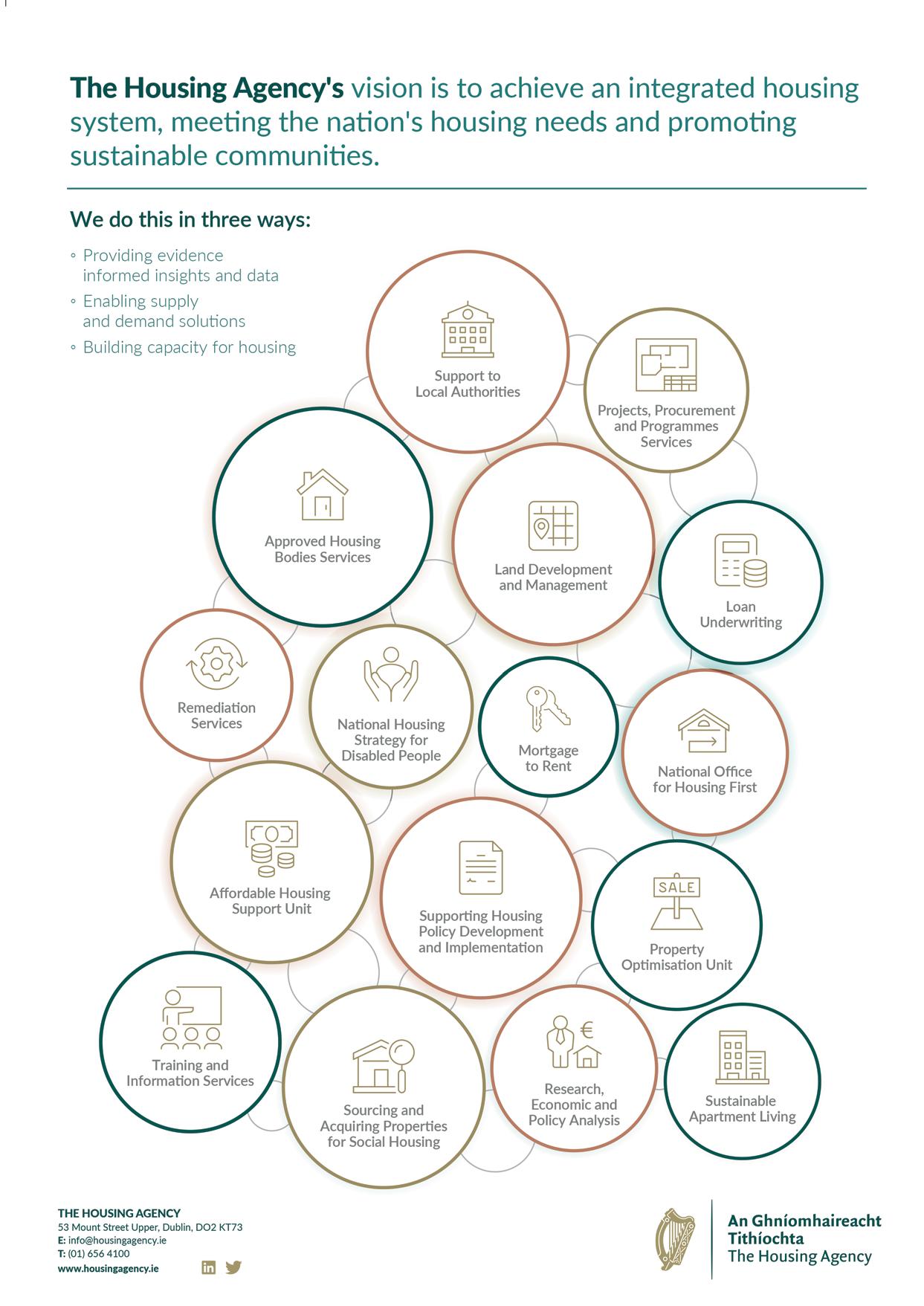Defined by delivery










































The 2023 edition of the Housing Ireland Magazine is the second since the publication of Housing for All, the Government’s housing plan. Launched in September 2021, it aims to provide 300,000 additional social, affordable, and private homes by 2030. Housing for All also sets out a range of initiatives to support social inclusion, eradicate homelessness, and to promote vibrancy within our towns and villages.
This plan represents a significant multi-year investment in the housing sector, targeted at increasing supply, improving affordability, and delivering high-quality homes in thriving communities. Considerable progress has been made. 2022 saw almost 30,000 completions, including the highest number of newly built social homes since 1975. In terms of affordability, the First Home Scheme, Local Authority Affordable Purchase Scheme, the new Cost Rental tenure, and Local Authority Home Loan are all assisting households to buy or rent homes at affordable prices. In addition, targeted, wellfunded schemes have been introduced to reduce vacancy and dereliction and create new opportunities to live in town and village centres.
However, since the introduction of Housing for All, the housing sector has also encountered challenges. Significant increases in construction costs and inflation have impacted the viability of housing projects. Additional skilled workers are needed to grow the capacity of the sector and maintain the upward trajectory in housing delivery. Ireland has also been responding to the urgent need to provide accommodation for Ukrainian refugees and a growing number of international protection applicants. This has meant that policies and initiatives have necessarily been revised and changed. However, progress is not linear. Being agile and adapting to change is an important part of the process.
Recently, The Housing Agency brought together over 300 housing practitioners from across Ireland for the Housing Practitioners conference in Limerick under the theme ‘Housing for all: Lessons from Practice’. A key focus was on showcasing the progress that has been made since 2021; the new houses and apartments that that have been built, the vacant properties that are now converted into homes, and the ways that the needs of different groups are being integrated into housing developments. It was also heartening to see the resilience of housing professionals in the face of new challenges, and their commitment to increasing access to high quality, affordable homes countrywide.

While it is important to meet targets and deliver on shorter-term goals, it is also critical that we work toward a long-term vision that is grounded in providing a good quality of life. Creating and supporting sustainable communities is a key element of this long-term vision. For example, many social housing developments built in the mid-century are now some of the most desirable locations for people to live. To continue to deliver high-quality homes and thriving communities, The Housing Agency would like to see the introduction of a sustainable communities policy to ensure future delivery is environmentally, socially, and economically sustainable and provides homes in communities people are proud to live in.
Bob Jordan Chief Executive The Housing Agency
Midway through the second full year of implementation of the Government’s Housing for All plan, Minister for Housing, Local Government and Heritage Darragh O’Brien TD sits down in his Leinster House office to reflect on the ubiquitous challenge of housing delivery with Ciarán Galway.
“We had a good year [in 2022],” O’Brien asserts reflecting on the number of homes delivered across several tenures, though he acknowledges: “Progress is being made but people are not feeling that yet.” As such, increasing supply, particularly in social and affordable housing, remains his greatest priority as minister, next only to eradicating homelessness. Despite considerable headwinds in the external environment, including construction cost inflation, the overall supply of homes is increasing. In May 2022, the Office of Government Procurement published guidance for parties to public works contracts to establish an Inflation Cooperation Framework, announced by thenMinister for Public Expenditure and Reform, Michael McGrath TD. Application of the framework includes a 70:30 burden sharing whereby the State
bears up to 70 per cent of the additional inflationary related costs.
“The work that Michael McGrath did with us [in 2022] in particular around the inflation framework, particularly in the public sector, was really important. That basically made sure that no scheme stopped. There was some stalling of schemes, but in fairness to the Minister, he acted very quickly.
“There is still a risk with the increase in funding rates; no question. That is the environment that we are living in in Europe and in the developed world too. We have to be nimble to respond to the outside environment which is there to make sure that our delivery is not decreasing because in other countries it is.
“All you have to do is look at other European countries; they have not had that type of response that we have
been able to bring forward. We are effectively plugging that gap by the State investing further in making sure that viability is maintained while we are seeing an increase in the cost of the price of funding.”
In total, 1,757 affordable homes were delivered in 2022 via The Land Development Agency, the First Home Scheme, and the new cost rental tenure. While this fell significantly short of the target of 4,100 new build affordable to purchase and cost rental homes, the Minister emphasises that a further 3,400 affordable homes have been approved across a 43 specific projects across more than a dozen local authorities.

“We delivered affordable homes for the first time in a generation in 2022,”

O’Brien recounts, adding: “No, we did not hit the target and that is something which is perfectly within people’s right to criticise – as they do, and do regularly. At the end of the day, we have a serious footprint now of affordable homes, of social homes, and a really good pipeline to 2026.
“I am confident that we are going to exceed our target [in 2023]. I am not going to give you a figure, but I am confident that we are and that is across all segments of housing, public and private. They all interconnect with each other, and I do not even like making the distinction between them because there is no distinction in quality and there is no distinction in design. For me, that is what we are focusing on.”
In 2022, government had a target of delivering 9,000 new build social homes. Ultimately, 7,433 were delivered, missing the target but still delivering the greatest number of new build social housing since 1975.
Dismissing any suggestion of disappointment, the Minister instead points to the headline target of the delivery of 10,500 social homes in 2022, of which 10,263 were delivered, and a pipeline of 19,000 social homes which are now either onsite or at design and tender stage.
“Delivery still fell short, and this is not an excuse but there was a genuine reality post-outbreak of the war in Ukraine that we lost between eight and 10 weeks with inflation. When inflation spiked, there was a lot of concern around viability,” he recalls.
“Supply chain was an issue, so it delayed schemes. Even in a really tough year – and this was the first year post-Covid that we had our overall target of 10,500 – we delivered 10,263 new social homes through all delivery schemes. If you take the 7,500 new build social homes, that was up from 5,000 [in 2021]. That is a big step up. I would love to be sitting here saying we did the 9,500 one but there is also a reality that was there which we had to deal with. By any fair assessment, that was a very good performance [in 2022].”
Writing for eolas Magazine earlier in 2023, the Minister alluded to work being undertaken by the Government to examine how to significantly expand the direct delivery of cost rental homes by local authorities.

Acknowledging the “massive opportunities” of cost rental as a new tenure and elaborating on the extra measures to enhance delivery under Housing for All agreed by government in April 2023, O’Brien reveals: “We will also be making some very significant announcements shortly on some very large cost rental schemes through our local authorities and our approved housing bodies. I think we can scale that up in the hundreds very quickly.
“What this is focusing on is quite a lot of extant planning permissions there that have not been activated there. There are potential developments that might have been identified for rent and now what I am saying is to get them in to be built for cost rental. We will have some good news very shortly on that.
“With cost rental, I am approving schemes every week. I want more local authorities to get directly involved and they are responding to that. That is why we have made some changes to the workings of the cost rental scheme and the final changes will be out in July [2023] and that will help very much with viability. While local authorities can borrow at a lower rate, the LDA is borrowing at commercial rates, but through Project Tosaigh now we will have a number of schemes –particularly on the cost rental side –that will encompass all important
stakeholders and we will make some important announcements in the coming weeks on that.”
Commenting on the specific and ongoing challenges to delivery, the Minister emphasises those associated with the planning system. “There are barriers on planning, still, to be frank,” he observes, adding: “That is why I have brought forward the consolidated Planning and Development Bill 2022 which will go to the Oireachtas shortly.”
Describing the forthcoming legislation as “the biggest overhaul of planning that we have seen in probably 50 years”, its rationale is, he outlines, to ensure that the planning system “is fit for purpose” whilst facilitating public participation in the process.
“There is a reality though that in certain areas where we have seen strategic objections. Objections do hold up housing delivery. I have no difficulty with people making their views known or not being happy with a development and doing that but the continued recourse to the courts is a matter which is of concern to me,” O’Brien remarks.
While the planning process can be streamlined, the resourcing of An Bord Pleanála is an additional challenge. “I have beefed up An Bord Pleanála. The
“I have never had a difficulty and absolutely stand by my support for homeownership because it is an honest and just aspiration for people to have.”
Minister for Housing, Local Government and Heritage, Darragh O’Brien TD
board was a big problem [in 2022]. I think we all know that. It dropped to as low as five board members; we now have 15 in place, the highest amount ever,” he states.
Though with its interim chair set to depart on 2 September 2023, the Minister pays tribute to the role she played in bringing stability to the planning body. “Oonagh [Buckley] has done a great job there in stabilising the ship. We have great staff on the board. I have approved a total of about 300 posts there, so we have significantly more people in An Bord Pleanála than we have ever actually had.”
Much of Housing for All is defined by an ambition of increasing homeownership. Indeed, the first of its four pathways is the ‘Pathway to Supporting Home Ownership and Increasing Affordability’. “The breadth of ambition in the plan will help to stop and reverse the decline in homeownership and break the rent trap that so many people are caught in,” Minister O’Brien wrote in his foreword, adding: “[Housing for All] puts forward a new vision that places homeownership back in the hands of ordinary working people.”
However, between census 1991 and census 2022, the rate of homeownership has declined from 79.3 per cent to 66 per cent. Most recently, despite having an outspoken advocate of homeownership in the ministerial portfolio since 2020, homeownership continued to decrease by 1.6 percentage points between 2016 and
2022 and according to CSO data, the median age of a first-time home buyer is now 39 years old.
“The reduction of homeownership has happened since 1991,” O’Brien responds, arguing: “The recent census shows that there has been no real decrease over the last five years. It is pretty much static. That is good and we have reversed that decline. [2022] was a good year because around half of new build homes were bought by firsttime buyers.”
Commenting on the First Home Scheme, the Minister disparages Oireachtas opposition claims that the shared equity loan scheme will ultimately contribute to house price inflation and effectively become a second mortgage after year six.
“[The First Home Scheme] works and it works because it is basically the State moving forward with direct assistance to buy a home with us taking an equity, not a second mortgage. The expansion of the Help to Buy scheme has been helpful too,” O’Brien suggests.
Highlighting the findings of Generation Rent, Threshold’s annual tenant sentiment survey for 2023, the Minister explains that only 20 per cent of respondents were renting out of choice, while 60 per cent want to own their own home and renting out of necessity.
In 2023, to date, there have been more commencements and more completions, more Help to Buy applications and approvals, and more First Home Scheme approvals than ever before.
“I have never had a difficulty and
absolutely stand by my support for homeownership because it is an honest and just aspiration for people to have. Thankfully, the Help to Buy scheme and the First Home Scheme is helping people to do that. We have seen a good year for first time buyer activity and people buying homes. That is where you need the intervention now,” he says.
Discussing the myriad initiatives which have been launched under the auspices of Housing for All and his stewardship at the Custom House, the Minister acknowledges a prevailing critique around the complexity of the various schemes. However, he is certain that this blend is necessary to tackle such an entrenched crisis.
“There is no silver bullet on housing. Some may present it like that, but there is not. That is why you need a multitude of responses to tackle it. If you look at the financial interventions that are needed, you need different interventions and you need to be flexible to be able to respond. You can plan forward, but if you have a rigid plan, that will not deal with the external headwinds that you will encounter.”
Having introduced the temporary winter eviction ban for winter 2022/2023 to much adulation on 30 October 2022, the Minister then faced ferocious criticism when lifting the ban from 31 March 2023.
“The ending of the eviction ban was not an easy decision, but I still believe it was the correct one,” he insists, adding: “We have to be aware – and I am acutely aware – that any measure that I take need not lead to further loss of property within the private rented sector because whether people like it or not, we need a private rented sector.”
While admitting that the current private rented sector is dysfunctional, he adds: “The last thing I want to see is a mass exodus of good landlords out of the market. People at various different stages of life do want to rent. It was the correct decision; it was a tough decision, but it was the right one in the long-term interests of our country and our people most particularly. If we continued with a cycle of full eviction bans in this way, I just think that more and more landlords would have sold up.”
“There is no silver bullet on housing. Some may present it like that, but there is not. That is why you need a multitude of responses to tackle it.”
Asked whether we will see another eviction ban in winter 2023/2024, O’Brien is adamant: “No.”
As part of a suite of measures to protect renters following the lifting of the eviction ban, the Minister announced that he would provide private tenants in situ with first right of refusal to purchase a property if a landlord subsequently put it forward for sale.

Listed under “legislation for priority drafting this session” within the Government's Legislation Programme for summer 2023, the status of Residential Tenancies (Right to Purchase) Bill 2023 was most recently recorded as “heads in preparation”, though the O’Brien previously insisted that the Bill must be enacted before the summer recess.
Asked if this timeframe would be met, the Minister responded: “I hope so. We are working towards that. The drafting is well advanced. I will be seeking cooperation from others about how we can expedite that legislation through the house.
“I want it to be as least a complicated mechanism as possible, so I think that it will be a good thing that it comes from a difficult situation.”
As of May 2023, Department of Housing figures indicate there was a total of 12,441 people accessing emergency accommodation in the State, including 3,699 children. This total represents an increase of 2,116 more people when compared with May 2022, and an increase of 182 when compared with April 2023.
Asked whether this was a consequence of lifting the eviction ban, the Minister indicates that the figures will be assessed but concedes that “certainly some elements of that will be”.
“There is no question – I am not hiding behind it – that some people have come out of the private rented sector and cannot find somewhere to live.
When I brought in the temporary moratorium on evictions, I said that we could use that as a space to deliver more properties. We delivered 6,000
more properties in that time; new properties. We secured additional tenancies. We actually have about 27,000 new tenancies created in the first quarter of [2023].
“This is not to diminish the difficulties faced by those people [experiencing homelessness] in any way. I chair the National Homeless Action Committee and all the members work really well together. However, there were those who tried to catastrophise the situation by trying to equate the notices to quit to a similar amount in evictions. It does not equate.”
Acknowledging that homeless numbers are “still too high”, the Minister commits to the continued publication of quarterly reports. However, he also notes that homelessness is not only being exacerbated by the dysfunctionality of the private rented sector, but also by new arrivals from the EU who “we are duty and morally bound to look after”.
“I make no distinction there at all. That is something that you cannot plan for. You cannot plan for if families come in from elsewhere and seeking emergency accommodation straight away. What we can plan for, though, and what we are doing is increasing supply and exiting more people now into permanent social homes than we have done before. That is the only way we get to grips with it.”
Further interventions in the private rented sector, he reiterates, “would have had a detrimental effect in both the short and medium term”.
Discussing the pressure of meeting Housing for All targets and ensuring that citizens and residents can feel the substantive delivery of housing across all tenures – social, affordable to purchase, cost rental, private rental, and private purchase – ahead of the next general election which must take place before March 2025, O’Brien exudes quiet confidence.
“I love the job; I really do. Every job has pressures regardless of what you are doing,” he insists, concluding: “It was an honour to be asked to do the job and it is a responsibility to take on. It is the one I wanted. I firmly believe – and it is not just a belief – we are making progress and we will be able to point to even more progress by the time the next election comes around.
“The election is happening regardless of what happens and that is a decision that the people will make. Supported by Micheál Martin, Leo Varadkar, Eamon Ryan, and my colleagues in government, my job is to deliver a step change in housing.
“I believe we have done that in a short space of time. We are doing that, and, actually, there is a bit of momentum building. There are some hurlers on the ditch who do not like to see that happening. Really importantly though, I am not thinking about elections. My job is to do my level best to drive the policy and implementation of our plan. That is what I am focused on doing.”
Beauchamps’ partner and head of its specialised housing team, Fidelma McManus, discusses cost rental housing, forward funding, and accelerating delivery of true mixed tenure schemes through collaboration.
Beauchamps LLP is a full-service law firm comprising commercial real estate, construction, banking and finance and public procurement lawyers. Its housing team is led by McManus, who, while primarily a conveyancer by profession, has significant experience in construction law, project delivery, and funding.
One of Beauchamps’ five real estate teams, the housing team is led by three partners – the other two being Caoimhe Banks and Conor McEvoy. With eight solicitors directly focused on housing and a significant number of lawyers, it is supported by a broader administrative team and lawyers from across the firm.

“In my team, we have honed housing specific skills under one umbrella,” she illustrates, adding: “This is what the solicitors who work on my team do day in and day out. They are expert commercial real estate lawyers with a focus on housing. While there are many competent lawyers out there, there are very few people who have the same level of expertise as the Beauchamps housing team.
“We undertake a lot of work with private sector developers, and this benefits our public sector clients because we understand the alternative perspective: projects must be funded, built, and delivered, and time is money.
“Whether acting on behalf of a public sector or private sector clients, we
understand the importance of delivery. Success is defined by delivery, and our role is to be a strategic partner in that delivery.”
Having operated through the Irish economic crisis and recovery, working on various solutions for housing delivery, the overarching priority of Beauchamps’ housing team is to “continue to be at the forefront of housing delivery, including projects that will make a real difference to Irish society”.
“When Part V of the Planning and Development Act was no longer delivering social housing because of a lack of construction, Beauchamps
became heavily involved in delivering the National Asset Management Agency’s social housing project through its subsidiary, National Asset Residential Property Services DAC.
“It was through this work that we began to act on behalf of several state agencies, including The Housing Agency, alongside local authorities and the approved housing bodies (AHBs). It was a very collaborative approach, which was essential because it needed to accommodate everyone. We built strong relationships with the AHBs, subsequently acting for several of them, especially around the time when their funding models changed, necessitating funding from third party lenders, particularly the Housing Finance Agency.
“We have been on the journey all along, but now housing is an all-pervasive discussion. As such, Beauchamps’ housing team has grown, as has its expertise,” McManus outlines.
While a relatively new concept in Ireland, Beauchamps has a significant focus on forward funding, primarily on behalf of AHBs. Traditionally, many housing developers pursued a forward sale approach and sought to profit from that sale.
However, with increasing viability challenges amid higher interest rates increasing the cost of funding, along with construction cost inflation, developers are now working collaboratively with AHBs to get funded along the way, meaning they do not have to carry the entire cost of funding. A contract for the delivery of a large scheme will tend to be a forward sale, whereby a purchase price is agreed in advance. This price is then paid in full once the scheme is delivered and acquired, with the developer having funded construction costs via traditional finance. A forward fund, meanwhile, is different in that the site is transferred before the build and then the developer is paid in stages throughout the build, incentivising completion.
While forward funding can be mutually beneficial, McManus indicates there is an increased risk for AHBs. They must be clear, she asserts, on their required deliverables, as well as the sophistication of their internal expertise to monitor project progress. AHBs must
also employ the right advisors – from planners to quantity surveyors, and lawyers – who understand the significance and associated risks of each step of the project.
“It is also important to have a board of directors that is willing to take on a level of risk with knowledge and understanding of the appropriate mitigations put in place to manage such risk and protect the public purse,” she explains.
“Effectively, forward funding provides more control over the end product and adds to the housing stock. This is an important delivery model because it does not include units that were going to be built regardless. While there is less and less speculative building in the current climate, Beauchamps has been working on this specific project model since 2017, with several AHBs involved, in particular Respond.
“A collaborative approach is essential if the requirements of public sector entities – which are acquiring property, development, or housing – are to be met. These requirements are distinct from those in the private sector, where commercial decisions are made based on investors and are for profit. Primarily, public sector clients are driven by delivery, while simultaneously they must meet criteria relating to exchequer expenditure.”
Across different jurisdictions, the affordable rental model has several synonyms. In Ireland, because of its evolution, it is known as cost rental. The Affordable Housing Act 2021 provided for several measures to enhance the delivery of affordable housing, including the introduction of a new cost rental tenure.
Aimed at providing secure, long-term rental properties at below market rents to those caught above the income threshold to access social housing and excluded from the open market to buy or rent, the government has committed to the delivery of 18,000 cost rental homes by 2030.
In April 2023, the government agreed to three extra measures under Housing for All. One such commitment is the allocation of up to €750 million via the Land Development Agency (LDA) and ‘other providers’ so that work can be commenced on cost rental apartments for which planning permission has been granted but has not been progressed. However, the details of how this cost rental subvention will work in practise have yet to be finalised. As such, AHBs have been disquieted by the ambiguity surrounding the definition of ‘other providers’.
“Whether acting on behalf of a public sector or private sector clients, we understand the importance of delivery. Success is defined by delivery, and our role is to be a strategic partner in that delivery.”
“Now, however, we understand that the ‘other providers’ will include AHBs. Perhaps the intention had been to keep this broad until it became clear as to how exactly the subvention would be delivered and to whom. Our understanding is that equivalent subsidies should be made available to AHBs. How they are made available, we do not know. There is a lot of ongoing discussion,” McManus advises.
In the short term, the Beauchamps partner identifies the LDA as an obvious partner for cost rental delivery, highlighting that the LDA is already acquiring and operating cost rental units from the private sector via Project Tosaigh.
To date, however, the cost rental tenure has yet to be delivered at scale in Ireland. The obvious benefits are that rents are maintained at least 25 per cent below the private market rents of a given locale and many people who qualify for cost rental tenures will eventually move on to home ownership. While McManus emphasises the prevalence of “high confidence and demand”, there are several challenges.
Unlike social housing, which has an underlying state-backed guarantee of
payment and an availability agreement with local authorities, cost rental is exposed to market risk. Against a backdrop of several recent black swan events, AHBs are particularly cautious.
“There has been a real worry that the cost rental housing delivery could exceed demand and AHBs that have borrowed money to deliver it will be left unable to repay because they are reliant on the private market. With cost rental, sums of money are secured by lending against an asset, and profit is limited because this asset must maintain reductions at least 25 per cent below market rent.
“Simultaneously, the cohort of people eligible to access cost rental is restricted to those whose net household income is below €53,000 per annum, while being diminished by increased migration to home ownership, which the government is supporting in tandem. Ultimately, the success of the cost rental tenure hinges on upfront public investment and our understanding is that recent government announcements will provide some further reassurance,” the Beauchamps partner indicates.
Currently, the ideal mixed tenure schemes that the Beauchamps housing team is observing include social, cost
rental, affordable for sale, private sale, and various other schemes to appeal to different cohorts of society, particularly key workers. These include focusing on mixed tenure schemes being delivered in other jurisdictions, such as by Homes England in the UK, which could be used to produce a model that attracts investment from outside of the State.
True mixed tenure incorporates each of these models on a single site. “Mixed tenure incorporates people from all sorts of socioeconomic backgrounds together in one community,” McManus asserts, elaborating: “This opens opportunities for social mobility.
Whereas when individuals are limited in the options that they can observe in their local communities, they are more likely to be restricted in their socioeconomic trajectory. It is a broader perspective, but the delivery of adequate housing is so important to the fabric of society.
“Going further, there is a disconnect in society if the average public sector worker – teacher, garda, or nurse, for example – cannot afford to buy their own home or, at the very least, cannot access an adequate secure property to rent long-term. We must ensure that these key workers have somewhere to live.”

Capacity is a major challenge across both the public and private sectors, but particularly in the public sector. The majority of homes that are currently under construction, including developments led by state agencies, are being delivered by the private sector. In this context, there is no option to not collaborate.
“Collaboration is the key,” McManus insists. “The key to unlocking housing is for the public sector to enter into agreements with developers to ensure entire schemes are delivered as social, cost rental and affordable homes. Several developers are experiencing planning challenges, but planning aside, there are many schemes with planning approval that could be delivered with the right strategy.”
For instance, a developer might strategise the delivery of an apartment scheme comprising three blocks. This may have included the delivery of one social block to an AHB or local authority, with the second and third blocks typically delivered to the PRS market. However, due to the cost of funding and international funding going elsewhere, that PRS route is blocked. Similarly, the long-term leasing model is no longer on the table as an option.
“Now there is a real hope and expectation that the AHB, which would have taken the first block for social housing, could also take the second block as cost rental. However, AHBs will require further reassurance as this approach changes their risk profile. I am hopeful that the government’s commitment to additional funding – in whatever form it takes – will be able to provide that reassurance. In other words, there would be an injection of money that would enable the AHBs to become more comfortable with the greater risk they perceive,” McManus suggests.
An option for the third block could then be an affordable housing scheme or, more specifically for apartments, the option of Croí Cónaithe, which would mean it could go to the owner occupier market with government supports for home ownership of apartments, which also include the options of the Help to Buy Scheme and the First Home Scheme.
“I am hopeful that developers attempting to deliver such an apartment scheme can discern a real strategy to do so in its entirety. It is a deviation from what might have been originally envisioned, but it has significant public backing.
“There is no doubt that in the short to medium term, the public sector is going to be a collaborative partner. Builders and developers in this space are beginning to come to this realisation. Beauchamps is acting for a wider spectrum of clients who are seeking to understand how this might work in practise.”
In the last 18 to 24 months, the number of builders and developers working collaboratively with the public sector –whether AHBs, local authorities, The Land Development Agency, or The Housing Agency – has increased significantly. People who were not traditionally active in this space have gotten involved, resulting in enhanced delivery of projects.
“The public sector has always been amenable to this collaboration and there is significant opportunity in this sphere. Indeed, most schemes will have some degree of public spending, including fully private schemes that have a Part V social housing element. A majority now also have a First Home Scheme or Croí Cónaithe element at a minimum.
“However, several developers are going
further, consciously developing forward fund models, or equivalents, specifically for AHBs or local authorities. In many ways, this is a more certain path to delivery in what is a relatively uncertain market, with omnipresent challenges relating to delivery to multiple private sector end users,” McManus observes.
The head of housing also observes an enhanced awareness among builders and developers. “In my experience, once a developer or a builder completes an initial project with a public sector entity, or an agency that is primarily funded by the State, repeat collaboration is common. They learn from the experience and can apply it to the next project.
“That applies to all of the professionals advising each of the parties as well, be they agents, quantity surveyors, design teams, lawyers, accountants, and all
these people. Once they see deals being delivered and returned, they can leverage the experience for subsequent deals.”
Meanwhile, McManus’ vision for the Beauchamps housing team is to grow its expertise and ensure that it “continues to be the leading housing practice in the State”. “We have already expanded our expertise in construction and funding, but we want to go further in the regulation space. Another area of particular focus is the merger of AHBs, which, as a consequence of the Housing (Regulation of Approved Housing Bodies) Act 2019, is going to become more prevalent. We would love to see more delivery in that space and contribute to greater efficiency. There is always a better way,” she concludes.
Fidelma McManus is a partner with Beauchamps LLP and heads up its specialised housing team. She is the go-to expert in complex conveyancing and an acknowledged market leader in the acquisition and management of social and affordable housing. Her practice includes all aspects of conveyancing including the acquisition, structuring, financing, disposal, and leasing of all types of property, including multiunit developments, distressed and partially complete residential developments, shopping centres, retail parks, and offices. McManus also advises on landlord and tenant law. In particular, she works closely with local authorities, state agencies, charities, approved housing bodies, lending institutions, pension funds, sporting bodies, receivers, and developers, including institutional and private investors. The Beauchamps housing team has been recognised for its contribution to Irish society, securing the Public Sector Excellence in Business Award for housing services for five consecutive years.
“The key to unlocking housing is for the public sector to enter into agreements with developers to ensure entire schemes are delivered as social, cost rental and affordable homes.”

Just under 30,000 homes – 29,851 in Housing for All progress reports compiled by the Department of the Taoiseach and 29,822 in Central Statistics Office (CSO) data – were completed in 2022, exceeding the Housing for All target for the year by 21 per cent and proving correct the Government’s assertion during the year that there was a “strong pipeline” for housing in 2022. With 20,433 homes completed in 2021, an increase of 20.16 per cent in new home completions was required for the State to reach its 2022 goal. An increase of 46.1 per cent was recorded, a rate that eclipses the high of 45.51 per cent recorded during the 2010s as the construction industry began its recovery from the very low completion numbers seen at the beginning of the decade.
The statistics will have been welcome news in government circles, with 2022 having been the first year under Housing for All that contained an annual target. Within these figures was further good news for those who stress the need to move towards scheme and apartment building in Ireland; when compared with 2019, the last year with construction unaffected by Covid-19 before 2022, increases of 20 per cent and 163 per cent were seen in scheme house and apartment completions respectively in 2022. In 2021, single home developments – the only other category of home collated in CSO data –accounted for 23.04 per cent of new dwelling completions; in 2022, that share fell to 18.5 per cent.

As recently as 2016 and 2017, this rate stood at 36.9 per cent and 29.64 per cent respectively.
All but three of the 31 local authority areas saw an increase in completions in 2022, with the largest
homes
Total housing completion figures for 2022 show that the State exceeded its target for new homes by over 5,000 homes, a positive sign as the Government seeks to revise targets set under Housing for All.Credit: William Murphy
increases coming in Wicklow County (107 per cent), Dún Laoghaire-Rathdown (98 per cent), South Dublin County (85 per cent), and Dublin City (84 per cent), and the decreases coming in Carlow County (8 per cent), Roscommon County (14 per cent), and Leitrim County (21 per cent). The counties with the highest ratio of completions per 1,000 people were Kildare (10.6), Wicklow (10), and Meath (8.5), while the counties with the lowest ratios were Tipperary and Roscommon (both 2.6), and Leitrim (two).
There will be cause for concern at the decrease in residential construction commencements that occurred simultaneously to the increase in housing completions. While commencements dipped in 2020, largely due to Covid-related restrictions on construction activity, they saw a large recovery in 2021, but 2022 saw a 12 per cent decrease in the number of new units that began construction. 30,724 new homes were commenced in 2021, as compared to 26,957 in 2022. Further emphasising this worry will be the CSO’s index of residential building production, which decreased throughout 2022. Using 2015 levels of construction as 100, the index recorded Q4 2021 as 132, but this figure fell consecutively in the first three quarters of 2022 to 125.6, 120, and 106.9, before rebounding to 112.2 in Q4. Q1 2023 shows another quarterly increase to 120.2, although this is an annual decrease.
The target for completions in 2023 as set out in Housing for All is 29,000, which would mean that the level of completions would simply need to maintain from 2022, but the decrease in construction activity during 2022 casts the possibility of that happening into doubt. However, the latest available CSO data shows

there to have been 6,716 new dwelling completions in Q1 2023, a 19.1 per cent increase on Q1 2022.
Q1 is typically the quarter that shows the lowest construction activity per year; in the 13 first quarters from 2011-2023, it showed the lowest number of dwelling completions in nine. Completions in Q1 2022 accounted for 18.9 per cent of total completions in 2022. If this rate were to be repeated throughout 2023 based on the Q1 2023 total of completions, a total of 35,534 new units would be completed during the year. Whether or not enough projects have been commenced to support such a rate of construction remains doubtful, with it left to be seen in the second half of 2023 how the slowdown in activity in 2022 will affect delivery.
The Government’s latest progress report for Housing for All, covering Q1 2023, shows that 12 of the 23 actions due for delivery in Q1 2023 have been delayed, some into 2024. Notable amongst the actions delayed are: the exploration of the scope for the Housing Agency Acquisition Fund to add to social housing stock by converting non-residential or larger residential units into smaller residential units; a review of the Rental Accommodation Scheme; the issuance of updated guidance on rural housing; legislating to increase the borrowing capacity of the Housing Finance Agency; and the development of new regulatory controls for short-term and holiday lets.
Notable actions due in Q1 to have been implemented on time include: the revision of social housing income limits to a maximum of
€40,000 per annum; the submission of a report to government by the Land Development Agency (LDA) on relevant state lands in the LDA’s public land database; the introduction of a new programme for the compulsory purchase order of vacant properties for resale on the open market; and a review of the Rural Regeneration and Development Fund.
Central to the implementation of the Government’s housing reform will also be the forthcoming revision of the National Planning Framework, which the progress report states has been commenced. It is expected that the completion targets within Housing for All will be updated in the revision in order to better reflect the housing need of the State’s growing population.
Speaking in June 2023, Taoiseach Leo Varadkar TD said: “We will have to revise upwards our annual targets for housing completions. We are at 30,000 a year now. Much more is achievable… I would like to see us ramping up as fast as we can. The current target is to get to 40,000 before the end of the decade. I think we are at 30,000 now, surely we can get to 40,000 sooner.”
As part of the implementation of Housing for All, the Government carried out a review into the structure and operation of the Capital Advance Leasing Facility (CALF), the results of which were published in March 2023. CALF, when combined with Payment and Availability (P&A) funding, is the State’s primary funding stream for the
delivery of social housing and the Government stated that the review was carried out to assists the approved housing body (AHB) sector to deliver its 45 per cent share of the social housing targets within Housing for All The review returned six recommendations: the discontinuation of the limiting of initial P&A amounts to a percentage of local market rent, with the initial P&A amount now to be calculated on a debt-service cover ratio target; the establishment of a departmental working group to explore gearing issues with AHBs; the exploration of options for early repayment of CALF loans; the retention of CALF loans as repayable loans; the establishment of a direct link between applications for P&A-CALF support and the housing delivery action plan of a given local authority; and that the definition of when a project funded by P&A-CALF is delivered to be revised to once the sale has taken place and utility connections are in place.
The hope within the AHB sector will be that these proposed reforms will engineer an uptick in social housing delivery, which is needed; despite 2022 targets being exceeded, the 9,000 target for social housing new builds was missed, with 7,433 delivered, meaning that the deficit in social homes and the overall surplus were made up by the private sector.
Despite that, this figure represents the highest number of new-build social homes built in one year since 1975 and a 43 per cent increase from 2021. With 9,100 social new-builds due for delivery in 2023, the sector will be hoping that such an increase and such reforms herald a new dawn in social housing delivery.
Social housing delivery
• Phased payments for social housing;*
• Joint application processes for social/affordable/cost rental;
• Additional four-step approval reform;
• CALF funding changes; and
• Social housing eligibility.
*Subject to EU procurement rules
Housing affordability, inclusion, and homelessness
• New affordable subsidy model for the LDA;
• New CREL model;
• New viability measures for inactivated planning permissions;
• Expand vacancy grant;
• Reviewing tenant in situ purchase schemes; and
• Homeless services eligibility issues.
Housing policy, legislation, and governance
Planning
• Consideration of eviction ban;
• Landlord taxation issues; and
• Potential housing referendum.
• Planning bill;
• ABP reform and resources; and
• NPF review, housing targets, and densities.
Water
Local government
• Support of housing delivery; and
• Potential referendum on water ownership.
• New Dáil constituencies; and
• Limerick directly-elected mayor.
There has been reasonable progress made against these high-level priorities, although the phrasing in the document makes it unclear as to what the specific target for each objective is. For instance, one measure proposed by the Department was “consideration” of an eviction ban. Although the Government did indeed consider this proposal, the outcome of this consideration – which was to revoke it – is immaterial when measuring the progress of the high-level priorities for the Department.
In the topics outside of housing itself, it can be reasonably argued that the Department has exceeded its targets, with work underway regarding the constituencies and TDs in the next Dáil, and progress being made on legislation for a Limerick mayor, with another proposal to hold a referendum for an elected Dublin mayor now being put forward by the Department.

At the beginning of 2023, the Department of Housing, Local Government and Heritage released its high-level priorities, listed in the table below and divided into categories.
We work mainly with the Department of Housing, Local Government and Heritage, local authorities, approved housing bodies, and other state agencies. Our strategic plan has been framed in the context of supporting the Government’s Housing Plan, Housing for All. There has been significant progress on the schemes administered by The Housing Agency, which has supported Housing for All through its four pathways:

Cost rental is a new housing tenure in Ireland, where rents are based on the cost of provision rather than market rents. The provision of Cost Rental homes is funded by the Government through fixed rate loans provided by the Housing Finance Agency and the Cost Rental Equity Loan (CREL), provided by The Housing Agency for up to 45 per

cent of the capital costs. CREL is a low-cost loan at 1 per cent simple interest that is not repayable under the end of the 40 year loan period. The first schemes were launched in 2021 at Taylor Hill, Balbriggan and in 2022 at Woodside, Enniskerry Road. A total of 607 cost rental homes (including 557 using CREL loans) have been delivered since the launch of Housing for All, with a further 528 scheduled for delivery up to 2024.
The Affordable Housing Fund (AHF) was
Founded in 2012, The Housing Agency is a state-funded body of housing specialists, with a strong focus on problemsolving. The Housing Agency supports the development of sustainable communities across Ireland.
introduced by the Department of Housing, Local Government and Heritage (DHLGH) to enable Local Authorities access funding to assist them to deliver affordable purchase and cost rental homes. The Housing Agency carries out an initial assessment of applications received from Local Authorities on behalf of the Department. In December 2022, the AHF was increased from a maximum of €100,000 per unit to €150,000 per unit for cost rental homes. To date over €249 million has been approved to assist in the delivery of 3,164 affordable homes from 2022 to 2027 under 52 schemes across 15 Local Authorities. A further 14 applications for assistance under the Fund are currently under consideration.
The Housing Agency plays a central administration role in the Government’s national Housing First programme. This programme targets individuals with a history of rough sleeping and long-term use of emergency homeless accommodation who also have complex needs around mental health and substance use. It provides them with direct access to a permanent home, together with intensive wraparound tenancy and health supports delivered mainly in the person’s home. It is over 85 per cent successful in ending homelessness for people who are long-term homeless.
Ireland’s Housing First programme is based on the Pathways Housing First programme, conceived by Sam Tsemberis in New York in the early 1990s. The Housing First National Office was established in the Housing Agency in March 2022 with Rob Lowth as National Director. It supports the delivery of Housing First by local authorities, HSE and NGOs and it monitors the achievement of the Housing First targets. A total of 879 Housing First tenancies were delivered by the end of April 2023.
The Housing Agency is playing a key role in the new Cost Rental Tenant inSitu (CRTiS) Scheme which has been in effect since 1 April 2023 to support tenants at risk of homelessness. The scheme is available where a tenant household faced the termination of their tenancy due to the landlord’s intention to sell the property.
The scheme is available if the tenant household:
• is not able to purchase the property from the landlord;
• is at risk of homelessness;
• is not eligible for, or currently in receipt of social housing supports (that is in receipt of HAP or in the Rental Accommodation Scheme (RAS)); or
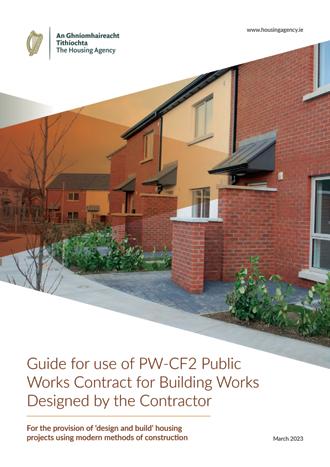

• has a net annual income of below €53,000.
If a tenant has a query about the Cost Rental Tenant in-Situ or the other measures introduced to assist tenants they can contact The Housing Agency by phone at 1800 000 024 or via email at tenantinsitu@housingagency.ie.
In November 2022, the Department of Housing, Local Government and Heritage launched the Youth Homelessness Strategy 2023-2025. The strategy sets out 27 distinct actions to prevent young people aged between 18 and 24 from entering homelessness, to improve the experiences of young people in emergency accommodation and to assist young people to exit homelessness.


The Housing Agency has been tasked with producing a guide setting out supports for young people exiting homelessness. The guide will bring together information on housing supports, social welfare benefits, financial supports, education, training and employment options and healthcare supports. In addition, The Housing Agency will be assisting the
DHLGH with developing a pilot model of a housing-led intervention, Supported Housing for Youth (SHY).
The SHY model will provide a range of accommodation options including shared accommodation and one-bed units with wrap around supports targeted to the specific needs of each person.
In March 2023, The Housing Agency published the Summary of Social Housing Assessments 2022, which brings together information provided by local authorities on households in their functional area that are qualified for social housing support but whose social housing need is not currently being met. The report found that the total number of qualified households for 2022 was 57,842. This is a decrease of 1,405 from 2021 and a decrease of 57 per cent from 2016 (91,600) when the series commenced.
The Croí Cónaithe (Cities) Scheme is administered and managed by The Housing Agency. It is a new fund which aims to help kick-start the construction of apartment schemes and support the building of up to 5,000 apartments for sale to owner-occupiers by 2026. A key national policy objective is to build more homes within our cities and towns, resulting in compact growth and vibrant, liveable cities. The scheme aims to bridge the current ‘viability gap’ between the cost of building apartments and the open market sale price. It specifically targets un-
commenced apartment developments in our cities. The Croí Cónaithe Cities Scheme also has the benefit of operating in conjunction with other initiatives such as the First Home Scheme and the Help to Buy (HTB) scheme.
Following an ‘open book’ assessment of proposals, the Housing Agency will enter into its first agreements with developers very shortly. In the summer of 2023, the Croí Cónaithe Cities Scheme will advertise for a second call targeting the activation of existing planning permissions for apartment developments over four-storeys.
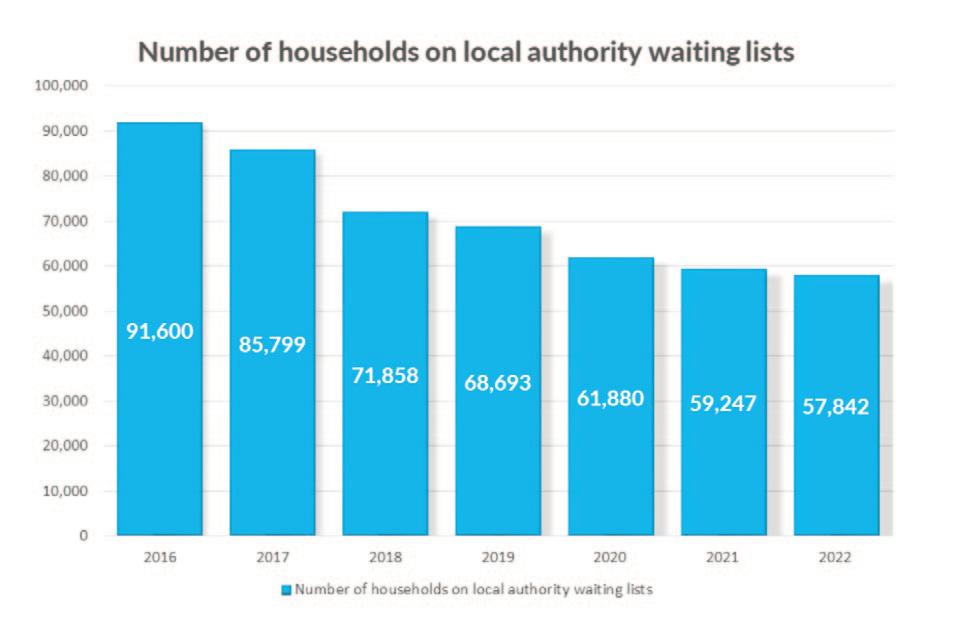
More information can be found at: www.housingagency.ie/CroiConaitheCiti es
The Payment and Availability (P&A) and Capital Advanced Leasing Facility (CALF) funding model has been revised following a review carried out in response to a commitment in Housing for All. This is the main funding scheme used by the Approved Housing Body (AHB) sector to provide social housing. The revised model addresses financial viability issues in rural areas and will help the sector overcome challenges caused by construction inflation and interest rate rises. The Housing Agency’s AHB Services Unit assists AHBs with P&A-CALF project queries
and carries out financial appraisals of funding applications from AHBs on behalf of the Department. In the period since September 2021, the team has assessed applications for P&A-CALF funding for new projects to deliver more than 5,200 homes.
The Housing for All plan makes provision for innovations to improve, support and accelerate delivery of housing. In support of this strategy, The Housing Agency Procurement and Delivery Unit will supply technical services and supports in modern methods of construction. It has also developed a Guide for use of PW-CF2 Public Works Contract for Building Works Designed by the Contractor. This guidance document encourages the use of Modern Methods of Construction through the use of Capital Works Management Framework.
The Housing Agency has received funding from the European Commission under the Technical Support Instrument (TSI) for a reform support project titled ‘Renovation Wave – Advancing retrofitting in multi-apartment buildings’. The project will commence in Q3 2023 and aims to increase energy
performance of the Irish multi-unit developments building stock due to retrofitting. The project intends to establish effective models in Ireland for the advancement of whole-of-building retrofitting in multi-unit developments and create a high level of awareness of the models and frameworks across a wide range of stakeholders.
The Housing Agency has a role in addressing vacancy through our central advisory service on compulsory purchase orders and providing advice to local authorities on the Town Centre First programme, which aims to combat vacancy and dereliction in towns and villages across Ireland. The Housing Agency is also involved in the administration of the Repair and Lease scheme, which aims to bring properties back into use for social housing purposes, and 380 units have been delivered under the scheme to date.
For more information, contact The Housing Agency at:
T: 01 656 4100
E: info@housingagency.ie
W: www.housingagency.ie
Twitter: @HousingAgencyIE
LinkedIn: www.linkedin.com/company/housing agencyie
Following the publication of the National Strategy for Disabled People 2022-2027, an implementation plan of some 107 actions has now been published.
The overall aim of the National Housing Strategy for Disabled People 2022 – 2027 aims ‘to facilitate disabled people to live independently with the appropriate choices and control over where, how and with whom they live, promoting their inclusion in the community’.

Developed as part of Housing for All, the strategy and subsequent implementation plan are to be delivered by the Department of Housing, Local Government and Heritage, the Department of Health, and the Department of Children, Equality, Disability, Integration and Youth.
The implementation plan contains 27 outcomes with 107 actions. A number of these actions contain multiple interim actions, with 25 actions underway and ongoing, and a number now complete.
The context of the implementation plan is action needed under the six themes of the National Housing Strategy for Disabled People 2022-2027, which are:
1. accessible housing and communities;
2. interagency collaboration and the provision of supports;
3. affordability of housing;
4. communication and access to information;
5. knowledge, capacity, and expertise; and
6. strategy alignment.
As well as detailing the actions that will be required to deliver on the outcomes and assigning those actions to identified stakeholders, the implementation plan also sets out indicative timeframes as well as key performance indicators for each of the actions.
Notable progressions to date include the publication of housing delivery action plans by local authorities in 2022, the plans were mandated to set out how dedicated social housing provision appropriate to the needs of disabled people will be delivered matching the scale and extent of housing need identified for people with a disability. Additionally, all local authorities now have a disability-friendly housing technical advisor, who provides specialist advice to the authority itself and to interested parties who want to get involved in providing disability-friendly housing.
Following the strategy’s publication, a national implementation steering group, housing and disability steering groups, national thematical focus groups, regional interagency groups, and bimonthly meetings of the dedicated disability personnel in local authorities have all been established. Housing and disability steering groups currently report quarterly on the implementation of their local strategic housing plans for disabled people to the Chief Executive and the Strategic Policy Committee.
Other additional actions which have been commenced include a national Mental Health Tenancy Sustainment Officer (TSO) Service, delivered through the AHB sector and an information and communications strategy delivered by the Housing Agency.
A formal review of the implementation plan has been scheduled to mid-2024 for completion by Q4 2024.
This review will ensure that the outcomes and actions from this plan are still relevant. The review will also set out the actions for the remaining term of the Strategy and develop new outcomes, if required. The Housing Agency will lead on this review and will present a draft to the tri-department group by the end of Q3 2024.
107 actions ‘to facilitate disabled people to live independently’

Following the publication of the inaugural Report on Relevant Public Land 2023, The Land Development Agency (LDA) hosted a round table discussion with key stakeholders from across the public and private sectors to discuss the delivery of affordable homes on state lands.


Firstly, one of the biggest challenges is getting access to the land in the first place. There tends to be a reason the land is unavailable; you may have a land-owning public service provider that uses it for a carpark or provides services that are not easy to move. Secondly, there is a disconnect between discourse and reality regarding the time required to get a housing project from greenfield to planning and from procurement to construction. There is a huge gap in the expectations of the public and politicians versus those delivering housing on the ground. There needs to be enhanced awareness of the realities of delivering housing.
Many of the lands that are easy to develop are already developed and those remaining now have challenges in terms of infrastructure and services. If we can overcome those, we can deliver homes. The other factor is that we are not just delivering homes; we are delivering neighbourhoods, communities, and safe places for people to live. It is not just a case of building a house.
Donald MacDonaldJohn’s point around development timeframes is pertinent. It is understandable that people who do not work in the housing sector ask why something is or is not happening. Those close to development know that it takes years. Projects that we worked on last year included a site acquirement in 2007. From a planning perspective alone, development takes a long time and people need patience. The LDA and other organisations must be given time to see their strategies come to fruition. The other problem is houses
versus apartments; apartments are much more complex to deliver and take even longer. There are also infrastructural issues that need to be solved, requiring all stakeholders working together. That is often unappreciated.
Fidelma
By the time Beauchamps gets the instruction to buy a site, roughly two years’ work has been completed. Even with planning granted and a clear exit strategy, it takes two years to develop. Many people do not appreciate this reality. Therefore, they believe that the LDA and other public bodies can build with relative ease and speed. While there are many positive stories of different models delivering in different ways, the negatives resonate more because it takes so long to deliver. For example, a new cost rental tenure has been introduced with much collaboration. However, these homes are only beginning to be built. Things do not happen overnight. Likewise, Croí Cónaithe is still bedding in, and we have yet to see delivery. Expectations must be managed accordingly.
Tom
PhillipsThe three challenges are planning, infrastructure, and viability. There is a lack of understanding around how long
table discussion hosted by
developments take once granted planning permission. Planning is always in flux and always changing. We currently have new planning legislation forthcoming that will change things again. Overall, the delivery of infrastructure should be analogous to Wayne Gretzky’s comment on skating to where the puck will be. In Ireland, however, infrastructure trails development. With the exception of the Cherrywood extension of the Luas, there has been limited infrastructure delivery ahead of housing development. Water, buses, and schools cannot be delivered under departmental or agency rules and then An Bord Pleanála cannot give permission to developments where the infrastructure is not in place. We must change our attitude towards infrastructure and put it in place for development to happen. With regard to viability, we need foreign investment, and must not be naïve enough to think we can do it alone.
Eddie TaaffeRedevelopment of state lands is not a single project; there is the also relocation of the services that are currently on the land. That is a distinct project even before approaching the risks associated with the redevelopment in planning and construction. If we consider the prime state land sites that should be redeveloped in our urban centres, they were originally built on the periphery and now we have developed around them. Trying to retrofit new developments into such areas is problematic. The reality must be faced that the occupiers of those sites are happy where they are, and the challenge is to get them to move. There is also the challenge around costs and when those are incorporated into delivery there is viability challenge. Having said that, across the State there is a recognition that the greater longterm cost is in not delivering now.

Fidelma
McManusOverall, the timeframes can be reduced by ensuring that all parties involved understand what is required from the outset. Each party must understand what the other’s exit is and the milestones, challenges, and timelines for getting to those exits. Looking holistically at each development, from 4
John Coleman
John has been Chief Executive of the Land Development Agency since its inception in September 2018. He previously held senior roles at Ireland’s National Asset Management Agency (NAMA), working extensively on the set up of its Residential Delivery division and was its Chief Financial Officer. John is a graduate of University College Dublin (BComm) and a chartered accountant (FCA). Prior to joining NAMA in 2011 he worked in banking and accountancy.

Aoife Lawler
Aoife is a civil engineer who has worked in both private consultants and in local authorities for over 25 years. She is currently working in Fingal County Council’s housing directorate responsible for delivering on the significant delivery targets for new homes. Her housing related experience includes the design of social housing schemes and halting sites in the National Building Agency, working for GOAL Afghanistan supporting internally displaced people to return to their homes, and, more recently, as SEO in Housing in Louth County Council delivering on the challenges faced by the Rebuilding Ireland Programme. In between she has delivered large scale water and wastewater infrastructure in both Dublin City Council and Fingal County Council and as a volunteer with the EU Election Monitoring program.
Donald MacDonald
Donald is a multi-disciplined real estate professional with 24 years wide-ranging experience including planning, property design and development, capital markets, valuation, disposals and property management, real estate lending, financial accounting, and auditing. Donald is a director in Hooke & MacDonald where he has worked for over 15 years. Working on a range of client requirements, Donald is a member of the Hooke & MacDonald team that has advised on over €3 billion in residential development and investment transactions over the past seven years and currently manages over 3,700 residential properties across the Greater Dublin Area mainly for long term institutional investment clients. Donald is a fellow of Chartered Accountants Ireland, has a master’s in planning and development and is an executive board member of the Urban Land Institute (ULI) in Ireland, and an active member of the ULI European Urban Regeneration Council.



Fidelma McManus
Fidelma is a partner with Beauchamps LLP and heads up its specialised housing team. She is the go-to expert in complex conveyancing and an acknowledged market leader in the acquisition and management of social and affordable housing. Her practice includes all aspects of conveyancing, including the acquisition, structuring, financing, disposal, and leasing of all types of property, including multiunit developments, distressed and partially complete residential developments, shopping centres, retail parks and offices. McManus also advises on landlord and tenant law. In particular, she works closely with local authorities, state agencies, charities, approved housing bodies, lending institutions, pension funds, sporting bodies, receivers, and developers, including institutional and private investors.



Tom Phillips
Tom is Managing Director of Tom Phillips and Associates, and a town planner and urban designer. He formerly worked for the international firm of architects, Terry Farrell and Company in London, and for the Irish Architectural Archive. Tom is adjunct associate professor in the School of Architecture, Planning and Environmental Policy in UCD (where he has lectured part-time since 1993), and is a council member (and former chairman) of Property Industry Ireland. Tom is a member of the Royal Town Planning Institute and a fellow of the Irish Planning Institute.
Eddie Taaffe
Eddie is a chartered engineer and fellow of Engineers Ireland. With over 25 years’ experience in civil engineering and project management with local authorities, in 2020 he was appointed programme coordinator with the Housing Delivery Co-ordination Office (HDCO) established within the Local Government Management Agency. The HDCO’s remit includes co-ordination of social and affordable housing delivery by local authorities in accordance with the Government’s Housing for All plan. Recently the offices remit was extended to include coordination of the Energy Retrofit of 36,000 Local Authority owned Social Houses by 2026. He has previously worked in planning, housing, roads, water services, and infrastructure delivery roles in several local authorities including Wexford County Council and South Dublin County Council.
infrastructure to planning and delivery, each party must also be flexible. For instance, developers must have contingency plans and be aware of funding options in advance of encountering obstacles.
Eddie
TaaffeIf we narrow it down to redevelopment of existing state landholdings, the single most important document to initiate a project is a letter of consent for planning. Several years are required then to finish designs and enter planning process proper. The letter of consent begins the process and buys time to establish the other
requirements. Often in this country, however, we are guilty of approaching projects sequentially. Instead, as far as it is feasible, we must undertake them in parallel. The more time spent figuring out a project’s critical path, the more efficient its delivery.
Tom
PhillipsDuring the Celtic Tiger and subsequent recession, many people opted for alternative study pathways rather than construction-related disciplines. Today, there is a 10-year lag in the associated skills capacity across both the public and private sectors. In particular, this has been a challenge for An Bord


Pleanála; there is only person on their board who was on it a year ago, out of 15. Constant changes in personnel delays projects as per the Central Mental Hospital where there was a gap of several months between the issuing of the inspector’s report and An Bord’s ultimate decision. A properly resourced planning system must be in place for timely decisions. A more obligationbased approach would be better than an objectives-based one.

Donald
MacDonaldPlanning is a major challenge as anyone who works in the housing sector knows. Perhaps the forthcoming planning legislation will move things on but currently, planning in this country is far too complex. The amount of paperwork required for projects within existing standards is impeding progress. While we need a rigorous planning system, we are getting lost in the detail and are unable to deliver housing as a result.
Aoife Lawler
I agree with the comments about the challenges relating to resources and expertise. Consequently, we are competing for the same cohort of talent, and though there are observable improvements, it remains a challenge. However, local authorities are good at forward planning, land banking, and delivering infrastructure for the future. As a sector, we are now planning for 2028 and 2030 rather than 2023 or 2024 because those are already at hand.
John Coleman
When considering the length of time required to take a site to completion, we sometimes focus on the build period and how we can shorten it, but that does not substantively move the dial in the larger scheme. Even with planning reforms, reductions in timeframe will be
“There is an argument that policymakers are delivering policy for a generation that does not necessarily want home ownership. Obviously, people should be able to own their own homes if they are able to do so, but that should not be the primary objective.” Fidelma McManus
“There is a huge gap in the expectations of the public and politicians versus those delivering housing on the ground. There needs to be enhanced awareness of the realities of delivering housing.”
John Coleman
a matter of months. When must consider timespan holistically. For instance, the largest social and affordable scheme in the State at Shanganagh has been talked about for years and is only now being developed now. The overall timeframe beyond the build and planning periods must shorten, and, in that respect, Eddie’s point about approaching projects sequentially resonates with me.
Eddie TaaffeAs former director of planning in South Dublin County Council I find the narrative that planning is the problem tiresome. Everybody agrees that we need a robust planning system, so we cannot say that it is the problem. 93 per cent of applications in this country are successful. There are two things that must be clarified. Firstly, we must determine what constitutes a cast-iron environmental assessment, and secondly, we must introduce certainty into the timeframe. If a planning application is made, local authorities are statutorily bound to make decision within a specific timeframe. However, beyond that system, there is no certainty. These are the specific elements of the planning system which do not work.
There must be greater long-term policy consideration. Consider the archetypal discourse around Dublin Port and why the LDA does not build housing there; the response from Dublin Port Company, justifiably, is that Dublin needs a port, and it makes sense to have it located where it is. Unless we are prepared to spend billions to move a port, that is the end of the discussion. However, with long-term thinking, it would be possible to consider what Ireland’s maritime policy is within broader transport policy. In that scenario, it may be possible to plan for a project as significant rather than ignoring it because it is not going to happen in the immediate term.
Fidelma McManusLong-term planning is atypical in the
public discourse; it is not widely understood that people like Aoife are already working ahead to 2030. The projects being undertaken by the LDA are not only important for the delivery of housing now but also for the establishment of communities and societal wellbeing decades from now. From my perspective, an easy win would be to utilise available public land to deliver housing near public services such as hospitals and schools. Simultaneously, having observed using the example of mixed tenure schemes in the UK, it is possible to deliver affordable housing schemes that are developed specifically for key workers, alongside schemes for elderly renters, and households that are downsizing.
Eddie Taaffe
On the point of long-term planning; one of the major hospitals in Dublin demolished its accommodation block to build a car park. That is a stark reminder of the lack of long-term strategic vision for housing and indeed for sustainable transport.
To what extent has the LDA’s first Report on Relevant Public Land contributed to the national debate on public land use?
Eddie Taaffe
At local authority level, the development plan process succeeded
in determining the correct use of public land and state-owned land. Now, however, the LDA’s report has elevated the debate to a more strategic and national level.
Donald MacDonald
It is an amazing report. In our business, we regularly condense a significant amount of information about a particular property into a user-friendly format. When I read the Report on Relevant Public Land, it is apparent that the LDA team has been undertaking a similar task on much larger scale and to the extent that a newcomer to Irish housing could read it and gain a comprehensive understanding. There is so much value in the report and it will be up the various actors across the State to utilise it.



Aoife Lawler
There are many facets to this discussion, however, there is a preoccupation with home ownership rather than providing liveable and sustainable lifestyles and communities. The conversation must reorientate towards everyone having a home rather than everyone owning a home. Having a home includes renting adequate accommodation at an appropriate price. It is only after everyone has somewhere to live that we can then move on to private ownership. A component of this is working and living on the same site. 4
“The public sector must incentivise the private sector to participate in the development of affordable homes. A major pillar of this approach is the recognition that public plans such as Housing for All must be flexible.” Donald MacDonald
There is no reason why some state agencies could not continue to base their operations on an existing site while also accommodating housing.
Fidelma McManus

There is an argument that policymakers
are delivering policy for a generation that does not necessarily want home ownership. Obviously, people should be able to own their own homes if they are able to do so, but that should not be the primary objective. Previously, we observed affordable housing schemes
that did not work in this country because of the preoccupation with home ownership. Constitutionally, people want the right to own property, but like Aoife said, we must ensure that people have access to adequate housing first. Introducing a new housing tenure, such as cost rental, in a state is a massive achievement that has not received the acknowledgement that it deserves. Does it need to be tweaked? Of course, but it has introduced a viable alternative dimension to housing. People should be able to rent at a reasonable price and it would be a massive achievement if we could get this right – delivering cost rental at scale – for the eligible cohort, which includes but is not limited to key workers.
Tom PhillipsIt is a very useful report. Two things stand out. Firstly, the overall quantum is not going to solve Ireland’s housing crisis. The LDA can deliver 66,910 new affordable homes but the Housing Commission has determined that we must deliver up to 62,000 homes each year until 2050 to meet demand. Secondly, there are constraints. There is no instantaneous solution to the housing crisis. It takes time. Simultaneously, we must not assume that the State will deliver the solution in isolation. Overall, the report has demonstrated that the solution necessitates public and private partnership. The LDA is part of the solution rather than the whole solution, but it needs support, and it needs state agencies to understand that they must cooperate to deliver the solution.


 John Coleman
John Coleman
My overarching interpretation of the report is that it was very worthwhile because the housing discourse tends to be binary; it is everything or it is nothing. Like everything in life, the reality is that it is more nuanced. This also applies to the discussion around state land. Some narratives have suggested that the State has abundant land that can be immediately developed to solve the housing crisis. That was never the case. The Report on Relevant Public Land has injected a dose of reality into the discourse, outlining what is in the state land bank, the associated challenges, the operations that are underway already, and the difficult choices that must be made. After its publication, I participated in a radio interview during which the interviewer asked if I was disappointed in the report’s findings. My response was that
“A properly resourced planning system must be in place for timely decisions. A more obligation-based approach would be better than an objectives-based one.” Tom Phillips
“The conversation must reorientate towards everyone having a home rather than everyone owning a home... It is only after everyone has somewhere to live that we can then move on to private ownership.”
Aoife Lawler
it is a statement of fact. State land will contribute to the solution, but it is not a panacea, and understanding this is a healthy approach. In addition, it has increased the level of transparency around state lands and enhanced the public debate.

Donald
MacDonaldThe State, state bodies and AHBs can undoubtedly leverage the experience of the home development industry. For example, apartments are notoriously difficult units to build and rather than the public sector attempting to do it alone, there is scope for them to use their expertise in procurement and deliver avenues of funding for developers to then come in on the master plan. The public sector must incentivise the private sector to participate in the development of affordable homes. A major pillar of this approach is the recognition that public plans such as Housing for All must be flexible. The solution today may not be the solution in five years’ time and if we can ensure that plans are agile, then there is an opportunity to attract capital that does not come directly from government.

 Tom Phillips
Tom Phillips
In my involvement as an advisor to the Housing Commission, I have been deeply impressed by its ability to bring together people from disparate backgrounds to work together towards solutions and collaborate openly. It is worth noting that some of these people may be at loggerheads in their day jobs but are willing to openly collaborate because of a recognition that the housing crisis can only be solved by collaboration between the public and private sector.
John
ColemanCollaboration between the public and private sector was reduced post the 2008 financial crash as it became difficult for the two sectors to work together. Thankfully, that has reversed somewhat and things like the Housing Commission have helped to knock down barriers. The private sector are very important delivery partners. The assumption that the State could deliver alone is a dangerous one because you
would create linear delivery tied to the economic situation in the country and be doomed to continue the boom/bust cycle. The viability measures being considered for cost rental give cause for optimism, with a serious effort to assess attractiveness to the private sector.
Aoife Lawler
I recently visited an ex-military barracks in Paris which had been repurposed for the development of mixed-tenure housing which serves as an example of what we can achieve. Collaboration is already well underway. Fingal County Council has three schemes on site and more coming forward which are joint ventures with private developers to deliver homes.
Eddie Taaffe
In relation to delivery on State land, we have to move away from traditional employer design publicly procured projects. Currently, only a very small segment of the housing construction industry actually engages in the public procurement process and so we need to broaden that. To do so, we need to simplify the process utilising joint ventures and earlier involvement of the private sector. One of the barriers we need to overcome is a mindset of the public sector that they still know what is best when it comes to designing homes and capturing public demand. We need private sector involvement before the master plan stage and to shape their input into a public
procurement process. Importantly, private sector engagement will require certainty of pipeline. If the private sector can see a series of projects, then they will be much more inclined to engage.
Fidelma McManus
Capacity is an issue in both the public and private sectors. Yes, the public sector doing its own development of affordable housing would be ideal, and it is something we can work towards, however, currently, the capacity to develop housing rests solely in the private sector. Where a private developer is being engaged to deliver a project, they still need the assurance of a project pipeline if they are to ensure capacity. That ties into the delivery of funding models. My overarching view of the different models for housing delivery is that while new models are welcome, we should not be removing current models from the menu until we have proven improved replacements, otherwise, we are potentially reducing the number of homes being delivered and opportunities for foreign investment, which help underpin the bigger picture of increased housing delivery.
“Often in this country, we are guilty of approaching projects sequentially. Instead, as far as it is feasible, we must undertake them in parallel.” Eddie Taaffe
Respond is a leading Approved Housing Body in Ireland, directly managing the construction of social and cost rental homes. Through a forward funding model, Respond has successfully developed previously unviable sites, enabling the delivery of lifetime homes for people who need them.

The ongoing projects in Charlestown (138 homes), Sandyford (200 homes), and Long Mile Road (153 homes) serve as examples of Respond's approach. These developments not only provide affordable housing but also offer a range of amenities, such as green spaces, community centres and childcare facilities, to create vibrant and thriving communities. Respond has always recognised the importance of providing services in the community; it has 17 early learning and school age care services across the country, three daycare for older people centres, six family homeless services, refugee resettlement services and family support services.
By combining social and cost rental homes, these developments provide affordable housing options for a range of groups, including low-income

individuals and families, individuals with disabilities, older people and people who do not qualify for social housing but are unable to get a mortgage. This approach promotes social integration, ensuring that communities are built on a foundation of diversity and cohesion. Respond’s commitment to tenants extends beyond housing provision, as it offers on-site maintenance and tailored services, providing ongoing support to their tenants.
Over the past five years, Respond has commenced 3,347 homes with a value of just over €1.03 billion. It currently has 1,365 new homes under construction, with construction schemes ranging in value from €15 million to €65 million and total programme value in excess of €1.5 billion. Respond's inhouse property development team consists of registered architects,
quantity surveyors, planners, clerks of works, technicians, and project managers who ensure the successful delivery of lifetime homes for people who need them.
By strategically selecting locations in areas with high demand for more affordable housing, Respond, working with their statutory partners, is playing a crucial role in addressing the housing crisis and ensuring that individuals and families have access to safe, secure, and affordable homes. Respond collaborates with statutory partners including the Department of Housing, Local Government and Heritage, Local Authorities, the Housing Finance Agency and The Housing Agency.
Recently, Respond has actively engaged on the reviews of the funding models which facilitates it to deliver
social homes via the Capital Advanced Leasing Facility (CALF) and Cost Rental homes via the Cost Rental Equity Loans scheme (CREL). Through these ongoing engagements, the organisation are working with their partners to address project viability, reduce risk and directly impact lives by delivering much needed social and Cost Rental homes for families and individuals.
Charlestown, one of Respond's flagship developments, is an exemplary model for community design within a mixed tenure large-scale development. Here, Respond worked in collaboration with Fingal County Council, the Department of Housing, Local Government and Heritage, and the Housing Finance Agency to deliver these homes. The site combines social housing managed by Respond and private rental properties managed by Urbeo. With a focus on creating a sustainable, inclusive and thriving community, Charlestown incorporates various design elements that prioritise well-being of all residents and promote community interaction.
The layout of Charlestown is carefully planned to encourage social engagement and a sense of community. Pedestrian-friendly pathways, public squares and communal gardens are strategically integrated throughout the development, providing opportunities for residents to interact, build relationships and participate in community events. These shared spaces serve as catalysts for social cohesion, encouraging residents to take pride in their community and actively contribute to its success.
The development incorporates energyefficient infrastructure, such as solar panels, green roofs and rainwater harvesting systems. These eco-friendly features not only reduce environmental impact but also contribute to the longterm affordability and sustainability of the development, as they help minimise energy costs for residents.
The development was chosen by Respond as a pilot site for its new service delivery model that empowers a front-line, multi-skilled team to make effective decisions quickly, placing tenants' needs at the forefront. Comprising tenancy management, property/block management, and community/support services, the

Respond team includes three dedicated tenant relations officers (TROs) responsible for overseeing the allocation of all 138 homes, under the guidance of a tenant relations coordinator. Respond says this new model, working in collaboration with Fingal County Council, has been instrumental in streamlining operations and delivering high levels of tenant satisfaction.
A strong emphasis is placed on creating a sense of ownership and pride among its residents. Respond works to actively involve the community in decisionmaking processes, encouraging feedback and participation in shaping the development.

The housing management system being implemented in Charlestown serves as a model for managing larger developments. By prioritising tenant well-
being and community engagement, Respond is creating sustainable and inclusive living environments.
As the housing crisis persists, Respond’s mixed tenure and income developments and new housing management practices serve as a blueprint for addressing the urgent need for affordable housing in a comprehensive and inclusive manner.
T: 01 808 7700
E: info@respond.ie
W: www.respond.ie
“By prioritising tenant wellbeing and community engagement, Respond is creating sustainable and inclusive living environments.”
Published in September 2021, Housing for All commits to increasing the supply of housing to an average 33,000 per year and fundamentally reforming the system of housing to ensure it is sustainable into the future.
Subsiding Ireland’s new housing plan is an average of over €4 billion per year in funding through the Exchequer, the Land Development Agency (LDA), and the Housing Finance Agency.
Housing for All calls for over 300,000 homes by the end of the decade, broken down into an estimated 90,000 social homes, 36,000 affordable purchase homes, 18,000 cost rental homes, and 170,000 private homes.
Following the publication of the results of Census 2022, the Department is working in conjunction with ESRI to review these figures in 2023, to support the refreshment of the National Planning Framework scheduled for later this year.
While Ó Coigligh accepts that there is some debate around the scale of homes needed to meet demand,
he says what is not contested is that Ireland needs a huge volume of new housing.
Underpinning the most recent housing plan for Ireland, the Assistant Secretary explains, is the four pathways to enable a sustainable housing system of:

• supporting home ownership and increasing affordability;
• eradicating homelessness, increasing social housing delivery, and supporting social inclusion;
• increasing new housing supply; and
• addressing vacancy and efficient use of existing stock.
Ó Coigligh explains that these pathways are shaped by recognition that the cultural expectation in Ireland continues to be towards homeownership, something that has changed little in recent decades.
“However, one thing that has changed is that we are a much more diverse society and much more mobile society,” he adds.
Following the first annual review of Housing for All, Feargal Ó Coigligh, Assistant Secretary in the Department of Housing, Local Government and Heritage, discusses the priority actions for the year ahead.
Amidst Ireland’s housing crisis, the Assistant Secretary is quick to point out the context of radical change.
“When I first came to work in Dublin in 1991, the employment rate was one million people, the same as it had been at the birth of the State in 1921. After zero growth in 70 years, we now have over 2.5 million employed in this State. This island has been transformed, our urban areas have been transformed and with that has come challenges.
“Sometimes we overestimate what we can do in the short term but underestimate what we can do in the long term.”
Ó Coigligh explains that more immediate system pressures have forced a refocus in Housing for All’s first annual review, not least rising inflation, the arrival of seekers of international protection to Ireland, and the lifting of Covid restrictions.
“The review of the plan sets out how the Government is responding to changed circumstances of price inflation, rising interest rates, and other factors,” explains the Assistant Secretary, who outlines the 33 priority actions that focus on supply and key challenges;
• viability, affordability, and sustainability;







• reforming the planning system;
• delivering social and affordable homes;
• boosting productivity;
• increasing construction sector capacity;
• revitalising towns and villages;
• improving the rental market; and
• planning for the future.
Outlining progress to date on a number of key issues, Ó Coigligh says that a lot of energy is being placed on the issues of affordability and sustainability, particularly around the greater complexity of finance and a greater dependence on “fickle” international capital. “We have a lot to do in this area,” he says, explaining the need for Ireland to ensure it is attractive inward investment in a competitive marketplace.
In relation to planning, the Assistant Secretary, who was involved in the drafting of the Planning and Development Act 2000, admits that following the vision of the first National Planning Framework (NPF) “a lot of things got unravelled and complexities were brought into the system”.
He welcomes the publication of the new draft Planning and Development Bill 2022, describing it as a fantastic effort led by the Attorney General and the Department, which is set to be finalised later in 2023.
On productivity, Ó Coigligh highlights collaboration with the Department of Enterprise, Trade and Employment to promote modern methods of construction, evaluating opportunities to lower costs, improve efficiencies in the building industry, and make the industry a more attractive place to work.
Concluding on the Department’s comprehensive review of the private rental sector, Ó Coigligh expresses a recognition of the need to move away from a “zero sum game”. “We need a system where tenants can go into the rental market and go there with security. We need landlords, whether they are small or large, to want to go into the Irish market because there is stability, with long-term returns.”

relationships between the various parties involved, e.g., a purchaser has a contractual relationship with the developer under a building agreement but has no direct relationship with other contractors, sub-contractors, or the professional team. In certain projects, particularly where an entire block or section of a development is being acquired, the purchaser will want to ensure he has a contractual relationship with those parties. A lender providing finance for the development would seek collateral warranties to ensure that they have the power to step into the shoes of their developer borrower and complete the development.
Leaving aside the challenges in the construction sector related to inflation, cost of materials and lack of qualified labourers, many developers are also faced with issues associated with the negotiation of contracts. One of the roadblocks that frequently affects completion time is protracted negotiations surrounding the provision of collateral warranties. While lawyers engage in lengthy discussions over the various provisions of the documents, pressure builds on other stakeholders to complete developments and deliver units.
This article provides an overview on the nature of what collateral warranties are, why they are sought and why in many cases they can cause delays.
Collateral warranties are legal documents. Simply put, they are agreements between parties involved in a construction project, which create certain obligations. They are typically sought in order to bridge the gap in
The simple answer is yes. Purchasers typically seek collateral warranties to ensure that they can pursue the various members of the design team where a loss is suffered due to a failure by the consultant to carry out their role with the requisite level of care and expertise, e.g., a purchaser who must vacate a property due to fire safety breaches may seek to recover damages from the consultant who erred in their certification of the property. In the absence of a collateral warranty, this purchaser has no contractual relationship with the consultant and the collateral warranty bridges that gap. The purchaser's interest typically only arises on completion of the purchase following practical completion of the development. Therefore “step-in rights” are not a feature of purchaser (or lessee) collateral warranties.
Lenders frequently insist on collateral warranties from the professional team and subcontractors. They are keen to ensure that a development is completed in a timely fashion so that it can be disposed of, and the loan repaid from the proceeds. It is therefore critical that adequate provisions are in place to

Construction projects are complex ventures with multiple parties involved. Considering the ongoing shortage of housing units, stakeholders are under increasing pressure to complete developments in a timely manner.
allow lenders to complete the development when necessary. Unlike purchaser collateral warranties, so called “step-in rights” are a key feature of lender collateral warranties. Typically, a lender collateral warranty precludes a contractor from terminating their contract with the developer without first giving notice of their intention to terminate to the lender, who would then have an opportunity to remedy the issue.
A developer will generally need to coordinate the negotiation of a suite of collateral warranties with at least two and sometimes three other parties – the lender, the purchaser and where applicable a lessee (or multiple lessees). For large developments with multiple members of the professional team, the negotiation process can become protracted and frustrating for a developer. They can become little more than a post-box in the negotiations trying to keep their funder, professional team and purchasers happy. A failure to properly manage and co-ordinate this process can be extremely damaging for a development.
A large part of negotiating the collateral warranty is focused around agreeing the terms of the liability of the party providing the collateral warranty, and the extent of the liability, both in terms of monetary value and time, and marrying to that a commitment to maintain an appropriate level of professional indemnity (“PI”) insurance.
In recent years uncertainties in the insurance market, combined with the increasing cost of building materials and overall inflation has affected the levels of PI cover available to many contractors. This has led to situations where the PI cover and terms available at the beginning of the project, when the collateral warranty is initially agreed, are no longer available at the time of its execution. This forces the parties involved to re-open negotiations and agree new terms. As collateral warranties are underpinned by the insurance policies, ultimately, the worth of the collateral warranty is dependent on the PI insurance available to each professional.

The average project involves multiple parties – developers, contractors and sub-contractors, architects and engineers, and various consultants to name a few. When insurance providers and their respective legal advisors are added to the mix, the number of parties involved grows exponentially. With so many stakeholders, a re-negotiation of one document will likely have a knockon effect on the other arrangements in place and sometimes on the viability of the entire development. Not only do the parties to the collateral warranty have to agree updated terms, but the position of other stakeholders also needs to be reestablished, leading to significant delays.
Despite the difficulties with collateral warranties, they remain an industry standard to protect the position of interested parties. As the circumstances surrounding the provision of a collateral warranty are different in each instance, a party accepting or providing a collateral warranty should always seek appropriate legal advice. It is important to ensure that parties understand the obligations contained in the documents and the extent to which they will continue to be bound by them into the future.
Joanna Bannon Senior Associate, Real Estatejoanna.bannon@fieldfisher.com
01 828 0684
Paddy Smyth Partner, Real Estatepaddy.smyth@fieldfisher.com
01 828 0938
www.fieldfisher.com/enie/locations/ireland

“Typically, a lender collateral warranty precludes a contractor from terminating their contract with the developer without first giving notice of their intention to terminate to the lender, who would then have an opportunity to remedy the issue.”

Emitting over 10 per cent of Ireland’s greenhouse gas emissions, the decarbonisation of residential buildings is a major focus of Climate Action Plan 2023 (CAP23).
While greenhouse gas emissions from Ireland’s built environment sector are decreasing (down from 13.6 per cent in 2020 to 13.3 per cent in 2021), emissions from housing had risen by over 2 per cent between 2012 to 2020.
Between 2005 to 2015, greenhouse gas emissions in Ireland’s residential sector fell by 13.75 per cent, largely attributed to the introduction of significant improvements in the building regulations that commenced in 2006, improved efficiency through retrofit, the adoption of new low-carbon technologies and fuel switching.
In the context of fossil fuels still being used as a heat source in 73 per cent of dwellings in Ireland, both the post-recession economic boom and the implications of Covid-19 lockdowns have been identified as causes of rising emissions in the housing sector.
CAP23, the plan which implements the carbon budgets and sectoral emissions ceilings, encompasses an overall built environment emission ceiling of 36 MtCO2eq for 2021-2025 and 28 MtCO2eq for 2026-2030.
For the residential sector, an indicative 20 per cent reduction target has been set for 2025. Currently, the residential sector emits 7 MtCO2eq annually, and the emission ceiling to 2025 is set at 29 MtCO2eq. Beyond 2025 the sectoral carbon budget to 2030 will reduce to 23 MtCO2eq.
The Government’s ambitious targets for greenhouse gas emissions in the residential sector recognise the need to significantly and urgently reduce the use of fossil fuels for heating, and subsequently expand retrofit activity. Importantly, the Government has already stated its intention to ensure all buildings are switched to heat pumps of district heating by 2050.
The introduction of the 2019 NZEB regulations have seen a dramatic shift to the point where heat pumps are now used in 84 per cent of new dwellings. It is expected that by the end of 2023, fossil fuels will be completely replaced by renewable energy heat pumps as the main heating system in new residential buildings. However, new buildings alone will not address the high level of greenhouse gas emissions from the housing sector, and so, CAP23 targets

120,000 residential retrofits, including 45,000 heat pumps by 2025.
A large part of incentivising the uptake of renewable heat technology will be the forthcoming Renewable Heat Obligation. Currently, SEAI’s residential and community energy efficiency upgrade schemes support domestic heat users to increase the energy efficiency of Ireland’s housing stock, however, the introduction of an obligation on the heat sector to include renewable heat by 2024 will play a significant role in decarbonisation.
The National Retrofit Plan, published in February 2022, sets out how the Government will deliver on the target of retrofitting the equivalent of 500,000 homes to a BER of B2/cost-optimal and installing 400,000 heat pumps by the end of 2030.
Included in the plan’s launch was a new package of SEAI retrofit supports ranging from a new National Home Energy Upgrade Scheme, a new network of One Stop Shops, expanded delivery of the Warmer Homes Scheme, and a special enhanced grant for attic and cavity wall insulation for all households.
Alongside electrified heat pumps, CAP23 also outlines a much greater role for district heating in the residential sector, with an estimated 2.5 TWh of district heating needed by 2030.
Following on from the findings of the National Heat Study, which said that district heating could provide as much as 50 per cent of building heat demand in Ireland, the Government has said that by 2025 it will publish a new National Policy Statement on Heat to guide the response to the National Heat Study across all sectors.
Finally, a further target set out in CAP23 for the residential sector is the development of appropriate policies and safeguards to develop a supply of renewable gas to decarbonise heating. In December 2021, Minister for the Environment, Climate and Communications, Eamon Ryan TD, published a draft Policy Statement on Geothermal Energy for a Circular Economy, and the policy is expected to be finalised in 2023, assisting a target set in CAP23 of 0.4 TWh for 2025, rising to 0.7 TWh in 2030.
Skills shortages, rising material costs, and the need to embed the principles of sustainability and circularity into future built environment projects are prompting the construction sector to prioritise smart offsite manufacturing by leveraging modern methods of construction (MMC).
Modern methods of construction (MMC) describes an approach to constructing buildings using methods such as offsite manufacturing, modular construction panels or light steel framing, and structural insulated panels or crosslaminated timber.
Offsite manufacture minimises environmental impact and disruption onsite and products can be more easily tested to the relevant standards which significantly increases product improvements including sustainability and energy efficiency.
1. MMC is an umbrella term for different types of construction which involves significant portions, or all, of the building being manufactured in a factory setting and joined together onsite
2. It encompasses modern construction technology and methodologies that improve productivity, particularly offsite construction.
3. Can significantly reduce the time required to complete a construction project – vital in meeting the ambitious government
targets in Project 2040 and Housing for All
4. Can improve safety and reduce waste
In July 2022, Minister for Further and Higher Education, Research, Innovation and Science, Simon Harris TD announced plans for the new Demonstration Park for MMC at the National Construction Training Campus in Mount Lucas, County Offaly.
The project is being developed by a project management group that includes Laois and Offaly Education Training Board (LOETB), the Department of Housing, Local Government and Heritage, the Department of Further and
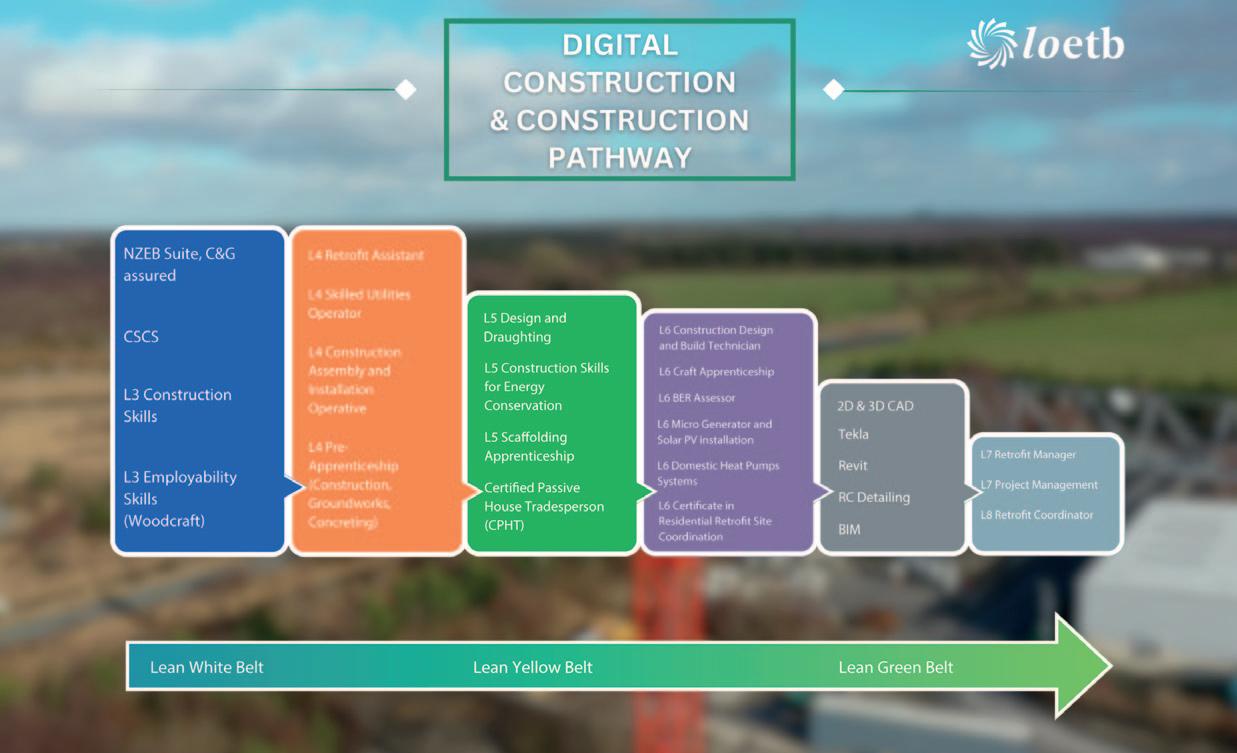
Higher Education, Research, Innovation and Science, the Department of Enterprise, Trade and Employment, and SOLAS.
The park will be an accessible and interactive resource for MMC demonstration, applied research and training located at the Mount Lucas National Construction Training Campus. The objectives of the park include the provision of an accessible flagship location for MMC demonstration, and in so doing to facilitate the showcasing of innovative MMC products and systems particularly for the housing sector while facilitating the construction sector’s greater utilisation of MMC – a necessary transition if the Irish Government’s ambitious Housing for All targets are to be achieved.
Housing for All (action 23.9) calls for a culture of good quality sustainable innovation in residential construction through the development MMC, including the establishment of a demonstration park for MMC, and is led by Department of Enterprise, Trade and Employment (DETE) and Department of Housing, Local Government and Heritage (DHLGH).
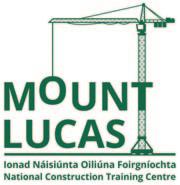
MMC may give rise to a substantial shift of labour from onsite to offsite, which will be disruptive to the current onsite supply-chain and employment model. To maximise these new innovative and growing employment opportunities in MMC, LOETB is offering upskilling and reskilling opportunities to facilitate this labour market shift.
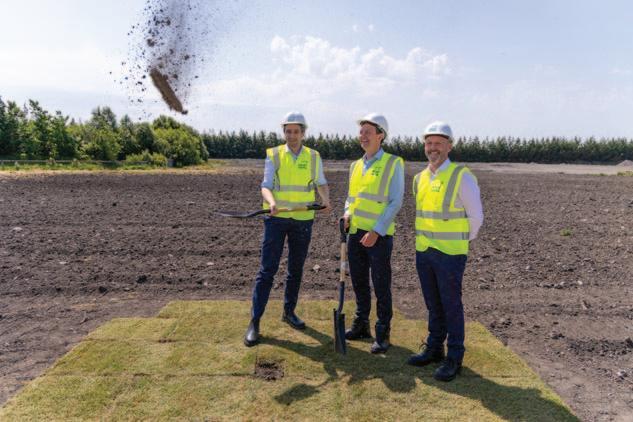
LOETB FET Service is developing pathways in each of its national and regional sectoral priority areas, that offer multiple modes of provision (full/parttime, micro-credentials) and provide a transparent and visible pathway through National Framework of Qualifications (NFQ) for learners that is based on a multiple entry/exit strategy. Thus, an individual can access training provision that corresponds to their current educational capacity and opt to gain accreditation that will facilitate progression to higher education or exit at any stage on that pathway once they have gained the competencies relevant to their skills need.

LOETB has developed a pathway in MMC that offers foundation and progression skills for new entrants to the sector but starts by focussing on the integration of relevant digital and technology skills throughout the existing workforce. Programmes are flexible, bespoke to employer and employee needs, and provide modularised, stackable micro-credentials for
participants, with a clear and agreed pathway to higher education provision. Thus, the duration of the programme correlates with the ambitions of the participant and their capacity to progress to the next level.
LOETB’s MMC provision focusses on:
• Awareness and general MMC knowledge: Introducing MMC: raise awareness and educate stakeholders about the benefits and potential of MMC. Training programmes and workshops that provide an overview of MMC, its benefits, and how it can be applied in different construction projects.
• Design and planning: MMC requires a different approach to design and planning, which may require upskilling for architects, engineers, and project managers. This training provides knowledge of, and competencies in, design and planning tools, software and systems that are specific to MMC projects, including building information modelling (BIM).
• Manufacturing and production: MMC usually relies on a prefabricated approach to building components, which requires different manufacturing and production methods compared to traditional construction techniques. This suite of programme focuses on manufacturing and production techniques specific to MMC, including the use of advanced materials, automation and robotics, and modular construction techniques.
• Installation and onsite assembly: While MMC components are generally prefabricated offsite, they
still require onsite assembly, which requires a different set of skills and knowledge. Thus, this programme includes competency training in installation techniques, health and safety considerations, quality control and assurance, and project management and coordination.
• Maintenance and lifecycle management: MMC structures require maintenance and lifecycle management that differ from traditional construction techniques. Training in this area focuses on specific maintenance requirements for MMC structures, lifecycle management tools and techniques, and sustainability considerations.
The MMC pathway is incorporated into a broader construction pathway that incorporates LOETB’s prioritisation of retrofit and NZEB, digital construction and a tertiary approach to education that, through collaboration with the higher education sector, offers pathways to degree programmes.
W: www.mountlucas.ie

AHBRA’s regulatory framework sets out our overall approach to the oversight of AHBs. It includes the registration of AHBs, the standards for AHBs, monitoring and assessing compliance, education and guidance, promotion and awareness of the Act, and the collection and publication of information, as appropriate. Additionally, the framework incorporates concerns, notifiable events, and relationships with other statutory and regulatory bodies.
Our first annual monitoring programme was conducted in the final quarter of 2022. It sought a range of data and information from AHBs, relating to their activities and performance. This information is crucial, as it enables us to identify sector risks, target future guidance and training, and to plan our annual assessment programme.
We published our Annual Sectoral Analysis for the Approved Housing Bodies Sector in May 2023. It provides a comprehensive overview of the AHB sector including dwelling numbers, location, staffing, financial data, forecasted growth, and funding mechanisms.
The level of co-operation from the AHB sector as part of this monitoring programme was positive, with an 87 per cent response rate. The analysis is based on data submitted by those 387 AHBs. The full report can be found on our website.
In addition to the data submitted, the annual monitoring provided an insight into AHB’s property and asset management, tenancy management, governance and financial management and reporting and AHB’s compliance with the standards. The information
An important focus for the Approved Housing Bodies Regulatory Authority (AHBRA) has been the development of the regulatory framework, including our approach to monitoring and assessing AHBs and the application of risk-based regulation, writes Susanna Lyons, Chief Executive of AHBRA.
provided enables us to identify education and guidance needs, based on the weaknesses identified.
One area of focus is improving compliance with the Governance Standard.
Good governance is essential to the effective operation of all AHBs. Successful boards will:
• provide strong, effective leadership and direction;
• understand the nature and scale of both opportunities and risks that their organisation face;
• communicate in an open and transparent manner with stakeholders; and

• commit to promoting and maintaining high ethical standards.
AHBs provided details on the number of board members in place and how often they met. The overall figures shown above demonstrate that, on average, boards do have sufficient membership and do meet regularly.
However, a number of organisations reported they did not meet appropriate standards relating to their board:
• 22 AHBs reported having less than five board members in place, which is the minimum number required to meet the eligibility requirements for being registered as an AHB;
• 68 AHBs reported that they met less than three times per year; and
• 29 AHBs reported that they had only met once in the past year or not at all.
For boards to be effective they must meet regularly to ensure there is appropriate oversight of the organisation. AHBs who fail to meet regularly will find it difficult to evidence and demonstrate how they meet the Governance Standard.
AHBs were asked a range of questions relating to their approach to governance as outlined below. Effective risk
management and regular oversight of risks by boards provided lower than expected levels of compliance. This was particularly an issue for smaller AHBs.
The information submitted indicated a number of weaknesses and areas of concern. Those AHBs who reported that they do not have these basic governance requirements in place, will be expected to demonstrate a substantial improvement across governance with a particular focus on holding regular meetings, having clear policies and procedures in place and having a focus on risk and risk management.
It is important that all organisations have a clear understanding of all the relevant legal, regulatory, funding, and statutory obligations that affect them. The board should have assurance that they are complying with all obligations. Appropriate risk identification, management and reporting is essential to the successful operation of all AHBs. Risk management is an important tool for all AHBs irrespective of size. Smaller AHBs will need to demonstrate that they
identify, evaluate, and manage risk. These risks should be captured within a risk register and regularly reviewed by the board.
AHBs should continue to engage with the regulatory framework, including our annual monitoring, and the notifiable events process. They should ensure they are fully aware of the obligations within the Governance Standard and utilise the guidance for AHBs, which provides key information on how to meet the standards. This is available on our website.
AHBs should continue to actively participate in any educational and guidance, webinars and events conducted by AHBRA and to utilise all published advice and guidance.
E: info@ahbregulator.ie
W: www.ahbregulator.ie
Deputy Secretary of Housing, Urban Regeneration and Local Government at the North’s Department for Communities, Mark O'Donnell, discusses progress on the draft Housing Supply Strategy, expansion of the Social Housing Development Programme, and the challenge of net zero.

The draft Housing Supply Strategy was formed in the context of recognisable challenges in the form of increased housing stress, homelessness, and affordability challenges for both renters and potential owners. Two-and-a-half years after publication, the Strategy has still not received Executive approval and O’Donnell believes that those original challenges have become even more pronounced.
“Demand has not reduced. It seems fewer households are able to access homeownership, perhaps due to higher mortgage rates, higher
property prices, economic uncertainty, or the costof-living crisis,” he says.

“At the same time, social housing allocations are not where we would want them to be. There is competition for homes.”
The publication of the final Housing Supply Strategy has been delayed due to the lack of a functioning Executive, and while O’Donnell says he cannot pretend there are no consequences to not having a government in place, the extensive engagement process and broad consensus on the core aspects of the strategy has provided
confidence to move forward with the development of a first action plan, ensuring work towards implementation is already underway.
Early identified draft actions include providing more social and intermediate homes, including the development of a new intermediate rent product; implementation of the Social Housing Allocations review, and progression of regulations to improve the private rented sector.

O’Donnell stresses that while most of the initial actions fall under the remit of the Department, the “whole system approach” to developing the draft Strategy has helped to forge relationships with stakeholders.
“For example, we have been actively working with other departments and stakeholders to identify and progress actions that will help us deliver on major cross-cutting issues such as skills and infrastructure,” he explains.
“This includes work underway to ensure wastewater data is being effectively shared and used between relevant bodies. Also, developing actions to up-skill and re-skill our existing workforce and making the construction sector an attractive proposition for young people.”
O’Donnell emphasises that the provision of new social homes remains a priority for his department, pointing out that despite other financial pressures, the majority of the Department’s capital budget is spent on the delivery of new social homes.
The Deputy Secretary explains that aspirations to increase new social housing targets are not only driven by the current waiting lists, but also the
growing number of people seeking asylum and evacuees arriving in Northern Ireland in the past year.
“The good will of the public and the voluntary sector have mobilised impressively to meet this challenge, but it all represents strain on our capacity to provide temporary accommodation. This in turn reflects strain on our capacity to provide permanent and appropriate solutions through social housing. The strategic solution is always more social housing.”
Currently, there are two main limiting factors to delivery. The first is budget. The Department estimates the need for at least 33,000 new social homes over the next 15 years, however, recent analysis shows that if the Department was to increase starts by 50 units per year for the next five years, the cost would be well over £1 billion.
“The budget outlook at the moment is therefore pretty worrying,” states O’Donnell.
The second factor is the capacity to deliver. The Deputy Secretary stresses that the challenges of budget and capacity are interlinked, highlighting that extra funds will only be made available if decisionmakers have confidence in the Department’s capacity to spend its allocation.
On plans to increase the Social Housing Development Programme (SHDP), O’Donnell says, “We have been working closely with the Housing Executive, housing associations, and a range of public bodies to identify what actions we need to take and how we might better structure delivery. Real change can only be achieved through genuine cross-departmental and appropriate government commitment to tackle housing need.”
The Deputy Secretary indicates that work is ongoing to identify public land held by government
departments which could be released for social housing, while at the same time identifying the potential acquisition of existing properties, to increase social housing stock.
Discussing additional challenges in relation to wastewater infrastructure and subsequent planning restrictions, O’Donnell says the Department is working with its counterparts in the Department for Infrastructure (DfI) to find solutions and prioritise planning for housing in key areas of social housing need.
Turning to the other significant challenge shaping the work of the Department and delivery of the Housing Supply Strategy, O’Donnell says that some of the most significant challenges for his department in relation to climate change are directly related to the residential sector.

The Department for Communities is leading the residential element of the buildings sector emission reduction targets. Currently, residential dwellings account for 14 per cent of Northern Ireland’s greenhouse gas emissions, but a step change is required if a targeted 33 per cent reduction in the residential sector is to be achieved by 2030.
Highlighting that his department has recently established a new Climate Change Division to develop policies and actions needed to reduce residential emissions, O’Donnell says that beyond the challenge of a switch away from fossil fuel-based heat systems, there is a need to massively increase the energy efficiency of homes across all residential tenures.
He adds: “We will have to do it carefully to avoid cold bridging, condensation, damp, and mould. And importantly, capacity and skills in our construction sector will need to be enhanced to deliver this.”
The Deputy Secretary believes that, although challenging, the transition to carbon neutrality presents major opportunity for the residential sector, not least the chance to make fundamental change in its ambitions, processes, and social contribution.

“The key role that both the construction of new housing and the retrofitting of existing homes will play in helping to achieve this transition cannot be understated,” he explains.
“Our social housing programme offers the opportunity to lead the way in showing how housing can meet our climate challenges. The Department intends to be proactive in driving the changes necessary to meet our commitments.”
The Housing Executive’s report on the cost of carbon savings in Northern Ireland’s housing stock indicates a mean cost of £15,600 per dwelling to improve energy efficiency to at least EER band B. With approximately 586,000 eligible dwellings, the total cost would be £9.2 billion.
O’Donnell says that a major part of the policy work will, therefore, be to consider how this transition is funded.
The Deputy Secretary concludes by saying: “We also need to consider climate adaptation for houses which means designing homes to be resilient to future changes in climate – like higher temperatures and more extreme weather causing more flooding.
“Our work on housing continues to move forward, despite the challenges and impediments that we are all facing. We will continue to look for ways to advance our housing programme in every way possible.”

Electric Ireland Superhomes is an SEAI registered one stop shop looking after all the key stages of a home energy retrofit, from design, contractor selection, project completion and management of SEAI grant funding to bring houses and apartments to a minimum of a B2 BER standard.
with a renewable energy focused approach’. We are currently on track to achieve our target of retrofitting 35,000 homes by 2030.
Electric Ireland Superhomes delivers retrofit solutions with the support of a multi-disciplined staff of over 40 people comprising of retrofit advisors, energy engineers, surveyors, and BER assessors. We now have a dedicated team that specifically focuses on the multiples sector including housing owned and managed by local authorities, approved housing bodies, and non-corporate landlords. This team is led by Mike O’Rourke, who has over 28 years’ experience in building services engineering, with the last six years in the housing retrofit sector.
Electric Ireland Superhomes can provide a range of services to local authorities to meet their needs from a full energy retrofit consultancy service to the provision of services expected under the Energy Efficiency Obligation Scheme.

For approved housing bodies and noncorporate landlords, Electric Ireland Superhomes can provide a full one stop shop service that can avail of the SEAI grants for houses that were built and occupied before 2011 and have an existing BER of B3 or lower. SEAI grant supported retrofit measures include insulation upgrades (including roofs, walls, and floors), replacement doors and windows, mechanical ventilation, airtightness, solar PV, and heat pumps. The process for an energy retrofit starts with an initial consultation to establish your requirements followed by a detailed house survey that includes the building fabric and heating systems. An energy report is then prepared that recommends a package of measures.

Electric Ireland Superhomes is a joint venture between Tipperary Energy Agency and ESB (Electric Ireland) established in 2021, with a vision ‘to empower our customers to achieve warmer, healthier, low-carbon homes

Electric Ireland Superhomes is currently involved in the retrofit of homes up to a minimum B2 BER rating for Carlow County Council, helping to achieve their targets as part of the Energy Efficiency Retrofit Programme. Stage one is near completion with 22 homes retrofitted, while stage two with 37 homes is scheduled to commence shortly.

Once satisfied with the recommendations in the report, we can finalise the design of the works, prepare documents for tender or pricing, and arrange for the grant documentation. We carry out interim checks on the retrofit works in progress and a detailed final inspection once the project is completed. A health and safety file and post-works BER Certificate are provided on completion of the project.
Mike O’Rourke Head of Contracting and SafetyT: 086 440 2565
E: mike.orourke@electricirelandsuperhomes.ie
W: www.electricirelandsuperhomes.ie
One thing that is needed to deliver homes is finance. The more finance is removed as a barrier to delivery, the greater the population of builders and developers who are able to deliver, having a positive impact on supply.
Home Building Finance Ireland (HBFI) was established by the Government in 2019 to help ensure debt finance was


not, or did not become, a barrier to the delivery of new homes. HBFI operates on a commercial basis, and this basis is enshrined in the legislation that underpins us. In practice what that means is that HBFI is designed to provide debt finance for commercially viable residential development, to compliment the main banks.
Commercially viable broadly means that a scheme needs to be able to stand alone and provide a sufficient return for a developer or builder while covering its costs. We believe the size of the scheme does not have to impact on whether or not it receives debt finance and for any scheme delivering more than five units we can, and do, make finance available. We lend to builders and developers, just as banks or other lenders do, but typically focus where the main banks may have less of an appetite to lend. That could mean in a particular location, with a particular customer or at a particular risk level. The most important thing underpinning our approach is flexibility, we work with our customers to find ways to get finance in place even where there may be challenges.
Up to the end of April 2023, we have approved over €1.3 billion in funding to support the delivery of over 6,100 new homes. These numbers continue to
The delivery of new homes has many different elements, it needs lots of willing market participants and a broad range of different stakeholders to get the final product delivered, writes Darragh Lennon, Head of Commercial at Home Building Finance Ireland.
grow month by month and our goal is to ensure no viable scheme goes unbuilt due to a lack of debt availability. We are financing a wide variety of schemes for private sale, for use as social housing, affordable housing, both houses and apartments and broader mixed developments.

Understanding what is happening in the market is important to us, because it helps us to fulfil our mandate. That means in practice, we want to be involved in as many conversations as we can with builders and developers around funding so that we can understand any barriers that exist, or issues that might be emerging, preventing them from securing debt finance, or the right kind of debt finance. We also work closely and engage extensively with the broader sector, with government agencies, local authorities, industry bodies, the advisory community, politicians, and the business community. It is by looking as broadly as we can that we can gain a real understanding of what is happening on the ground, where the barriers are for builders and developers and how we can help or change our approach as needed.
We have demonstrated this flexibility in the way we have evolved since our establishment. The creation of the momentum fund during the early stages of the Covid pandemic is a good example of this, where we identified a potential finance availability gap which could emerge due to the uncertainty created by the pandemic and responded
to that. This fund made €300 million of funding available and supported the delivery of 1,018 new homes at a time when there was significant market uncertainty. We will continue to take a flexible approach to both individual transactions on a customer-by-customer basis and adjust our overall approach with the market to make sure that potential debt financing gaps get filled. There is no silver bullet solution to increasing housing supply, but the many initiatives introduced under Housing for All have seen a steady increase in completions starting to come through.
As these initiatives come into place, it is critically important that providers of debt finance understand them and their impact and work closely with customers to maximise the value and impact that they can have. With that in mind, the
role that we in HBFI can play remains very important, by making sure we have an understanding of all the relevant initiatives and well-established relationships with stakeholders across the sector, both public and private, we can make sure that finance remains available to our customers.
By being part of the conversation, listening to the market and adjusting as we go, we can and are playing our role in making sure that no viable scheme remains unbuilt.
Treasury Dock, North Wall Quay
Dublin 1, D01 A9T8
T: 01 238 4600
E: info@hbfi.ie
W: www.hbfi.ie
“Up to the end of April 2023, we have approved over €1.3 billion in funding to support the delivery of over 6,100 new homes. These numbers continue to grow month by month and our goal is to ensure no viable scheme goes unbuilt due to a lack of debt availability.”
Homelessness among young people has risen by 57 per cent in the past five years, prompting the Government to develop a strategy working towards ending homelessness for young people aged between 18 and 24.
Recent figures showing young people aged between 18 to 24 make up some 17 per cent of all people accessing emergency accommodation in Ireland do not offer a full picture of the worsening level of youth homelessness in Ireland.

Worryingly, despite addressing the housing crises and the reduction and prevention of homelessness featuring high on the Government’s priorities, youth homelessness has been increasing in recent years, with homelessness amongst the 18 to 24 age group rising by 57 per cent in the last five years.
In June 2021, Ireland signed the Lisbon Declaration on the European Platform on Combatting Homelessness. The Declaration commits all signatories, Ireland included, to working towards the ending of homelessness by 2030.
Following commitments in the Programme for Government and Housing for All to develop a Youth Homelessness Strategy. Publication at the end of 2022 came with 27 specific actions delivering on three main strategic aims of:
• preventing young people from entering homelessness;
• improving the experiences of young people in accessing emergency accommodation; and
• assist young people in exiting homelessness.
The strategy focuses on young people aged between 18 and 24 who are experiencing, or at risk of experiencing, homelessness, but also recognises that the cause of homelessness “often begins years before the person turns 18 and will therefore examine causes and make recommendations in that context”.
Young people are disproportionately represented in the homeless population. As of April 2023, 1,491 young people aged between 18 and 24 were accessing emergency accommodation in the State. This accounted for 17 per cent of all adults accessing this service. From December 2020 (the Covid-era low) to July 2022, there was a 70 per cent growth in 18 to 24-year-olds accessing emergency accommodation. In Dublin, where homelessness numbers are highest, there were more single presentations across the 18 to 24-year-old cohort than any other five-year age range in 2021.
Recognising the diversity which makes up a ‘youth’ age range, the strategy identifies and includes specific actions to help six specific cohorts as being of heightened vulnerability in the form of care leavers; people with disabilities; young parents; members of the Traveller community; LGBTI+ community members; and individuals leaving prison services.
The first strategic aim of the strategy focuses on prevention, recognising that the right supports at the right time can be crucial to ensuring the wellbeing and successful development of a young person.
Included in a variety of actions outlined in the strategy is the development and implementation by local authorities, working with DCEDIY and Tusla, of clear processes to identify young people at risk of homelessness, with consideration for the possible strategic pathways that could guide young people away from presenting as homeless.
Alongside measures to strengthen support structures for young people and families who are experiencing domestic conflict and breakdown, the strategy aims to enhance connectivity between local authorities and Tusla. Housing for All includes the action “Enhance family support and prevention and early intervention services for children and their families through a multiagency and coordinated approach, and disseminate innovative practice”,

and subsequent subgroups of the National Homeless Action Committee, one focused on enhancing family support and prevention and early intervention services for children and their families, and another focused on young people leaving prison, are delivering recommendations, which should be implemented.
The second strategic aim of improving the experiences of young people in accessing emergency accommodation recognises that that emergency accommodation is not a substitute for a proper home and that a young person’s stay in emergency accommodation should be as brief as possible.
The Strategy recognises that those on the frontline have an invaluable role in providing support to vulnerable young people, adding that the “importance of knowledgeable and empathetic service providers cannot be underestimated”.
The strategy commits the Department of Children, Equality, Disability, Integration and Youth, liaising with Tusla and the local authority sector, to examine the establishment of a framework for specific assessments for young people presenting to services in order to identify supports required. Another significant commitment is a review of mental health supports for young people in emergency accommodation, recognising that mental health services need to be well-equipped to support young people who encounter such difficulties.
Importantly, the strategy requests authorities to ensure the specific inclusion of young people in Regional Homelessness Action Plans, with consideration given to those who have been identified in the strategy as vulnerable cohorts.
The third strategic aim of the strategy recognised that “in order to minimise entrenched long-term homelessness and the ‘institutionalisation’ of individuals within homeless services, it is essential for young people to exit into sustainable housing solutions to mitigate, as far as possible, the risk of re-entry into homelessness”.
To do so, the strategy proposes the development of a pilot model of a housing-led intervention for young people: Supported Housing for Youth (SHY). The Strategy commits to developing a national model for SHY, which will be a youth housing-led intervention for young people with complex needs, who have experienced homelessness. Additionally, there are plans to pilot the use of social housing as shared accommodation for single young people on the social housing waiting list, to meet their immediate housing needs.
Following the publication of the strategy, a steering group has been established under the auspices of the NHAC to drive delivery and monitor progress. The group will meet regularly and be required to provide a progress report of actions at each quarterly NHAC meeting. Membership of the group is set to be reviewed annually.

According to Robert Burns, Fingal’s Director of Housing: “We wanted to ensure that the strategy we had in place would give us a proactive approach to utilising existing resources and maximising their potential. These idle assets, however, represent more than just decaying structures—they symbolise potential homes for people, meaning we can meet the pressing demand for social and affordable housing and help revitalise communities.”
The Council’s plan outlines several key strategies for achieving its objectives. These include identifying and mapping vacant properties, establishing partnerships with local stakeholders, providing financial incentives to property owners, and facilitating community engagement. Fingal believes this will help to breathe new life into as many properties as possible, prioritising those that are most suitable for conversion and helping deliver in areas right across the county.
With continued commitment and collaboration, Fingal’s strategy serves as a beacon of hope and a model for others dealing with housing challenges. In doing so, the Council is determined to use every available tool and resource, moving beyond mere aspiration and into action.

Fingal has a high demand for housing across all tenures, so with an innovative strategy in place, the county is actively transforming neglected properties into vibrant, habitable homes. This ambitious initiative aims to increase housing supply by harnessing the untapped potential of derelict and vacant properties. The Council believes that by rejuvenating these properties, it is not only addressing the shortage of homes but also contributing to sustainable development.
Launched in Portrane on a site where 14 derelict and vacant cottages are being refurbished by the Council, Fingal's Vacant Homes Action Plan provides a comprehensive roadmap for bringing abandoned properties back to life. The plan's primary goal is to refurbish and reimagine these derelict structures as liveable homes, thereby increasing the availability of housing options.
Moreover, the Council understands the necessity of community buy-in and support. As such, the plan outlines a proactive approach towards community engagement, aiming to encourage residents to report vacant properties, whilst also ensuring they are informed about the progress of renovation projects in their local area. Not all vacant properties are located in what might be perceived to be deprived areas, nor are they necessarily derelict, boarded-up, or causing a problem.
“This is a win-win solution for both the community and those in need of a home, be it an owner taking advantage
While Fingal County Council is committed to continuing the construction of new properties to help meet ever increasing demand in one of Ireland’s fastest growing and youngest regions, the Council is also taking significant strides in addressing dereliction and vacancy in the county.
of the various grants the Government has made available or if it is the Council getting stock rapidly into use for those on our waiting lists. We are committed to providing the necessary support and incentives to facilitate the transformation of these properties into much-needed homes,” says Burns.
Fingal’s diligent efforts in identifying and engaging with property owners have led to numerous vacant properties being revived as habitable dwellings. Since 2019, over 70 homes have been bought back into use via schemes such as the Buy and Renew Scheme, the Repair and Lease Scheme, Compulsory Purchase Order and engagement with property owners. Having a progressive strategy that seeks to transform derelict and vacant properties into habitable homes is key to this, and while the challenges are significant, the Council is determined to meet them head-on.
Alongside the progress in bringing properties back into occupancy themselves, the Council has also approved 13 Croí Cónaithe vacant property refurbishment grant applications for private property owners with a further 36 applications currently under assessment.
One of the most promising initiatives within this comprehensive plan is the ambitious restoration of 14 vacant and derelict cottages at Portrane, properties which have been provided to the Council by the HSE. Refurbishment was recently completed on three of these properties and they are on offer to social housing applicants. The balance of the properties is moving through the tender and works stage of the overall restoration programme. These quaint houses, once brimming with character and warmth which had become vacant and dilapidated. Yet, they symbolize immense potential, poised to be transformed into desirable homes, while also preserving a tangible piece of Fingal’s rich history.
Beyond alleviating the increasing demand for housing, in undertaking projects like the restoration of the former HSE cottages at Portrane, Fingal believes that it is also feeding into a broader narrative of community identity and pride.

This approach is not lost on the new Mayor of Fingal, Adrian Henchy, who, in fact, grew up in one of the 14 cottages that has been revived into a new family home. He is keen to focus his term as Mayor on delivering more houses across the County, not just the bricks and mortar
wanted to ensure that the strategy we had in place would give us a proactive approach to utilising existing resources and maximising their potential. These idle assets, however, represent more than just decaying structures—they symbolise potential homes for people, meaning we can meet the pressing demand for social and affordable housing and help revitalise communities.”
Robert Burns, Fingal’s Director of Housingof the homes themselves but by also ensuring sustainable communities are in place around them.
“By preserving the past and embracing the future simultaneously, Fingal is showcasing how respecting heritage and addressing current housing demands need not be mutually exclusive,” Henchy says.
“I am obviously delighted that somewhere where I was born and bred is getting a new lease of life. I am sure that it will bring a new family many happy memories like those I experienced living next to the Fingal coastline, particularly where it has a thriving and welcoming community surrounding it. What is more, this is being in a way that is helping deliver hope for more sustainable, inclusive, and historically conscious urban development in Fingal and beyond.”
Fingal’s Vacant Homes Action Plan stands as a testament to the county's commitment to addressing the housing crisis in a sustainable way and being mindful of the Government’s Housing for All Strategy, in particular Pathway 4: “Addressing vacancy and efficient use of existing housing stock”.
By repurposing derelict and vacant properties directly and assisting property owners do so themselves, Fingal are not only expanding the availability of affordable and social housing, but also assisting the revitalising of neighbourhoods and the creation of vibrant communities.
W: www.fingal.ie“We
Éireann is committed to playing its part in the national drive to support the construction industry provide homes to people who need them by prioritising the delivery of key water service infrastructure.”
We are committed to supporting social and economic growth and the Government’s Housing for All policy objectives. In September 2021, Uisce Éireann established a cross functional housing programme to ensure that we are supporting housing delivery in an efficient and timely manner. The programme focuses on the delivery of our obligations under the Housing for All strategy and has established a governance model to support escalations and timely decision-making.
We have listened closely to, and collaborated with, the construction industry and moved to improve our connections process, ensuring that we keep pace with construction demand.
Uisce Éireann’s Strategic Funding Plan and Capital Investment Plan sets out our ambition for the building, repair, and upgrading of Uisce Éireann’s water treatment plants, wastewater treatment plants, and water and sewer networks. We will invest €5.3 billion in water services from 2020 to 2024 with significant benefits for the economy and the environment. Continued investment is critical to delivery on Uisce Éireann’s objectives.
In 2022, Uisce Éireann invested over €1 billion (€1.061 billion) in capital
expenditure for the first time. We delivered this investment through our infrastructure delivery portfolios. For example, the utility recently completed the connection of a major new trunk water main in Ballycoolin, which will lead to significantly increased capacity to support growth and development in Fingal and North County Dublin, as well as providing a more secure and reliable water supply to the 350,000 customers currently on the network. Similar projects are underway across the country as we work with our delivery partners to support growth and development.
Yvonne Harris, Uisce Éireann’s Housing for All Programme Director says: “Uisce

To further support development and planning, we have published water and wastewater capacity registers on our website www.water.ie. These capacity registers provide information on the treatment capacity available to support planning authorities across the country, allowing the development community to identify areas with potential for social and economic growth as well as supporting the national drive for housing.
We have also established a Self-Lay in Public Roads programme and an Experience-Based Accreditation scheme. Both of these innovations have helped industry deliver housing speedily, while also ensuring the integrity of our infrastructure now and into the future.
In 2022, Uisce Éireann processed preconnection enquiries associated with 116,647 homes. We issued connection offers associated with 36,989 housing units. We enabled 4,250 connections to water services infrastructure associated
As the Irish population grows, the need for more homes increases, which in turn puts pressure on existing infrastructure, including the water and wastewater system. Uisce Éireann has a critical role to play in developing water infrastructure to support economic growth including the delivery of housing across the country.
with over 25,000 homes, a significant increase from 2021.
Our quality assurance team completed over 6,900 site visits in 2022, as requested by developers, to ensure that water services assets can be vested by Uisce Éireann securing safe and reliable services for our customers into the future. We see all of these numbers trending upwards in first half of 2023, we are keeping up with industry demand to enable homes to be connected to our infrastructure.

Working with a wide range of stakeholders, including developers, the construction sector, business organisations such as the chambers of commerce, local authorities, and others, Uisce Éireann has continuously refined its connections process to ensure it is fit for purpose to meet Ireland’s housing needs.
“We are working to build effective partnerships to meet the housing supply challenge and we are here to listen to our stakeholders and take action.
“We are proactively making this happen by hosting, presenting, or attending relevant conferences and events relating to housing to support our key stakeholders. We will continue to work in partnership with all those who are committed to the goal of providing homes, to ensure Uisce Éireann can deliver water infrastructure where and when it’s needed,” adds Yvonne Harris.
Working with our regulator, the Commission for Regulation of Utilities (CRU), Uisce Éireann also developed a First Mover Disadvantage (FMD) policy proposal to mitigate ‘first mover disadvantage’ for developers. The CRU, following public consultation, have now published a decision paper on first mover, all details are available on CRU website.
Notwithstanding the significant progress that we have made, challenges remain. Construction inflation is an issue for everyone involved in infrastructure delivery, and Uisce Éireann is no exception. We recognise that our suppliers, contractors, and other delivery partners are facing increased costs and we are working with them to ensure that investment in essential infrastructure continues.
Finally, our message to the construction industry is that we want to work in collaboration with all stakeholders to deliver homes. We have the team in place, and we have the capacity to deliver. We would encourage all
developers and builders to engage with us early in your project, to construct assets in line with our standard details and codes of practice, to enable a timely connection and let us help you get the job done.
We are confident that by working together and combining our knowledge, skills, and expertise we can meet Ireland’s housing needs, while ensuring these new homes have reliable, sustainable water services, and that we protect the environment for future generations.

In addition, we are supporting the Government’s new initiative allowing developers and others to be refunded for water and wastewater standard connection charges as set out in circular PL/04/2023. This is one of several new measures announced by government aimed at encouraging developers to build more homes. We are working closely with the Department of Housing, Local Government and Heritage Water Services and Planning Department to implement a cross functional process to support construction. Please watch our website for updates www.water.ie/connections.
Uisce Éireann has a key role to play in helping communities around Ireland to thrive and we are fully committed to playing our part in the national drive to provide homes to people who need them by developing and prioritising the delivery of key water service infrastructure. We have already made progress in upgrading and developing critical water and wastewater infrastructure and we want to continue to enable communities to grow with further works that will support sustainable growth and development, provide safe drinking water and enhance the environment. Despite the challenges that lie ahead we are confident that, with the continued support of our stakeholders, we will deliver the additional infrastructure needed to support the implementation of national strategies and deliver housing.
W: www.water.ie
Government ambitions to retrofit one-third of the State’s housing stock by 2030 have been given fresh emphasis under Climate Action Plan 2023 (CAP23), the framework to deliver economy-wide carbon budgets and sectoral ceilings.
Published in December 2022, the third iteration of the Climate Action Plan (CAP) encompasses an objective to accelerate the delivery, rather than raise, the Government’s ambitions around retrofitting.
Climate Action Plan 2023 is the framework through which the Government intends to meet the economy-wide carbon budgets and sectoral emissions ceilings, as well as the emissions reduction targets set out in the Climate Action and Low Carbon Development Acts.
A target to retrofit 500,000 buildings to BER B2 by 2030 was first mooted in Climate Action Pan 2019, but the introduction of the carbon budgets has necessitated an acceleration in
delivery. The CAP sets out a target of all new dwellings designed and constructed to Nearly Zero Energy Building (NZEB) standard by 2025 and equivalent of 120,000 dwellings retrofitted to BER B2 or cost optimal equivalent.

The sectoral emissions ceiling for the built environment has been set at 36 MtCO2eq. for the first carbon budget period, from 2021 to 2025, and 28 MtCO2eq for the second carbon budget period, from 2026 to 2030. These ceilings have been further subdivided between the residential and commercial/public subsectors, as set out in Figure 1.
To meet the ambition of retrofitting one-third
of the State’s housing stock by 2030, it is estimated that some 76,000 retrofits per year must be completed from 2026 onwards, compared to 15,500 in 2021.
In 2021, the built environment (residential, public, and commercial sectors) accounted for 12.3 per cent of Ireland’s greenhouse gas emissions, underpinned by the fact that an estimated 73 per cent of dwellings still use fossil fuels as a heat source.
The National Development Plan outlined an unprecedented €8 billion (including €5 billion in carbon tax revenues) to support upgrades to 2030. The subsequent National Retrofitting Scheme includes a range of key measures, including the new National Home Energy Upgrade Scheme, the creation of one-stop shops, an increase in the number of free upgrades to those in energy poverty, and a special enhanced grant rate, equivalent to 80 per cent of the typical cost, for attic and cavity wall insulation for all households, to urgently reduce energy use as part of the Government’s response to current exceptionally high energy prices.
Investment will also be tailored to developing skills and enhancing the supply chain. The retrofit programme alone will require the associated workforce to increase from around 4,000 full-time equivalents in 2021 to at least 17,400. The Green Skills for Further Education and Training (FET) Roadmap 2021-2030, launched in 2022, provides a framework for enhancing the workforce, alongside the opening of additional Centres of Excellence will allow increased demand for skills in retrofit and NZEB to be met, with an overall NZEB training target for 2022 of 4,550.
Alongside retrofitting ambitions, CAP23 sets out the installation of 0.8 TWh of district heating capacity by 2025 and 2.5 TWh by 2030. By 2025, the
Built environment key targets:
• all new dwellings designed and constructed to Nearly Zero Energy Building (NZEB) standard by 2025, and Zero Emission Building (ZEB) standard by 2030;
• equivalent of 120,000 dwellings retrofitted to BER B2 or cost optimal equivalent by 2025, and 500,000 dwellings by 2030;
• up to 0.8 TWh of district heating installed capacity by 2025, and up to 2.5 TWh by 2030;
• 170,000 new dwellings using heat pumps by 2025, and 280,000 by 2030;
• 45,000 existing dwellings using heat pumps by 2025, and 400,000 by 2030; and
• sup to 0.4 TWh of heating provided by renewable gas by 2025, and up to 0.7 TWh by 2030.
Government hopes to have 170,000 new dwellings using heat pumps, rising to 280,000 by 2030. For existing dwellings the target set by CAP23 is 45,000 by 2025, rising to 400,000 by 2023.
Up to 0.4 TWh of heat is to be provided by renewable gas by 2025, and up to 0.7 TWh by 2030.
Importantly, CAP23 asserts: “All buildings will need to switch to heat pumps or district heating by 2050, meaning that the gas grid will no longer supply existing homes and commercial premises. It will also require the urgent
ending of new gas connections or the installation of new fossil heating systems in new or refurbished buildings. Where heating systems are being upgraded, this should be to non-fossil fuel systems.”
A new National Policy Statement on Heat will guide the Government’s overall response to the National Heat Study across all sectors and a key driver of change will be a new Renewable Heat Obligation, to be introduced by 2024.

Donal Mc Manus, CEO of the Irish Council for Social Housing (ICSH) writes about one of the growing areas in social housing delivery that has a significant multiplier effect in meeting other government objectives in relation to planning, the environment and climate action targets, supporting local services as well as, of course, meeting essential housing need.

Although, the process of using existing buildings and properties can be frustrating, as legacy issues may emerge and there may be even more stakeholders than is usual in the decision-making process, the
repurposing of suitable properties for social housing is an area which has shown high value impact in creating or recreating more sustainable communities.This delivery is now becoming more mainstream.

The ICSH, with 270 members, is the national federation of housing associations representing and supporting approved housing bodies (AHBs). Established in 1982 by a number of active and forward thinking non-profit housing associations, last year the ICSH celebrated its 40th anniversary. The ICSH has evolved from overseeing and supporting a sector with a few thousand homes to over 54,000 homes in 2022. ICSH AHB members are now active in every local authority area and have a presence in up to 600 local communities. The sector has in fact been active in developing and managing social and affordable homes since the 1890s. AHBs now provide general needs family housing, and housing related supports to specialist groups, such as homeless households, disabled people, older people, households with mortgage difficulties, and those from new communities.

Over the last 20 years approved housing bodies (AHBs) have increased their contribution to annual social housing delivery from around one in five of all new social housing to 44 per cent in 2022. This was the highest ever annual level of social housing provided by AHBs and contributed to assisting local authorities and their targets as setout in the social and affordable housing action plans. As a collective, the AHB sector has been adding 10 per cent of new social housing per year to its longterm permanent housing stock. This increased social housing stock is now complemented by a small number of AHBs that have developed new cost rental homes for those on moderate incomes in mixed tenure developments.
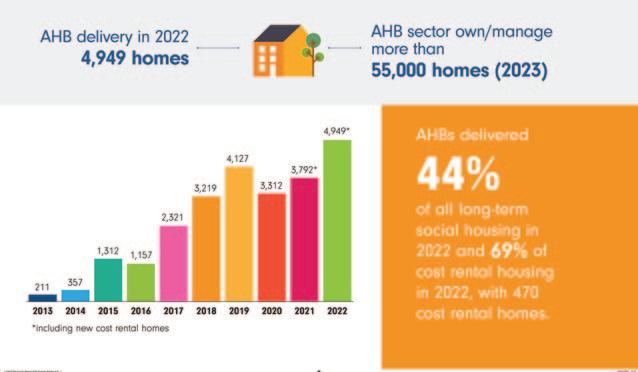
In total, the sector provided 4,959 social and cost rental homes in 2022. What is noticeable is the increased number of new high quality social housing projects being developed at scale for general needs and families. This scale of delivery for general needs has been successfully achieved by developing housing associations with significant pipelines often in partnership with the private sector. The introduction of significant investment by government through Housing for All, AHBs raising their own finance through the Housing Finance Agency (HFA) and private financial institutions has bolstered delivery capacity. This is in addition to supports from The Housing Agency for processing schemes and practical
interventions with access to land. All of these measures cumulatively enhance delivery capacity.
However, what is also apparent – and often overlooked in the increased delivery of social rented homes by AHBs – is an increase in the proportion of projects that have now been repurposed from commercial or vacant and derelict properties into new social rented homes. There has been a tradition within the AHB sector of this type of development since the 1980s, with such examples as convent conversions, coastguard stations, creamery sites and so on, sites obtained and converted into social housing through various funding schemes. This has been added to in recent years, with approximately 15 per cent of delivery developed through this route of using existing properties. AHBs providing homes for special needs groups, for households experiencing homelessness, older and disabled people, have been particularly wellserved in this area, and these projects have involved substantial construction.
Commercial and public offices, banks, pubs, stables, and shops have all been notable examples recently where AHBs, working with local authorities and other stakeholders, have delivered homes in urban and rural areas. The number of former main street institutions that have closed, such as pubs and banks, has been noticeable throughout the country. A more strategic and co-ordinated approach on their long-term use would be of benefit here. All those who have been involved in developing these projects are aware of the logistical, technical, legal, planning and financial issues that often emerge in these
projects, which often affects delivery timescales. Due diligence and early appraisals may help to de-risk whilst being able to defray feasibility costs upfront would be a worthwhile investment.
These AHB projects that have repurposed non-residential properties as social rented homes or reused vacant or derelict residential properties have contributed significantly to urban and rural regeneration, reduced depopulation and helped sustain local services, while reducing the project’s embodied carbon compared to that of a new home, estimated at between 30 and 50 tonnes of carbon. Whilst AHBs have used the Capital Assistance Scheme (CAS) in the main and, (to a lesser degree) the Capital Advance Leasing Facility (CALF), to repurpose these buildings as social homes for people on the waiting list, there may also be opportunities to use some suitable buildings to convert vacant properties for cost rental homes through the Cost Rental Equity Loan Scheme (CREL), particularly in high demand urban areas. These projects of repurposing existing buildings that could be suitable for social and affordable housing can also bring the whole agenda of circularity of construction to the fore. It will enable AHBs supporting climate action targets in reducing embodied carbon. This all creates a more sustainable AHB housing stock. Any queries please contact.
W: www.icsh.ie
The first challenge, Edwards believes, is that of building public understanding of cost rental housing, so as to maximise engagement and interest in what she believes is a “potentially very promising” housing model, with her hope that “the European Regional Development Fund may be used to tackle vacancies”.
In Northern Ireland, the intermediate rents policy aims to reduce rent prices to 20 per cent below market value. In the Republic of Ireland, cost rental aims to expand the amount of non-profit social housing.
The differentiation in nomenclature by different organisations, Edwards outlines, can be a source of confusion for the public. “I think it is a misnomer to use the different terms like social housing, cost rental housing, general housing, and general

interest housing because there is a lot of language interference.
“What could be termed ‘limited-profit cooperative housing’ is actually cost rental; what is termed ‘co-operative housing’ in Switzerland is actually cost rental. All of these models are essentially housing that factors out the profit incentive.”
“In many countries, you have non-profit finance providers who are backing the schemes,” Edwards states. “That could be a public bank, or public revolving funds. In Ireland, we do not have that and there is an urgent need to analyse the scope for nonprofit finance provision in terms of the proportion of subsidies and the proportion of non-profit finance.
“There also might be a difference in terms of the long-term obligation to reinvest any limits on the profits that the entities make. In other countries, there would also be strict auditing and regulation around the reinvestment of any profit.
“The most common issues are the cost of finance, the cost of land, and the pressure coming from unregulated private markets. You also have inflation and interest rates which are making it very difficult, as well as the lack of labour and the cost of construction. There is real pressure to innovate and bring down the price of construction. There is the challenge of competition for the land with private players.”
Edwards emphasises the importance of ensuring that the green agenda being pursued by the EU takes a holistic approach, being acutely aware of the needs of those on lower and middle incomes.
“The European Green Deal, if it is implemented correctly, can help us tackle energy poverty, and can lead to better housing conditions,” Edwards says. However, she warns that: “If the Green Deal is not implemented correctly, it could lead to undesirable and negative consequences. So it is vital that we get the balance right with all of this.”
A further challenge raised by Edwards is the lifting of the break on EU state aid rules, which was implemented over the Covid-19 pandemic. Amid this backdrop, she states the need for “a recognition of the real amount of public finance that is now needed to tackle the crises in housing and the climate” and that “we have clear political space and fiscal space to make that investment which is badly needed”. She also reiterates that spending in these areas must be characterised as an “investment, not a cost”.
“Green taxonomy and the growing impact of environmental and social governance in the financial sector are very important; we have to make sure that the social impact is in line with the constructive work being done on the ground. We cannot allow the agenda on affordable housing to be set by the private sector.”
Emphasising the three key metrics of affordability, availability and sustainability, Edwards again emphasises the need for a balanced policy approach. “We have to go green, but we have to go green in an inclusive fashion,” she states, adding: “We are constantly bringing

“We cannot allow the agenda on affordable housing to be set by the private sector.”
General Secretary of Housing Europe, Sorcha Edwards
together this benchmarking of systems, looking at what tools countries have to tackle the crisis, and how housing systems are equipped to tackle the type of societal challenges that we have.”
Edwards summarises the policy approaches taken by the governments of the Netherlands and Portugal. “The Dutch Government has proposed quite a strong intervention in the private rented market. This is now being debated in Dutch courts. They will step in and reduce rents according to a points system linked to the quality of the homes.
“They are also looking at reducing short-term tenancies; something that was introduced in 2016 intended as a way to increase the speed of supply; it did not work out that way. Now, they are looking back to have permanent tenancies.”
In Portugal, meanwhile, Edwards explains how the Portuguese Government is intervening “to stop the golden visa scheme and to increase the pressure to bring vacant homes back into use”.
She concludes by outlining the challenges of ensuring that government policy is consistent with the needs of low and middle income earners, and how Housing Europe is considering these factors in its research. “We are examining the social impact of having a strong limited profit sector because they can push the issue there. It can be issues like circularity, making sure biodiversity does not suffer from retrofitting, looking at how we can combine approaches, and bringing stock back into use.”
Sorcha Edwards is the General Secretary of Housing Europe, the European Federation of social, affordable, and co-operative housing, a role she has held since 2014. The sector manages 25 million homes and delivers over 200,000 new homes and renovations annually.


On 22 February 2023, Minister for Enterprise, Trade and Employment, Simon Coveney TD hosted a construction sector stakeholder event focused on identifying ways to drive innovation and boost productivity in residential construction, including through the adoption of modern methods of construction under Housing for All
It is understood that feedback from the event will be used to inform the development of a roadmap for MMC adoption in publicly procured residential construction under the Housing for All Action Plan.
The Department of Enterprise, Trade and Employment has established and chairs a MMC Leadership and Integration Group, a cross-departmental and cross agency group tasked with identifying and progressing actions to accelerate innovation and MMC adoption in residential construction. One area of focus is the progression of new procurement approaches in social housing that will promote the use of MMC.
In the midst of a continuing housing crisis, together with an increasing focus on decarbonisation and net zero targets in Climate Action Plan 20231, a means of construction that promises improved speed of delivery, better environmental performance and waste reduction, amongst other benefits, seems like low hanging fruit. However, when one considers the MMC approach and the market itself, it soon becomes apparent that what might be an appropriate procurement and contractual route for traditional construction is not necessarily suitable for MMC. Therefore, work is required to be undertaken to consider the appropriate procurement approach in order to leverage the advantages that
MMC covers different types of construction which involve significant portions or all of the building being manufactured in a factory setting and joined together on site.
MMC could undoubtedly bring as part of the solution to the housing crisis.
This article considers some of the key procurement and contractual issues that make MMC different, which in turn calls for a legal approach that differs from the well-trodden path taken for traditionally procured projects.

Unlike traditional methods of construction, MMC requires earlier decision-making associated with the
manufactured elements. Engaging the supply chain early could be achieved in various ways from a procurement and contractual point of view. The use of framework agreements, single or multisupplier, would appear to be the most logical means through which to secure the early involvement of the supply chain, giving manufacturers the benefit of a pipeline to plan and invest in appropriate resources to meet the demand.
The Guidance Note on Modern Methods of Construction, published by the UK Cabinet Office2, suggests several possible procurement routes involving direct engagement with the supply chain manufacturer, which is subsequently novated to a main contractor with single point design responsibility or an integrator-led approach with the ‘integrator’ having responsibility for the overall coordination for the various manufacturing supply packages. Having an umbrella collaboration agreement, such as the FAC-1, could also be used to incentivise and reward the achievement of agreed objectives for a project or portfolio of projects involving multiple contractors, designers and supply chain members.
Intellectual property: Consideration is required as to the ownership of any intellectual property rights in products. In the normal course a manufacturer would seek to retain ownership of any IP rights, but there may be a need for the client to own the IP rights or have a licence to use them for the project or its re-development or extension in the future.
Insurance: Insurers use historical data to quantify and evaluate risk. Research has identified that the limited loss data for MMC3 makes it more difficult for insurers to understand trends and quantify potential risks which has resulted in a cautious, conservative approach to underwriting projects that use MMC, posing a challenge for the adoption of MMC. In addition to considering the overall insurance package, insurance of the loss or damage to products in the manufacturing process or the transportation of completed products is critical.
Long lead items and ownership of off-site materials: There will commonly be a requirement to make advance payments to secure a manufacturing slot and to start production of products off-site. Security for any payments in advance for goods and supplies not yet incorporated into works needs to be carefully considered, including the use,
as appropriate, of advance payment bonds or parent company guarantees. Vesting certificates can also be put in place to record that ownership in the goods rests with the client where payment has been made and confirming that the goods must be stored separately and identified as the goods of the client, in order to defeat any retention of title claims.
Changes: Manufacturing requires all elements to be fixed prior to going into production. Late changes by a contracting authority can be costly and lead to delays. Ways to mitigate this risk is to require the contractor to identify critical activities and dates in its programme to support an efficient manufacturing process, the agreement of a design freeze date for the manufacturing-related elements of a project and early warning of any event that is likely to delay the manufacturing process.
Audit and inspection: Contracting authorities may require more detailed inspection, quality assurance and audit rights over manufacturing facilities. The mass production of pre-manufactured components means that defects could be widespread and involve significant time and cost if a large volume of impacted components required replacement. Inspection and auditing processes would be a means to mitigate this risk.
Other: Risks to be considered in any contract may be the shortage of skilled personnel to carry out repairs subsequent to the installation of the manufactured products and completion of a project. Product warranties and performance guarantees may become a feature to minimise such risks. Any delays in the transportation of goods or
delays in the incorporation of products held on site into the works, leading to water ingress/damage, is another risk to be considered. Close oversight of the programming of works including the right to require regular updated programmes, early warning systems and collaborative working practices may be a means through which to seek to address such risks.
Lean: Incorporating lean practices into the construction process as a contractual requirement would certainly appear to complement the MMC approach and assist with collaboration and the minimisation of identified risks.4
It appears that we are at a tipping point for the use of modern methods of construction in the development of residential housing in Ireland. Encouragingly, government bodies are seeking to drive the agenda forward, recognising its potential role in solving the country’s housing crisis. New technology and approaches bring new challenges – given the possibilities, it certainly seems worthwhile seeking to address these and find the appropriate path forward.
Angelyn Rowan, Partner, Projects and ConstructionContact us
T: 01 237 3700
E: info@philiplee.ie
W: www.philiplee.ie

We need to step up our collaboration between the public and private sector to develop and implement workable solutions to accelerate the adoption of innovation and modern methods in construction.
Minister for Enterprise, Trade and Employment, Simon Coveney TD
The Intermediate Rent Policy, published by the Department for Communities, is tailored towards those earning above the social housing affordability threshold but struggling to access the private rented sector.
Published over two years ago, the draft Housing Supply Strategy set out ambitions to introduce a range of measures to increase the supply of affordable housing. While no Executive has been in place to approve the strategy, significant consultation on it prior to the Executive’s collapse has enabled the Department for Communities to progress some policies, including the Intermediate Rent Policy.
The Intermediate Rent Policy was published and came into operation on 30 March 2023.
Intermediate rent is neither social housing nor open market private rental. Instead, the model recognises that increased social housing supply alone will not be adequate to address levels
of unmet housing need in Northern Ireland.
Research done by the UK Collaborative Centre for Housing Evidence for the Department for Communities suggests that Northern Ireland has around 135,000 privately renting households, over a third of whom pay 25 per cent or more of their income in rent. Over 14 per cent of private renters are estimated to be paying 40 per cent or more of their income.

Alongside affordability, security of tenure has been a long-term concern for those in the private rental sector. The Private Tenancies Act (Northern Ireland) 2022 sought to strengthen the rights of tenants in the private rented sector. However, some have argued that an increased onus on landlords does not go far enough.
The Intermediate Rent Policy aims to go some way to addressing both affordability and tenure security, with rents offered at least 20 per cent below prevailing market rents for a similar
property type and size within a locality, and tenancies of up to five years at a time, with the option to renew subject to the agreement of the landlord and tenant.

However, the Department has not stipulated how many additional homes it hopes the policy might generate, instead stating that “detail on the number and location of a first phase of intermediate rent homes remains under development”.
Intermediate rent tenancies will still be private rented tenancies but will differ from open market private tenancies in a number of ways, making it a more suitable option for households who can pay more than social rents, but have affordability issues in the open market.
Importantly, the policy is clear that existing occupied dwellings should not be repurposed as intermediate rent.
While it is not intended that tenants have a lifelong tenancy, the policy sets out that intermediate rent homes are intended to remain as such, with a
A new affordable housing policy aimed at longer-term rents at least 20 per cent below market value has been geared at increasing housing supply in the North.
minimum period of 10 years (two consecutive tenancies). There will also be no option to purchase the property at the end of a tenancy.
Although no funding arrangements have yet been produced, the Department says that it intends to separately provide financial support towards the development and letting of intermediate rent homes, however, in recognising that demand may outstrip supply, the Department has welcomed the development of intermediate rent homes outside of the suggested funding model. Interestingly, the Department states that it will not compel any organisation to deliver intermediate rent.
In a statement, the Department says: “The Department for Communities intends to separately provide financial support towards the development and letting of intermediate rent homes. Work continues to finalise these future funding arrangements. Funding is expected to be made available to an intermediate rent operator who will deliver and let a supply of intermediate rent homes and be awarded funding via a competitive process. The Department will continue to engage with those interested in delivering intermediate rent homes in preparation for awarding funding.
“Subject to budget and approvals, financial assistance in the form of Financial Transactions Capital loan is expected to be made available, alongside a promoter’s contribution, to create a new supply of intermediate rent homes in the future. The Department also welcomes self-funded intermediate rent housing provision.”
The location of intermediate rent homes is not limited, however, it is recognised that the policy may be most effective in areas of high rents and high demand. Alongside the policy, the Department also published a Homes for Intermediate Rent: Design Standards guide, setting out the expected design and finish standards associated with intermediate rent homes.
Single adult applicants for intermediate rent must have an income not exceeding £30,000, rising to a £40,000 ceiling for a two or more adult households, however, it is stated that these homes are not intended to be houses in multiple occupation. The income calculation omits savings up to £30,000, recognising that some tenants may be saving for homeownership, and disability-related benefits, while excluded from a tenant’s income total, can be considered in an ability-to-pay rent assessment.
Initial rent rates of 20 per cent below market value, which cannot change in the first year, if uprated, must remain not more than 80 per cent of market rents for similar properties in the location.
An assessment by the Department states that in line with the policy that a household should not pay more than 30 per cent of their net income on rent, initial intermediate rent rates would be capped at £750 per month for a single adult household and £1,000 per month for a two or more adult household. However, a household may pay up to 40 per cent of their income in “exceptional” and assessed circumstances.
A number of protections for renters of this mode include rent increase, of no more than 5 per cent per year (while still within the 80 per cent of market values range), a nine-month lead in time to tenancy end/renewal, longer term deposit (six to 12 months) payment periods, and provision for prompt and effective repairs by landlords.
On how delivery of the policy will be funded in the absence of a minister, a spokesperson for the Department for Communities said: “Work continues to deliver a funding package which can support the practical delivery of a supply of new intermediate rent homes in the near future.”

In recent weeks there has been a call for radical thinking and specifically a call to consider the development of a National Home Building Agency, tasked with the national delivery of housing of all tenures to reduce the “over-reliance” on the private market. There are elements of the approach that are workable and over a period of time, this approach may even be successful, however, it is the time that this would take to set up and the unintended consequences that could be catastrophic in the short term.
To create a National Home Building
Agency (and by the way, we used to have one, it was subsumed into the Housing and Sustainable Agency in the early 2000s due to the inability to make it work at the time), we would have to make substantial changes to our planning laws (making them less democratic), probably subsume most of the building companies in the State (a form of nationalising of companies), build a workforce and management of an organisation that was efficient enough to reduce the costs of housing (despite significant inflationary pressures), and ensure that there was no direct political involvement in the
process or the organisation. The potential costs of assembling such an organisation would be very significant and would be very time consuming. And what would happen in the meantime?
The current mechanism of delivery would either stop or slow to a trickle while the government of the time works out what they are going to do and how they were going to do it, thus exacerbating the current housing crisis, which by the way, in my opinion, is now a housing emergency! I am for radical thinking, but I do not think this is the way forward.
Over the last few months, our housing and homelessness figures have continued to fall short of the targets that have been set. With more than 12,000 households now living in emergency accommodation, tens of thousands of people seeking international protection and a significant growth in our population, we cannot continue to deliver the same targets and expect to meet the overwhelming demand there is for housing of all types, writes
John Hannigan, CEO of Circle VHA.
So, what other means of radical thinking should we be considering?
I actually think that the current Housing for All plan has its merits, and we are beginning to see some real positive results from a number of the initiatives that have been started through the plan. Unfortunately, in Ireland, as in any country, it takes time to deliver homes, and sometimes in the intervening period, things get worse.

The reality is, we have all the elements present (albeit we could do with some more people to build or manufacture homes), we just do not have them connected, in my opinion, in the right way. The idea of a National Home Building Agency, as I said at the start of this article, is not a bad idea, but let us re-imagine it, not as a single monolith, government-run entity, but a connection of organisations, with one goal and with an efficient and effective pathway from inception to delivery of a home.
We need to change the objectives and the purpose of some of the key actors, for example, local authorities are not efficient delivery agents for house or apartment building. They will need such a huge investment in resources to enable that to happen, something that is in very short supply in Ireland right now. However, local authorities, their officers, and their elected members, are experts in housing need, State infrastructure requirements and have some land with which to make this happen. They should be re-tasked as the Strategic Enablers for all housing need within the state.
The State has set up and enabled the Land Development Agency, its original purpose was to accumulate both State land and private sector strategic land banks to enable master planning of homes across the State. It has now strayed into the building and management of those homes, the reality of that is that key resources have been pumped into developing management and development resources that already exist in other sectors. Imagine having an agency whose sole purpose was to masterplan and ensure that planning was achieved on a consensual basis in all our communities. This is one of the areas where we see the greatest delays in the delivery of homes, through the planning system. The Government has set about making this system more streamlined and efficient, and it will be a while before we see the fruits of their work.
So now we have the locations of homes, and we have the planning resolved.
How do we get them built and who manages the social and affordable homes once built?
There is a place for the private sector in this. I agree with most commentators that builders and developers need to ensure that they have moderated their profit margins. The reality is that most builders make a small enough margin on what they build, due to inflationary pressures. It tends to be the landowners, who have sat on land banks for decades, that make the very significant profits. It is they who governments need to continue to target and to tax to the extent that it begins to change their thinking. Unfortunately, we are not there yet.
A well-managed contract process, either by the LDA, or approved housing bodies, will ensure that a contract, and homes, are delivered efficiently and at the agreed price. Government have provided sufficient funding resources, but the private sector should be enabled to partner in that funding process. It is true that the State has not always gotten the best deal for the delivery of their homes, but we have new mechanisms and a means by which it can be managed, already in existence, with significant expertise and experience.
Finally, approved housing bodies, with the significant regulation that they
undergo, their significant tenant focus, and their ability to work in partnership with all of the above actors across the housing provision process, will provide excellent value for money for the State and excellent homes and communities for tenants and residents across Ireland. At this time, approved housing bodies work in every county, and across most towns and communities, delivering excellent value for money for the State and a sense of home for so many families.
So yes, it is time for radical thinking, but it is not the same that others are suggesting!
W: www.circlevha.ie
In Catalonia, rents have risen three times faster than household incomes in the last two decades, on the back of bubbles in both real estate and the rental market.
In Spain, housing is a regional competence, however, Burón emphasises that such is the scale of the housing emergency, that the city has been forced to play a role which exceeds its capacity and legal basis.
By way of example, he points out that the city of Barcelona has provided 78 per cent of the emergency housing units and the Generalitat only 22 per cent, despite the fact that distribution should be 40 per cent/60 per cent according to the rules of the housing consortium run by both administrations. Instead of growing its stock, the Generalitat has accumulated a deficit of 1,185 units between 2016-2021.
As a whole, it is estimated that Spain needs around 2.6 million affordable housing units in rental (or other alternative tenures) in order to
converge with the 15 per cent average across the rest of Europe. In Barcelona, where rental public housing represents just 1.5 per cent of the overall housing stock, there is a 90,000 affordable housing unit for rental deficit.
“Policies that support homeownership have made it difficult for most of society to access housing. We need to diversify housing tenures,” summarises Burón, emphasising the scale of the challenge.
While a range of short-term solutions to increase capacity have been deployed, Burón stresses that a focus has been placed on developing long-term instruments. The emerging model recognises that 100 per cent private management has proven to be a failure, while a 100 per cent public management is not a virtuous model.
“Housing is too important to be left exclusively in the hands of the market or the State,” explains the Housing Manager. “Effectiveness and efficiency will result from a combination of

Housing
Javier Burón, outlines the city’s mission orientated model to inclusionary housing.
public, private, and community solutions.”
The emerging model is predicated on what Burón describes as an “ecosystem” of providers and actors targeting the reduction of market housing and an increase of social and affordable housing. This entails a three-provider system: private; public; and non-profit plus commercial (limited profit). These providers are focused on two operational approaches in the form of new development and urban regeneration.
The Housing Manager is quick to point out that in seeking to increase supply, the focus is on quality over quantity, highlighting Spain and the Republic of Ireland as good examples of how, in the past, heavy supply increase did not guarantee economic accessibility.
The three main goals of new land and development policy centre on:
1. Ensuring all affordable housing units remain affordable. This is aimed at countering the fact that almost all of the 13 million units built in Spain between 1940 and 2011 have lost their affordability and joined the private market. País Vasco, Illes Balears, Navarra, and Catalonia have become the first four regions to regulate affordable housing in perpetuity.
2. New affordable housing zoning requirements aims to increase the land reserves for affordable units, to avoid segregation, and at least half the affordable units will be for rent.
3. The third goal, and one which Burón describes as a “game-changer” is the requirement for 30 per cent of most major building renovations and new construction in existing plots to be allocated for affordable housing. This policy recognises that the city cannot grow outwards and so a focus must be put on urban regeneration processes.
Public development of affordable housing in Barcelona has been good. By the end of 2023, there will be 6,600 units finished or under construction, however, Burón stresses that the
real driver for change stands in the enablement of public-private-community partnerships. Ongoing partnership between the city council, cooperatives, and foundations, set up in 2021 aim to deliver 1,000 units over the next decade. Similarly, Habitatge Metròpolis Barcelona is a PPP between the city council (25 per cent), the Metropolitan Area of Barcelona (25 per cent), and private partners selected through a public tender (50 per cent). The scheme provides for total parity in rights and obligations between private and public partners. Public land is provided in a 75-year leasehold and nonperforming units are covered by the administration. The scheme will see 4,500 affordable rental units delivered over eight years.
Other measures highlighted by Burón include the acquisition of private rental housing for social rental. An extraordinary municipal census using water consumption data and the municipal registry, plus fieldwork, identified 10,052 vacant units. Acquisition and renovation measures have enabled a 130 per cent increase in the temporary mobilisation of private housing between 2015 and 2022.
Burón believes there are five key learnings to be taken from Barcelona’s affordable housing journey so far. The first is that having a mixture of housing models results in a social mix that may provide opportunity for all. Secondly, social housing provides low-income households with stability, which has a positive impact on employability, community building, and inclusivity.
Thirdly, he believes that public-private and public-community collaborations are “essential” to grow and manage a social housing system, particularly when there is little regional and federal funding available. Condensing his final two lessons, he says: “We need more core capital for affordable build to rent, but also for purchasing, renovating, and rental PPPs. However, evidence-based policies require investments in data collection, management, and research.”

“Housing is too important to be left exclusively in the hands of the market or the State.”
international trade and investment in the future of the economy. The environment it created formed the foundation for multiple domestic and international businesses to thrive and helped to kickstart the wider economy, providing employment for thousands and arguably acting as one of the main catalysts for the regeneration of Dublin city.
The country requires flows of money from outside the State to be able to fund the supply of new homes. We cannot rely on the Irish Government and the taxpayer to fund more than a quarter of the total required annual outlay of up to €20 billion. Similar to the successful 12.5 per cent corporate tax rate and the stable operating environment that has prevailed over the last 22 years, Ireland needs to have a stable operating environment for funders of housing, be they direct lenders or investors.
The suppliers of new homes – builders and developers – as well as their funding partners, who are investors in many cases for complex apartment developments, also need a stable and workable environment to operate in. Balancing costs and revenues on housing projects can be a fine line, a line which has been significantly challenged over recent years as result of Covid-19, unprecedented lockdowns, and supply shortages of both materials and labour, as well as widespread increased costs.

The challenges faced by the industry include:
• delays in the planning systems, including vexatious objectors;
• viability for apartments;
The results of this are evident on a daily basis upon review of Irish media; it is causing significant hardship and anxiety for much of the population, especially younger age ranges. Ireland, a small open economy on the edge of Europe, cannot on its own fund the country’s housing programme.
Since the 1980s, the State has looked to foster economic development and attract corporate foreign direct investment with a range of highly competitive tax arrangements which ultimately led to the corporate tax rate of 12.5 per cent in the 1990s. This strategy recognised the importance of
• increasing building regulations;
• overnight changes in legislation relating to residential property taxes;
• unfavourable tax treatment of small investors;
• changing the residential investment
Ireland has a dysfunctional property market. The scars of the downturn of 2008 have meant that the country has struggled to scale up housing supply to meet the requirements of the population. The consequences are particularly acute for apartment development, where there are multiple complexities and risks that have resulted in minimal levels of development since 2008.
properties rent regulations several times in the last six years;
• increases in administration and costs for managing residential investment properties; and


• some local authorities bringing in adjustments to planning guidelines that make apartment development unfundable.
The Government’s Housing for All strategy estimates a requirement for 33,000 new homes per year between 2021 and 2030, which has been overtaken by demographics. As a result of pent-up demand and demographic trends the housing need is for over 50,000-60,000 new homes per year. The country requires a multi-track approach to providing these new homes –delivering social housing, affordable housing, and private housing – for owner occupiers and renters.
The extension of the Help to Buy Scheme and the introduction of the First Home Scheme are very welcome as they give confidence to builders and their funders to allow them scale-up supply on individual sites.
As a result of the challenges around funding and viability, apartment development has for the most part been taking place mainly in Dublin, and for the rental market as the model of selling to owner occupiers has not been feasible for large projects (over 50 properties).
There has been development in the counties surrounding Dublin, however,
apartments remain largely unfundable and unviable in most parts of the State. The new accommodation that has been built in Dublin, which is mostly in the suburbs, is assisting in moderating prices at all levels of the market and improving the standard of rental accommodation available, as stock that was built pre-2008 becomes quite aged, as well as freeing up accommodation for renters in the lower and mid ranges of the market. With financing of more than €10 billion from larger Irish and international funders and investors, this has facilitated the construction of more than 15,000 new homes, which provides accommodation for more than 27,000 people – this has to be seen as positive for the country.
Ireland needs a significant increase in the delivery of new homes to be built over the next 10 years and we need the State and private sector to be working at full capacity to achieve this.
It is essential that politicians and State bodies ensure they are well informed and implement policies that ensure developments for the social, affordable, and private sectors are supported. Regular consultation with key stakeholders is vital. While a balanced approach to development is required, suggesting and implementing policies that go against one form of tenure or another and create an unfundable development framework, will only serve to reduce new supply.
Similar to the definitive corporate tax policy, which was one of the cornerstones of Ireland's economic development for over 25 years, Ireland's construction, funding and investment sector needs stability and national and local government needs to provide this.
Hooke & MacDonald
118 Baggot Street Lower Dublin 2
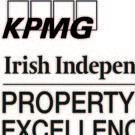
PSRA No. 001651
T: 01 661 0100
E: info@hmd.ie
W: www.hookemacdonald.ie/

“Similar to the successful 12.5 per cent corporate tax rate and the stable operating environment that has prevailed over the last 22 years, Ireland needs to have a stable operating environment for funders of housing, be they direct lenders or investors.”

The shift will see Co-operative Housing Ireland change its housing management structure from a geographic model to a specialist model. Through this change, CHI’s housing services team will develop and hone specialist skills to maximise its efficiency.


Speaking about the changes, Director of Housing Services Dave Mayner, who joined CHI in late 2022 says: “In the very early part of my career, I operated primarily in a context where housing services were delivered through a model that was based on geography. Over time the thinking shifted as the benefits of a specialist service model became clear.”
He continues: “With a specialist structure, teams focus on specific areas of housing, such as tenancy management or rent arrears. This is different than a geographic structure where you have multiple teams in different locations who take on all aspects
of housing. With a structure based on geography there tends to be a greater risk of service inconsistency. The advantage of a specialist structure is maximising the potential for people to become very good at what they do, because they don’t have to worry about a multitude of responsibilities, they can focus on the delivery of a narrower scope of services to a higher standard.”
Mayner previously worked in Wigan and Leigh Housing in England, which had 22,000 properties served by five area housing offices across the borough. Seeing the positive changes that the specialist structure had on that organisation, along with being part of a specialist service delivery set up in other housing providers he has worked for, encouraged him to introduce it to CHI. “The improvements in KPIs and targets at Wigan and Leigh spoke for themselves: we significantly improved our arrears performance, re-let times, and
Co-operative Housing Ireland (CHI) is changing to improve the services it delivers to its tenants (members). Within the coming months, the organisation, which provides more than 4,500 affordable social-rented homes across Ireland, will roll out a specialist structure to ensure greater consistency in its housing service delivery.
satisfaction in dealing with anti-social behaviour. Across the board there were improvements in performance.” More recently, Mayner was involved in the merger of five separate housing organisations to create Onward Homes, a 35,000-home organisation. A specialist structure was also rolled out for its housing services and similar uplifts in performance were achieved.
A new specialist structure will ensure that CHI adapts to deliver services more effectively, which will benefit the expanding organisation. CHI aims to deliver 700 homes this year, a record high for the organisation, and is planning for more growth in the years to come. Building and maintaining a strong Housing Services and Community Engagement Team is central to this growth, and Mayner notes the improvements he foresees in CHI: “The restructure is not a silver bullet. However, if we instil the right culture, and people work in a collaborative, supportive way, we will see the benefit of the model. What you will find over time is the level of job satisfaction that people have will increase, because people feel they have more control over what they are doing. Having the feeling of doing a good job cannot be underestimated. In a generic housing officers’ role, there are a lot of feel-good moments like giving people new properties on a regular basis, but there is so much running around and frustration because you are constantly spinning plates, and your attention is spread so thin across different areas.”

He continues: “It is very difficult in those circumstances to get to a point where you are very good at everything you do, because you just do not have the bandwidth for it. As well as improvements in job satisfaction, what I expect to see over time is an increase in positive feedback from team members in customer facing roles.”
The change will see CHI become the first Approved Housing Body to have a team dedicated to ameliorating antisocial behaviour (ASB). The team will be given specific training, which Mayner believes will encourage people experiencing ASB to come forward for support. “Once you deal with something like ASB successfully, confidence in the service increases. Managers and directors may look at it and ask, ‘how come there is so much more ASB now?’ But that is not the case: the ASB was always there, now people are just more confident in reporting it.”
Looking to the future, Mayner hopes that once the new structure is implemented, CHI can expand into other areas of benefit for people who live in CHI homes: “We can start to shift our focus and go beyond the expected services of a housing provider, particularly in the social inclusion and community development space. I have always felt that it is implied in our mandate that we address issues in those areas too, even if it is not being directly asked of us. It is in the nature of the business, because of the demographic that we serve, because of the communities we support, to think about things like food poverty, fuel poverty, digital exclusion, access to training, and employment. As a housing provider, we can act as facilitators and
an anchor organisation in partnership with experts in those spaces. I am looking forward to giving energy to that, because that is really what I think the future holds. There is so much more to successfully maintaining a tenancy than giving someone a property and keys.”
For more information:
T: 01 661 2877
E: info@cooperativehousing.ie
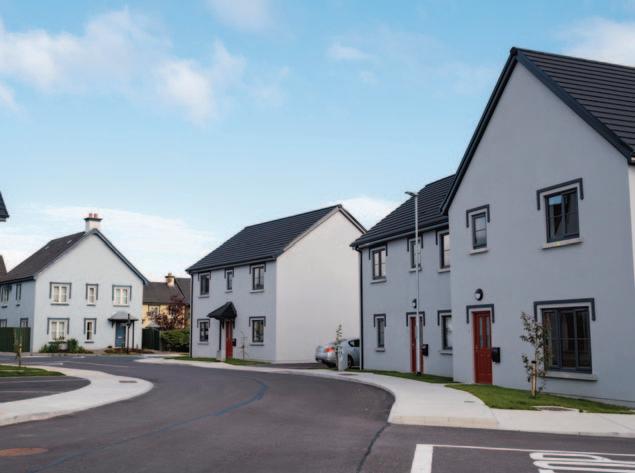

W: www.cooperativehousing.ie
Twitter: @coophousingie
An aerial shot of CHI’s estates in Barraduff, County Kerry. CHI aims to deliver 700 homes this year, a record high for the organisation, and is planning for more growth in the years to come.
In April 2023, the North’s Department for Communities (DfC) acquired the vacant Stewart Street site in Belfast’s Market area for housing-led regeneration. In this context, Ciarán Galway visits the area and speaks with Fionntán Hargey, Director of the Market Development Association (MDA), about his community’s longstanding grassroots housing and community regeneration campaigns.
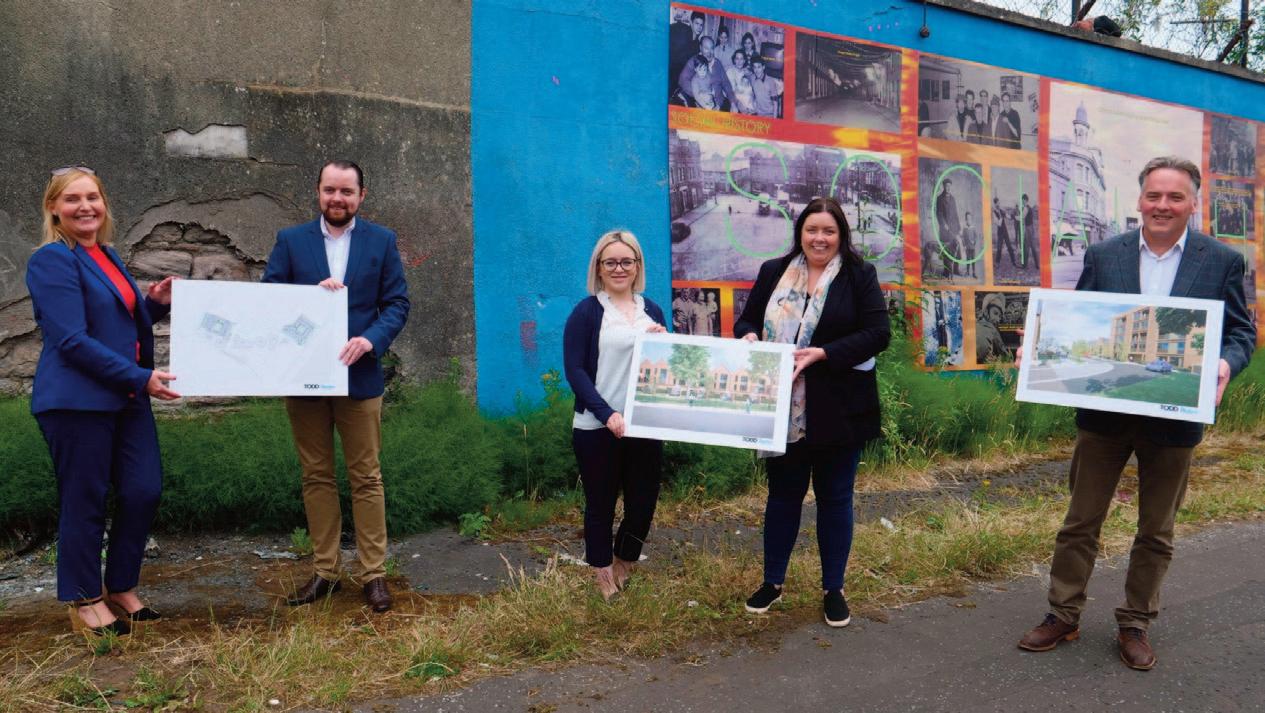
Named after the 14 commercial markets which once surrounded it – St George’s Market being the sole survivor – the Market area of south Belfast is one of the city’s longest established communities. Once an industrial heartland, its streetscape was originally constructed on a grid plan.

With the various industrial ventures which once dotted the area in the early 20th century now consigned to history, the recent conflict compounded the scarring of local geography. The grid system was erased and today, the area has only three points of road access: Stewart Street, Raphael Street, and Eliza Street.
Euphemistically alluded to as “defensive planning”, post-conflict, the consequence for areas such as the Market is continued place-based inequality and socio-spatial segregation from Belfast’s socioeconomic life.
Contained on four sides by East Bridge Street to the north, the Lanyon Place Station railway lines to the east, the Gasworks business park to the south, and Cromac Street (which bisects the area, and was previously intersected by several natural access points from the Market proper) to the west, the Market has been artificially separated from its natural hinterland: the city centre.
“If you look at older maps of the area, it is completely integrated into the city centre. During the redevelopment of Belfast in the late 1960s into the 1970s, three interlocking trends came together: suburbanisation, deindustrialisation, and securitisation of urban planning,” Fionntán Hargey observes.
“The Market, and Belfast as a whole, are not unique in experiencing sociospatial segregation, but it was the combination of those three factors, in the context of the recent conflict, which
exacerbated it beyond the experience of many other cities in the western world.”
In fact, in recent decades, this segregation has been compounded by commercial redevelopment in its surrounding environs. Referencing the Laganside regeneration area which demarcated the land of riverfront to be transformed with £1.2 billion of investment between the mid-1990s and mid-2000s, Hargey suggests that it carefully excluding the surrounding inner-city communities that neighbour the River Lagan.
“This exclusion cut deep within the psyche of these inner-city communities like ours, and the message was ‘keep out, you are not welcome’. Indeed, the only regeneration investment that the Market community observed was in gates, walls, and fences,” the MDA Director reflects.
Established in late 1995, the Market Development Association aims to “promote the wellbeing of all residents living in the Market area of south Belfast”. While the MDA does not employ a dedicated housing officer, almost half of the queries that it receives are related to housing. Discussing housing need withing the Market, the Director explains that an average of 115 families are on the social housing waiting list each year. This figure excludes people experiencing hidden homelessness, because “many local people do not see the point in registering for the waiting list because they do not think they will ever get the required allocation points, are reluctant to linger on the list for years, or do not even understand the system”.
Indeed, in 2018, the MDA community survey which informed We Must Dissent – the MDA’s overarching framework and strategy for community development – found that 86 per cent of Market residents felt that there was not enough decent and affordable housing in the area.
“There is a limited turnover in properties each year. This is exacerbated by the Right to Buy Scheme which is undermining social housing stock,” Hargey notes, elaborating: “The problem that we are observing is that while a social housing unit home may have initially been bought by a tenant as a family home, for myriad reasons that house is eventually sold on and often it is being bought up as an Airbnb or a HMO. Even if someone wanted to buy locally, therefore, they are often being outbid while simultaneously, they cannot get sufficient points to access social housing.”
On the eastern edge of the Market, adjacent to Lanyon Place Station, the Stewart Street brownfield site – a roughly rectangular plot of vacant land with a curving boundary to its south – is one of the foremost initial sights greeting rail passengers entering Belfast city centre.

In 2016, a £55 million high-rise development plan for the site crossed the Rubicon, proposing commercial development within the traditionally
residential footprint of the old commercial markets. The local community met the plan with vociferous opposition, coordinated through the ‘Sunshine not Skyscrapers’ campaign under the wider ‘Save the Market’ umbrella.
“The community’s perspective was that the proposed development epitomised all the bad planning precedents that had been happening within the Market community over the decades. In terms of the MDA’s wider strategies around connectivity and breaking the economic barriers that we are grappling with; it was overdevelopment on steroids.”
In the face of what the Director describes as an “existential threat”, the Market community was bolstered by its “alternative vision for housing”. “We were not just opposing development; rather we had a better alternative for both the community and the wider city; a real community regeneration project rather than just commercial speculation.”
Subsequently, residents fought the commercial plan at the Belfast City Council planning committee and initially lost by 10 votes to four. The plan was then subject to judicial review.
“While the judicial review was going on, the community undertook the Save the Market/Sunshine not Skyscrapers campaign. This involved everything from postering, lobbying, and filmmaking to media engagements and street protests,” Hargey describes.
“Ultimately, we won the High Court judicial review in May 2018. Later that
year, the developer sought to resubmit the planning application to Belfast City Council which then referred it to the Ministerial Advisory Group – an independent expert panel convened by the Department for Communities to assess contentious planning applications.

“In early 2019, the Ministerial Advisory Group came back, rejected the proposal, and vindicated the residents’ opposition on the grounds that it would effectively kill off the Tunnels Project. It was overdevelopment in terms of scale and design on that site. When Covid hit in March 2020, the developer then tried again to push ahead with the plan, and it went back to the Belfast City Council planning committee in November 2020 where, inverting the original decision, it lost 10 votes to four.”
Commenting on this “victory for the Market community”, Sinn Féin MLA and former Minister for Communities, Deirdre Hargey insists: “It was the political support and push that made that happen within Belfast City Council. The campaign was very effective in building up political support, as evidenced by the fact that the committee ultimately opposed it by majority.”
In a latest development, in April 2023, it was announced that DfC had purchased the Stewart Street land for a housing-led regeneration scheme. “That will unlock the tunnels and encourage active travel, while also addressing 4
housing need, which is prevalent not just in the Market community, but in the city centre as well,” the MDA Director articulates.
While hypothetically, the ground floor units, especially those nearest to the tunnels could be earmarked for commercial use, to complement that project, it is too early to determine how many housing units will be constructed on the Stewart street site. Soon, the MDA will be undertaking that type of engagement with the Market residents, collating their vision for the site.
“In terms of what normally happens, the Department for Communities will defer to the Housing Executive as the housing authority, the Housing Executive will select a housing association to bring forward a housingled scheme on the site,” Deirdre Hargey advises, adding: “We want a level of mixed use on the site to make sure that the development is complementary to the Tunnels Project and that there is good synergy. The designated housing association will bring forward a scheme and it will be down to consultation and engagement as to what the final proposal looks like.”
Discussing the projected configuration of the housing on the site, the Sinn Féin MLA believes that it will be mixed tenure. “Obviously, a portion of the housing will be social and public, but feeding into the sustainability of the community, there is likely to be different types of tenure. The policy of DfC now is to have ‘tenure blind’ accommodation going forward. We still need to address the housing need because we are in a crisis, but it is making sure that it is sustainable, that it fits into its surroundings, and complementary,” she says.
Fundamental to housing-led regeneration plans for the Stewart Street site are the tunnels which run underneath East Bridge Street. The MDA’s Tunnels Project, aimed at reopening the tunnels to facilitate active travel access to Lanyon Place and the wider city centre, as well an associated regeneration was successful in securing funding from the Executive Office and Belfast City Council.
“DfC’s focus is on wider connectivity of regeneration priorities,” Deidre Hargey emphasises. “Consider what Belfast City Council is trying to achieve through its strategic framework for the city, Bolder Vision for Belfast, creating an urban greenway around the city rather than an inner-city ring route. Bolder Vision for Belfast addresses the community severance of inner-city communities, and how they have been disconnected from the city core and vice versa. We need to overcome that severance that is felt within those neighbourhoods through projects such as the Tunnels Project.
“Key to the Tunnels Project is connectivity; beginning to breakdown the severance of the Market community from the city core. One of the tunnels will be a pedestrianised route that will start to connect all of that up.”
Previously, the ‘Homes Now’ campaign, also under the ‘Save the Market’ umbrella, saw Market residents successfully campaigne for housing-led development on the northern fringe of the Gasworks site – which borders the Market on its south side.

Running from the River Lagan to the Ormeau Avenue end of the Gasworks, the northern fringe site had traditionally been residential, but during a period of
regeneration was acquired by Belfast City Council and held for the construction of inner-city ring road. However, it remained undeveloped, becoming what is known as a ‘shatter zone’.
Replicated across the inner-city of Belfast, these shatter zones are, according to architect, Mark Hackett, “barriers that were imposed by government onto a community to detach them from the centre”.
Since 2004, the MDA began campaigning for the land to be rezoned for housing. Following the financial crash, from 2015 onwards there was enhanced private sector interest in the site as an investment opportunity for capital development. This provoked the Market community to respond with the Homes Now campaign.
“Today, instead of a proposed total of six houses on that site, there will be 94 units and part of the land developed for community use, including for economic development and job creation. While housing is important, it is also about building sustainable communities. All of this was achieved under the Homes Now campaign banner, with We Must Dissent linking up each of these campaigns,” the MDA Director observes.
Discussing his vision for the future of housing in the Market, Hargey succinctly summarises it in a line:
“Homes for all.” Asked to elaborate, the objective, he asserts, is to ensure that “every child being born and growing up in the Market has adequate space to develop and prosper”.
“It is about ensuring dignity for people while building a sustainable community. Housing is a critical part of that. We must ensure that we deliver homes for all and that the Market is a community that continues to develop and evolve, while retaining the spirit of what makes it unique. We are looking to the future in terms of sustainability, and building a neighbourhood that people want to live in and stay in. We want this collective approach to be replicated across the city to build a fairer and more sustainable society.”
“We were not just opposing development; rather we had a better alternative for both the community and the wider city; a real community regeneration project rather than just commercial speculation.”
Fionntán Hargey, Director, Market Development Association
2023 heralds a significant time in the history of North & East Housing Association as we celebrate our 30th anniversary.
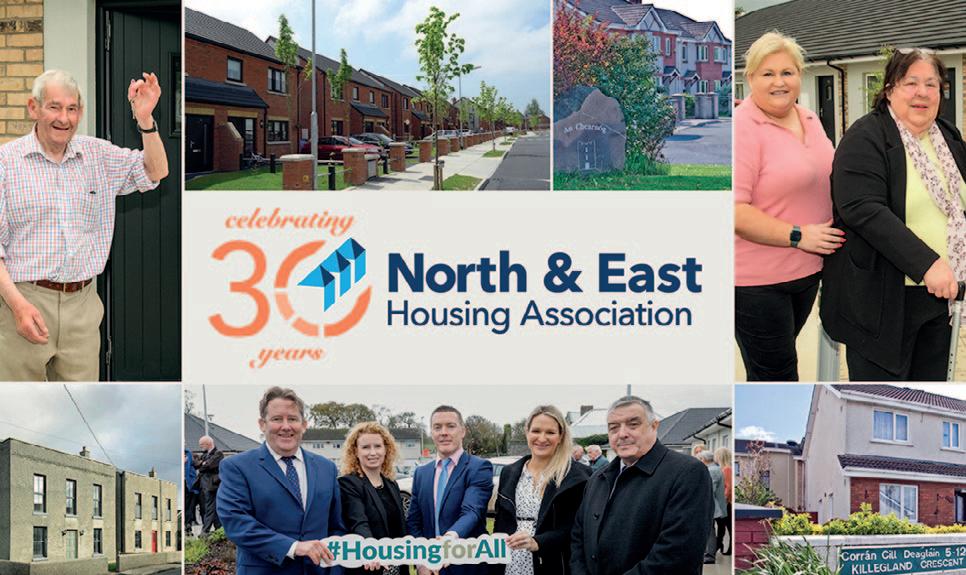
The association was established in 1993 by a small group of volunteers and our growth since then has been built on a clear focus of providing quality homes for our tenants and fostering community development. We currently have over 750 homes in management and our future plans also include significant investment in improving our homes and energy efficiency as well as new projects aimed at meeting local housing needs.
The association operates primarily in the north-eastern corridor of the country and in the early years of its existence the association’s work was carried out by the volunteer board of directors with the first staff employed in 2004. However, the board quickly realised that to continue to grow, it would be necessary to move from a volunteer-run to a professional management team-run organisation. In 2014, the board appointed a chief executive and the appointment of a senior management team soon followed.
Initially, the organisation grew its stock through use of the Capital Loan and Subsidy Scheme (CLSS) and the Capital Assistance Scheme. (CAS). However, the landscape of social housing provision began to change increasing in pace in recent years. The
board of North & East made a strategic decision to respond positively to these changes. We embraced the new Regulatory Code and new financing options.
Since its inception North & East has grown steadily and prudently, developing its portfolio of homes and managing and maintaining them to a high standard. North & East plans to fund future growth in new homes using the Government backed Capital Assistance Scheme (CAS) and Capital Advance Leasing Facility (CALF) supported by loans from the Housing Finance Agency (HFA) and other private sources. The association will also continue to participate in shared projects with other Housing Associations and service providers in the development of new housing.
North & East has always strived to put tenants at the heart of everything we do. Providing not only the infrastructure of housing in the form of ‘bricks and mortar,’ we are very much concerned with what makes a house a home.
All of our achievements were made possible by the vision of a succession of board members and the professionalism and dedication of our staff over the last 30 years We thank them all and in particular thank our tenants who have
been the driving force behind all that we have achieved.
We have recently welcomed tenants to new homes in Clonshaugh, Dublin 17, Loreto Hall, Cavan and Ballylinan, County Laois and we remain grateful to our partners in the Housing Finance Agency (HFA), Dublin City Council, Cavan County Council, and Laois County Council and look forward to continuing to work with them in the years ahead.
Housing continues to be one of the most important challenges we face as a society and at North & East Housing Association we are committed to playing our part in meeting the challenge.

T: 01 8200002
E: info@neha.ie
W: www.northandeast.ie
A study performed by Housing Europe for The Housing Agency sheds light on how cost-based social renting operates in Austria and Denmark, in order to inform The Housing Agency on different cost rental models, as Ireland steps up its delivery under the tenure model.

Social housing in Austria, 2020: 944,100 units (24 per cent of housing stock)

- Of which: Limited profit housing associations: 667,300 (17 per cent)
– Of which: Municipalities: 276,800 (7 per cent)
The bulk of Austrian social housing stock is made up by Gemeinnützige Bauvereinigung, or limited-profit housing association (LPHA) housing, which are officially classified as private enterprises with independent boards of management. Under the laws set out in the Limited-Profit Housing Act, only LPHAs can become providers of costbased social housing. It is possible for for-profit developers to also participate in the cost rental sphere in Austria, but such developers are required to keep their rents at a cost-based price until any public loans used in the development of their housing has been repaid, while LPHAs are required to keep their rents at cost-based prices in perpetuity.
‘Cost’ is defined, with developers required to recoup costs incurred for all planning, construction, financing, and management; developers do not have the option to charge below-cost rents. Costs are also calculated on an individual basis per block or estate, meaning that an LPHA with a large portfolio cannot spread the costs of developing one development to the rents of another.
A typical cost-based social housing project in Austria is funded through a combination of sources:
• low-interest public loans (30-40 per cent);
• bank loans (30-40 per cent);
• LPHA equity (10-20 per cent);
• tenant contribution through down payment (5-10 per cent); and
• additional public grant (5 per cent).
Rents are calculated using the grundmiete (basic or flat rent) system, which is set out in the Act. This is indexed to CPI inflation and is updated every two years; maintenance and improvement funds are also included in the rent, ranging €0.53 per square metre for a new building to €2.13 per square metre for buildings over 30 years old. Once and LPHA has cleared the debt associated with a development, rents have been found to fall by €0.50-€1.50 per square metre. Just 10.3 per cent of Austrian households say that meeting housing needs represents a ‘heavy’ financial burden for them.
Non-profit housing in Denmark, 2021: 560,931 units (20 per cent of housing stock)
The non-profit housing sector in Denmark is made up of over 500 housing associations, covering approximately 7,000 individual housing estates and 560,000 dwellings, providing homes for almost one million residents. Regardless of variance in size, these non-profit providers obey the same basic underlying legal and regulatory structure. Non-profit housing adopts a ‘universalist’ approach, meaning that anyone can access it, although those in urgent need do tend to be prioritised. The absence of income criteria for applicants allows for flexibility in creating balanced resident mixes in these housing developments.
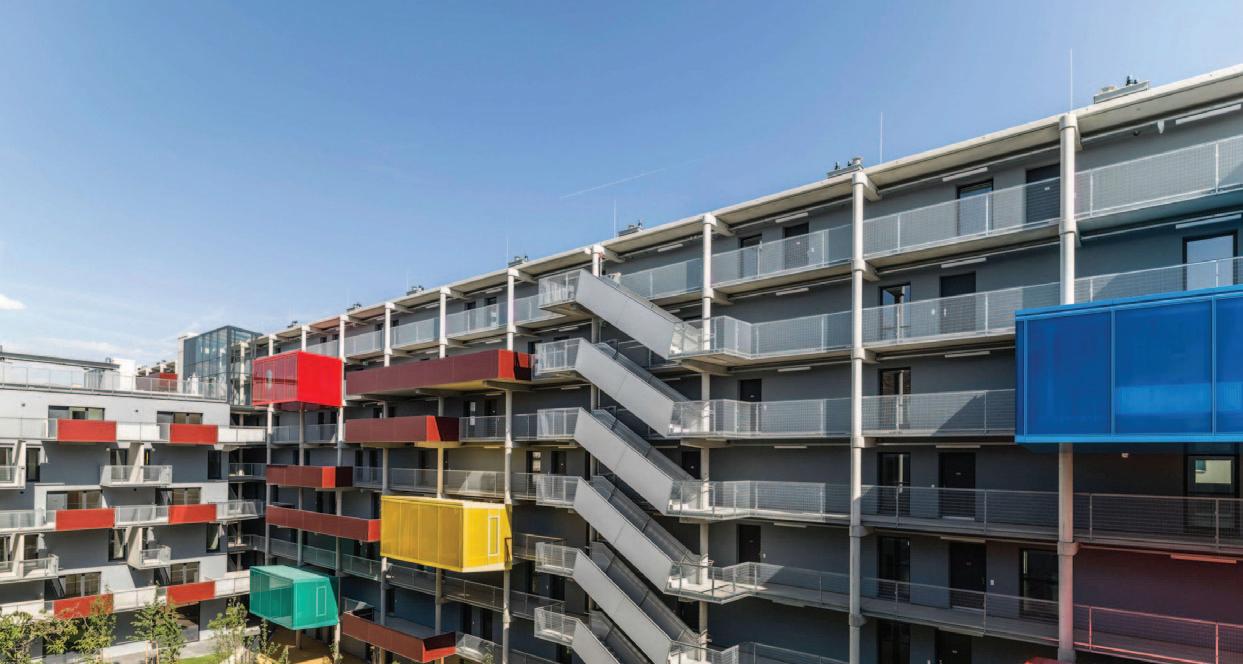
Housing associations are tasked with the development of non-profit housing blocks and estates but are subject to municipal oversight in terms of spending and budgets. Municipal authorities are also in charge of monitoring housing need within their jurisdictions and deciding when and where to construct new non-profit housing, meaning that building and operation, but not decision-making, are the jobs of these housing associations. Non-profit housing in Denmark operates under a ‘rental balance’ principle that is enshrined in law, meaning that income and expenditure within the social housing system must balance out. Rents charged are strictly what is necessary to cover the providers’ expenses, including administrative costs.
Funding for non-profit housing in Denmark is typically arrived at through:
• loans from mortgage institutions (86-90 per cent);
• interest-free, 50-year municipal loans (8-12 per cent); and

• tenant equity in the form of deposits (2 per cent).
The Danish State and municipalities can provide some financial support for the construction of new non-profit housing. Where a municipality has provided funding, it reserves the right to directly allocate a percentage of units within developments. Typically, this anvisningsret, or allocation right, covers 25 per cent of non-profit units in a development, but this proportion can go higher. Such direct allocations are typically reserved for those in immediate housing stress, victims of domestic abuse, and those experiencing homelessness, allowing them to bypass the usual queue system.
An upper limit on non-profit housing construction per square metre ensures that rents are kept low. The limit varies depending on housing type and region, with a family home in the capital region limited at 21,460 DKK (around €2,880) per square metre, with an additional amount corresponding to 368,530 DKK (around €49,500) per unit.
Annual debt repayments, which determine the rent, are equal to 2.8 per cent of the total initial development cost of the property, plus current contributions to mortgage loans, amounting altogether to approximately 3 per cent of the property development cost. When higher interest rates have been incurred, the state guarantees that the 2.8 per cent rate is maintained and pays the difference. In practice, the payment to the government, which then services the housing associations’ mortgages on their behalf. Just 7.2 per cent of Danish households report a ‘heavy’ financial burden when meeting their housing needs.
Sitting on 13 June 2023, the Joint Oireachtas Committee on Housing, Local Government and Heritage, Conor O’Connell, Director of the Irish Home Builders Association (IHBA) outlined to the committee that “[land] headroom allowance has been narrowed to 25 per cent when it should be 100 per cent”.

“Household formation size is not reflective of European norms of 2.3 persons per household and is currently at 2.7 persons in Ireland. There is an unrealistic target of 50 per cent of the residential provision on brownfield lands or existing built environments in our main urban centres.”
O’Connell also explained that “site viability and ownership can be key issues and State support will be needed for apartment construction”. He further characterised the projected growth target for Dublin and the mideast region as “unrealistically low”, adding that the timeframe for
development plans in the regions of six years is an “unrealistic timeframe”.
The IHBA representative further articulated his belief that local and county development plans at local government level, which have been adopted by most councils, have “built in these unrealistic aspirations towards land management” and that “there are many examples of settlement caps or even the de-zoning of residential lands previously zoned for housing purposes”.
O’Connell continued: “In many locations, lands have been zoned for housing which are difficult and expensive to service and, in other locations, serviced or easily serviced lands have been de-zoned or not zoned. Our land management process for housing delivery is, therefore, fundamentally flawed and almost applies a ‘just in time’ process for delivery rather than a predictive model
based on realistic timeframes for the delivery of infrastructure to facilitate housing.”
Welcoming the review of the National Planning Framework and the change from a six-year to a 10-year timeframe for development plans in the Planning and Development Bill, O’Connell said: “If we plan for 10 years, then we must provide the infrastructure for that period as well, and the infrastructure plans must marry with the development plans.”
However, he warned: “As of now, development levies account for a significant portion of the uplift percentage of land zoned for housing purposes and the State already captures a significant gain from zoning decisions. Levies and charges for public infrastructure upgrades cannot be borne by new homebuyers alone.”
'Just in time’ delivery process ‘unrealistic’
Construction targets are “unrealistic” as Ireland has an average household size which is considerably higher than the European average, an Oireachtas committee has been told by a senior housing expert.

reliable, and efficient heating system. For new build properties, underfloor heating is usually the heat emitter of choice as it works effectively at low temperatures so pairs well with a highly efficient Grant Aerona3 R32 air source heat pump to conserve energy and maximise long term carbon and financial savings. Grant Afinia aluminium radiators are also paired easily with Grant heat pumps and are also commonly used in retrofit projects.
Gorman adds: “As a company, Grant is focused on educating those in the heating trade as well as homeowners of new and existing homes throughout Ireland on the importance of choosing renewable heating technology. As part of this focus, we have diversified our education offering for installers, architects, engineers and local authorities, to include CPD courses available via our onsite training academy and online Grant eLearning academy.”
In recent years, Grant, which is based in County Offaly, has largely transformed into a renewable heating company and its award-winning heating technologies are playing an important part in helping homes become sustainable on the journey towards a zero-carbon future.
Barry Gorman, National Renewables Sales Manager at Grant explains the role the company is playing to help advance the deployment of renewables in Ireland: “Our team works closely with local authorities and developers across the country to support social housing projects, new build developments and retrofit projects. This includes providing
integrated heating solutions for new build homes, with the main heat source being a A+++ rated, Grant Aerona3 R32 air to water, air source heat pump.”
Gorman continues: “The Grant Aerona3 heat pump is a popular choice for new build housing due to its cleaner, more environmentally friendly performance and ability to deliver a fully decarbonised, resource efficient home heating system. A heat pump can also be an efficient option for older homes, which undertake a deep retrofit.”
Grant’s diverse range of renewable heating technologies work together seamlessly, to provide a fully integrated,
T: 057 912 0089
E: heatpump@grant.ie
W: www.grant.ie
Facebook & Twitter: @GrantIRL
Instagram: @grant_irl
LinkedIn: Grant Engineering ULC
About the Grant Aerona3 R32 air to water, air source heat pump:

• Award winning
• Highly Efficient A+++ Energy Rating
• Available in four outputs (6kW, 10kW, 13kW, and 17kW)
• 13kW and 17kW models recognised by Quiet Mark for their quiet operation
• Offers a superior seasonal coefficient of performance (SCOP) even at colder temperatures
• Can help achieve compliance required under building regulations
• Sized and Specified by Grant as part of their free home heating design service
Leading heating technology manufacturer Grant has been providing innovative, efficient, and carbon reducing heating solutions for over 45 years.
A 2022 Construction Industry Federation (CIF) report states that timber frames account for 25 per cent of the market already and that MMC is “the future and will increase modular and offsite manufacturing to higher standards of design, fabrication, testing, and certification”. The CIF stated within its report that there is a “good regional distribution” of offsite material providers across Ireland, with the largest concentration of facilities for such located in Cavan, Cork, Dublin, Galway, Kildare, Limerick, and Meath.
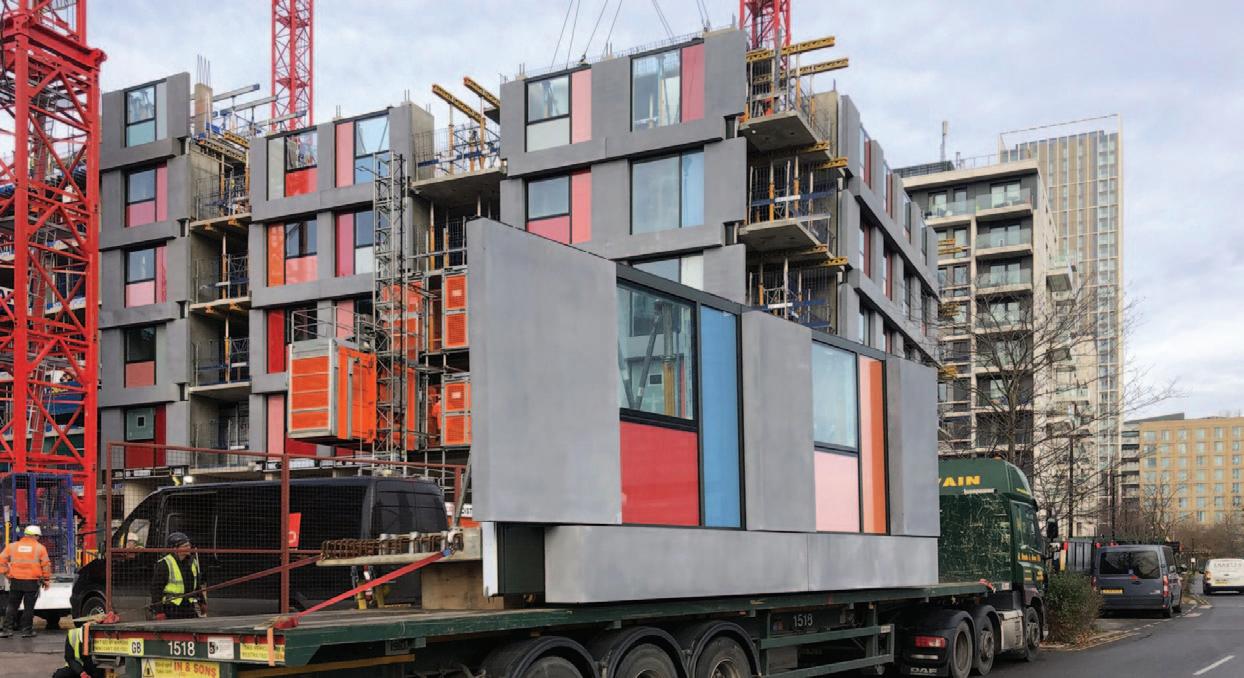
Central Statistics Office (CSO) wholesale price indices show that the materials most often used in MMC – timber and steel frames and precast concrete – have seen large increases in price during the last few years, some in line with overall material cost rises and some outstripping the pace of overall rises. Structural steel and reinforcing metal stands at 200.5 on the latest CSO whole price index (April 2023) with an annual price increase of 7.8 per cent, placing it below the annual increase of all materials (11.7 per cent) but far above the overall index score of 145.9. With 2015 prices used as 100, this means that structural steel and reinforcing metal prices have grown at more than double the pace of overall prices since 2015. Rough timber prices saw an annual contraction of 15.1 per cent, but still stand at 151.4 on the index, while other concrete products including precast stand at 129.9 on the
index, with an annual growth rate of 9.5 per cent. Housing policy objective 23 of Housing for All is to “drive economic sustainability and reduce construction costs”, with action number nine under this objective stating that the Government will endeavour to “promote a culture of compliant, good quality sustainable innovation in residential construction through development of modern methods of construction, including establishment of a demonstration park for MMCs”. The demonstration park will be located at the National Construction Training Centre in Mount Lucas, County Offaly and operated by the Laois Offaly Education and Training Board (LOETB) and SOLAS. Phase one of the park is due to be opened and operational for Q4 2023, with minutes from a February 2023 LOETB board meeting noting that stage one of the expression of interest phase for construction contractors had been completed.
Once operational, the MMC Demonstration Park will be an accessible and interactive built research, training, and demonstration resource. Phase one of the park will consist of 10 building pads, with additional space for future development. Construction companies which pass through the selection process will exhibit the latest construction technologies and innovative methods upon these pads.
Modern methods of construction (MMC) will play a key role in both construction at large in the coming decades and the delivery of Housing for All specifically. The Housing Ireland Magazine examines how MMC is being implemented in Ireland.
We are crossing the Rubicon to net-zero and Bord Gáis Energy is committed to lead the way. How? By investing in upstream opportunities to enable the transition of Ireland’s energy system to net zero. By increasing the proportion of energy, we source from renewable sources of generation. By evolving energy offerings in residential and commercial segments. And, by bringing to market new net zero propositions from our services and solutions division.
Bord Gáis Energy is growing its services and solutions division to decarbonize Irish homes and businesses and help achieve the ambitious targets set out in the Government’s Climate Action Plan, which includes retrofitting 500,000 homes and installing 400,000 heat pumps by 2030.
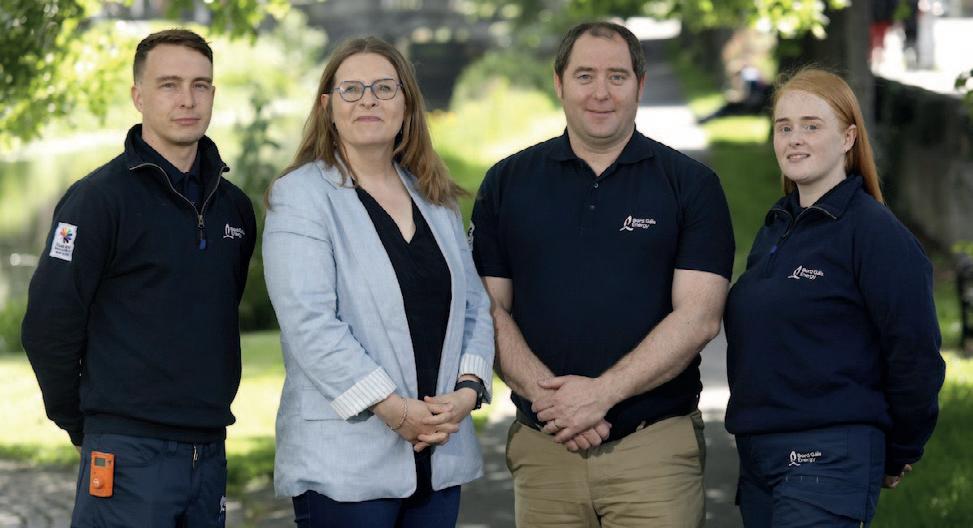
Bord Gáis Energy – traditionally a classic utility company with a strong services division – is transforming. Our strategy and purpose are rooted in providing energy services and solutions that will help our customers live sustainably, simply, and affordably. Our goal is to bring our customers with us on this journey of transition to a lower carbon world.
As a householder or business owner, Bord Gáis Energy now offers you a broad array of services that can address your home energy needs. Our services team are supporting home energy upgrades, replacing heating systems with heat pumps, or new more energy efficient boilers and smart heating controls which reduce energy consumption in the home and ultimately lower energy bills. Our expert solar team can provide tailored solutions and support to install solar panels to generate clean, green renewable energy.
Ensuring the skills are available to deliver on these objectives is a key consideration. To that end, Bord Gáis Energy recently launched a plumbing apprenticeship programme in conjunction with Solas to train 70 apprentices – 30 per cent of which will be female – over the next five years. Upon completion of their training, the apprentices will have the option to join Bord Gáis Energy’s service engineer team and upskill to become smart energy experts. Smart energy experts
install and maintain carbon efficient technologies including electric vehicle charging points, heat pumps, and solar panels, and provide essential energy efficiency advice to our customers. Our capability to service in-home needs via our service engineer network, coupled with our investment, innovation and understanding of our customers, ensures we are well placed to play a significant part in addressing the challenge ahead.
Teresa Purtill, Director of Services and Solutions, Bord Gáis Energy says: “Our strategy and purpose is to empower customers to live simply, affordably, and sustainably. Business-owners and householders are the gatekeepers to the net-zero transition. Our business is transforming. Bord Gáis Energy is determined to ensure that we provide our customers with affordable, high quality, end-to-end solutions.”
For further information visit www.bordgaisenergy.ie
As the industry confronts the challenges of disruptive change, it is an exciting time in the sector, and in Bord Gáis Energy in particular; both upstream and downstream.

Census 2022 outlines that there are 166,792 vacant homes in the State, which is considerably higher than the homeless population of 12,259 (as of April 2023).
Whilst the number of vacant homes in Ireland has declined by 27.5 per cent between 2011 and 2022, there are substantially more vacant homes nationwide than homeless people in the State. The highest concentration of vacant properties in the State are situated in western and rural areas.
For example, in County Leitrim, the percentage of vacant homes is as high as 15.5 per cent, whilst the figures in neighbouring counties Roscommon and Mayo are 13.4 per cent and 13.3 per cent, respectively. This is at odds with the demands placed by the homeless population, with an overwhelming majority of the State’s 12,259 homeless people (around 73 per cent) currently in Dublin.
Therefore, if the Government’s ambitions to utilise derelict and vacant properties are to help curb the homelessness crisis, this will invariably have to involve an incentive to encourage homeless families to move out of Dublin and to more rural counties.
The Government’s Vacant Homes Action Plan 2023-2026, published in January 2023, identifies actions to be pursued in order to continue to return as many recoverable vacant properties back to viable use as possible, increase the supply of housing available, and aims to revitalise the vibrancy of local communities.
One potential conundrum outlined by the Government in the Vacant Homes Action Plan is that the ownership of the property in question must be clarified when the home is being brought
back into use, presenting a potential legal grey area for government.
The action plan says: “A key consideration when working to bring empty properties back into use is the reason why a particular property has been left empty. These are varied and multifaceted and can relate at a broad level to migration, urbanisation, loss of industry, and employment and at an individual property level to financial, ownership, personal, or property issues.”
The report further states: “Properties can be for sale, in between rental periods, undergoing renovation, or in some cases the owner may be in hospital or in nursing home care. A lack of investment can lead to some properties being vacant for long periods and if these properties are not addressed in a timely manner, they can ultimately become derelict. The reasons for vacancy influence the measurement of vacancy and must also be taken into account in considering measures to address vacancy.”
Given that the vast majority of Ireland’s derelict homes are situated in relatively rural counties such as Leitrim, Roscommon, and Mayo, two government strategies are of immense importance if vacant homes are to be used in a serious manner to take on the homelessness crisis. These are the National Planning Framework (NPF) and Our Rural Future.
The Vacant Homes Action Plan states that the NPF will “guide the future development of Ireland, taking into account a projected one million increase in population over 2016 levels and the need for 550,000 more homes by 2040”.
The paper continues: “The NPF growth strategy aims to shift the spatial pattern of development by concentrating a greater proportion of new development in cities, towns, and other settlements where the required services, employment, and infrastructure can be provided for citizens.”
This compact growth approach aims to tackle the unsustainable sprawl of development and contribute to
overall carbon reduction. The NPF seeks to:
• enable people to live closer to where they work, moving away from the current unsustainable trends of increased commuting;
• regenerate rural Ireland by promoting environmentally sustainable growth patterns;
• plan for and implement a better distribution of regional growth, in terms of jobs and prosperity;
• transform settlements of all sizes through imaginative urban regeneration and bring life and jobs back into cities, towns, and villages; and
• co-ordinate delivery of infrastructure and services in tandem with growth, through integrated investment across sectoral plans.
The Government’s Our Rural Future policy addresses the challenges facing rural areas and the opportunities which it believes rural economies and communities can benefit from in the coming years.
The Vacant Homes Action Plan states that one of the key objectives of Our Rural Future is to support the regeneration, repopulation, and development of rural towns and villages to contribute to local and national economic recovery, and to enable people to live and work in a high-quality environment.
“Achieving this will require investing in projects which support economic activity and increased footfall in towns and villages, improve the public realm, encourage town centre living, and provide the necessary services infrastructure to support town and village regeneration and sustainable growth,” the report states.
Introducing the policy, Minister for Housing, Local Government and Heritage, Darragh O’Brien TD, said: “The most efficient home to deliver is the one which already exists and there is so much potential within our vacant stock to provide more homes for so many of our citizens.”
O’Brien added: “While significant work remains to be done, real progress is being made in addressing vacancy. Our sense of urgency remains, and we are determined to build on what we have achieved to date.”
“While significant work remains to be done, real progress is being made in addressing vacancy. Our sense of urgency remains, and we are determined to build on what we have achieved to date.”
Minister for Housing, Local Government and Heritage, Darragh O’Brien TD
Last year alone, as part of our responsibility for assessing all statutory plans, under Deputy Regulator, Anne Marie O’Connor, we made 55 submissions including 207 recommendations and 85 observations on the 23 plans made by local authorities.
In total, 11 plans addressed our recommendations. Unfortunately, 12 failed to satisfactorily address all recommendations and as a result, we issued recommendations (proposed directions) to the Minister for Housing Local Government and Heritage to
address key policy breaches, which the Minister confirmed.
See our recommendations: https://www.opr.ie/recommendationsmade-by-the-opr-to-the-minister/

As always, we listen to clear planning rationale put forward by either elected members or the executive of local authorities, and these often prevent directions.
However, where there are clear breaches of sound planning policy and principles without justification, it is our job to call out and take out.
The outcome of our interventions are positive in terms of promoting compact
It is now over four years since the Office of the Planning Regulator (OPR) was established, and four years on, our work of independently overseeing the planning system in Ireland is already having a positive impact.
growth, sustainable settlement, transport strategies and climate change.
Thanks to the final directions issued by the Minister, development far removed from urban centres and remote from services were prevented. Building on lands that have flooded in the past or, owing to climate change, will very likely flood in the future, was also prohibited.
In four years, we have also established an independent process of external review of local authority planning functions.
We have completed four reviews of a pilot phase of a local authority reviews programme. Across these (Tipperary, Louth, Galway city, and Kildare) the key theme was the need to strengthen local authority capacity, particularly in forward planning and enforcement, through enhanced resources, better digital systems, more training and staff development.
Reviews are currently being finalised in Waterford and Offaly county councils.
Reviews will be initiated shortly in Meath and South Dublin county councils meaning four years into our establishment, we have completed or are embarked on reviews of a quarter of all local authorities.
Read our reviews https://www.opr.ie/reviews-programme/
Until we were established, the 949 local elected members – who we must acknowledge are the policymakers in the development plan – never had a national training programme in arguably their single most important function.
The OPR now holds near bi-monthly events that have benefitted almost every
single councillor in the country and that have built up into a practical range of learning resources.
See our training resources: https://www.opr.ie/research-trainingpublic-awareness/

In addition, we have held well-attended planning training events for staff of local authorities and regional assemblies. Local authority members and staff working in planning in the local government sector, now have access to relevant, practical and applicable training which they can apply to their day-to-day jobs which will improve outcomes for their communities.
Resources such as practice notes, case study papers and planning leaflets have also been put in place providing the latest research and information on important planning-related topics.
Four years is a short period in the lifetime of any organisation but, the OPR is already delivering on its mission.
With the growing recognition of the vital role of planning as the country grows and develops, the OPR will continue to bring added value to the sector over the next four years and beyond.
T: 01 854 6700
E: info@opr.ie
W: www.opr.ie
“The OPR now holds near bi-monthly events that have benefitted almost every single councillor in the country and that have built up into a practical range of learning resources.”
Published in May 2023, the Residential Construction Cost Study Report compares the cost of construction in Ireland’s capital with four benchmark European cities. The cities are Utrecht; Berlin; Copenhagen; and Birmingham.

The study complements a range of other actions in Housing for All to help achieve economic sustainability including the development of modern methods of construction. Actual construction costs in Ireland account for approximately 50 per cent of overall residential development costs. The Department has further stated that the study’s findings will also be used to inform future policy and initiatives.
The study examines costs and differences in design and construction on each of the four case study projects, using the ‘travelling box’ methodology (the same dwelling built to an Irish specification costed in selected locations). It also examines typical
European housing types in the four comparator locations and associated cost ranges.
“There are challenges to international construction cost comparisons,” the report states, adding that “this is because each country/region adopts different approaches to design, construction and to reporting on construction to varying degrees.

“For example, construction costs in some European countries are reported based on gross external floor area, which can be 8-10 per cent larger than gross internal floor area; whereas in Ireland, conversely, costs are reported based on gross internal floor area.”
In the first case study, the ‘travelling box’ exercise found that construction costs using Irish
A report released by the Department of Housing, Local Government and Heritage has found construction is more expensive in Dublin than comparable cities in Germany, the United Kingdom, Denmark, and the Netherlands.
Table of actions arising from the study
Have regard for, and take into account the findings of this study when developing future policy measures.
Develop standardised approaches to the design of housing for wider application to inform policy and encourage simplified layouts.
Deliver a training and awareness programme, in relation to the cost impact of materials and finishes commonly used in the residential construction sector in order to inform high-quality, cost-effective design and to assist in the planning and development process.
The development of standardised design specifications for student accommodation in Ireland.
Pursue the development of standardisation across various building components and detailing in innovative construction, including open-source construction details, to include promotion of design for manufacture and assembly (DFMA) design approaches.
DHLGH in collaboration with industry and housing delivery bodies with MMC Leadership and integration group and construction research support
LGMA, LAs, and professional bodies
DHLGH in collaboration with Industry and Housing Delivery bodies supported and coordinated by the MMC Leadership and Integration Group and construction research.
Construction research body supported by DHLGH
Research
“By building on this report with its actions combined with the other initiatives in Housing for All, government continues to work to place housing delivery on a long-term economically sustainable footing, helping to ensure affordable and highquality housing for all.”
Minister for Housing, Local Government, Darragh O’Brien TD
specifications on a cost-per-m2 rate for the same scheme house were approximately 15 per cent lower in Birmingham than in Dublin.
Lower construction costs were also evident in Birmingham for an actual scheme house when built using the typical specifications for Birmingham. The cost-per-m2 rate was between 6 and 10 per cent lower in Birmingham than Dublin and the cost-per-unit basis was between 21 and 29 per cent lower in Birmingham than in Dublin, which the report explains is “due to a number of factors”.
Cost comparison indicates that the United Kingdom has a lower construction cost due to local market conditions and labour costs. This applies to both the travelling box and actual scheme houses. Design comparison indicates differences in scope, unit sizing and specification, which lead to a lower cost in Birmingham than Dublin for actual scheme houses.
On scope, it is uncommon for ensuites or fitted wardrobes to be included in a three-bedroom semi-detached house in Birmingham. On unit sizing, the benchmark sampling for this study indicates that houses being delivered in Birmingham are up to 15 per cent (93m2 vs 110m2) smaller than Dublin. This is notably a smaller difference than the difference in cost between Dublin and Birmingham.
Cost ranges for apartment buildings are lower in Copenhagen, Berlin, and Utrecht, the report found. Lower construction costs were evident in Copenhagen, Berlin, and Utrecht than Dublin and Birmingham for apartment buildings when built using the typical specifications for those locations on a cost-per-m2, rate with differences of up to 30 per cent identified.
The report also states that cost and design comparison found differences in scope, size, and specifications in Copenhagen, Berlin, and Utrecht.
On the design comparison, cost differences were identified related to differences in scope, unit sizing and specification. It is common in Copenhagen, Berlin, and Utrecht to sell or rent
apartments with exposed concrete slab (bare ceilings), no floor finish, no fitted wardrobes, no light fittings and sometimes minimal or no fitted kitchen.
In addition, it is common for apartments to have a single bathroom shared between two or three bedrooms and no ensuites. The report makes clear that some of these scope and specification choices are market driven, and some may require further assessment in relation to achieving technical performance requirements including sound, hygiene, and fire.
The report states that building services costs were found to be higher in Dublin than all other locations in the study across all dwelling types. Amongst one of the main areas of difference, district heating, i.e. Copenhagen, as opposed to site-based heat generation, which is adopted in Ireland.
In terms of student accommodation, the report states that, in addition to a higher cost burden, there is a lower comparable standard of living in Irish student accommodation, as the standard model adopted in European cities such as Berlin and Utrecht encompasses wider usage of studio apartments, whereas dormitory-style living conditions remain far more prevalent in Dublin.
To tackle this, the report recommends that a standardised design process is outlined. “National design guidance for student accommodation would inform design approaches. A range of design options for students would be preferable, including small studios and clustered bed-spaces, both with and without ensuites.”
The Department of Housing, Local Government and Heritage has stated that it will take the findings of the report into account when considering all future housing policy. Upon the report’s publication, Minister Darragh O’Brien TD said: “By building on this report with its actions combined with the other initiatives in Housing for All, government continues to work to place housing delivery on a long-term economically sustainable footing, helping to ensure affordable and high-quality housing for all.”
In March 2023, Section 13 of the Planning and Development and Foreshore (Amendment) Act 2022 was commenced together with supporting regulations. These had the effect that the Part 8 approval process utilised by local authorities would not apply to them when constructing housing developments on local authority and designated State-owned lands, zoned to include residential use. This exemption is subject to the developments meeting certain requirements (set out in a new Section 179A of the Act). Those requirements include that the proposed development is not required to undergo an environmental impact assessment and so it is likely that the changes will be of more relevance to smaller developments. The measures are stated to be temporary, and time limited with a clear intent of speeding up local authority housing developments.
The Planning and Development Bill 2022 has a more far-reaching effect and has appeared on the Government Legislation Programme for Summer 2023. This will involve very significant changes including the restructuring of An Bord Pleanála which will be renamed An Coimisiún Pleanála. The decision-making and Government structures within the agency will then be separated. One key area of focus in the new Bill is how judicial reviews of planning decisions in the Courts will be dealt with. The current practice of ex-parte applications (where an applicant can go into court without notice to the other parties) will be replaced by the requirement that judicial reviews should be brought by way of a motion with notice. Applicants must be able to
demonstrate sufficient interest to bring a claim and in order to establish this they must demonstrate that they are or may be “directly or indirectly materially affected by the matters to which the application relates”.
The Bill proposes strict time limits for the processing of cases through the courts and changes the rules in relation to costs for such litigation. By way of example Section 250(1) provides that the court will make no order as to costs in any proceedings relating to noncompliance with National Law, or the law of the European Union, relating to the environment “unless the Court considers, for stated reasons, that the proceedings are frivolous or vexatious or constitute an abuse of process”. In effect, this means that a party could be successful in an application before the court and would not be awarded its costs, even if it has established a breach of national law or EU law relating to the environment.
Ultimately these changes should, along with the proposed allocation of additional court resources for planning matters speed up matters though it is likely that the legislation will be tested in the courts.
T: 01 676 4488
E: ruth.oconnor@oclegal.ie / collete.cassidy@oclegal.ie
W: www.oclegal.ie

Having now entered summer 2023, there are recent and proposed legislative changes that are likely to impact the housing sector.
Established by the Government to independently examine and review the housing system in Ireland, the Housing Commission has been tasked with making long-term and sustainable policy recommendations that will improve Ireland’s housing system.
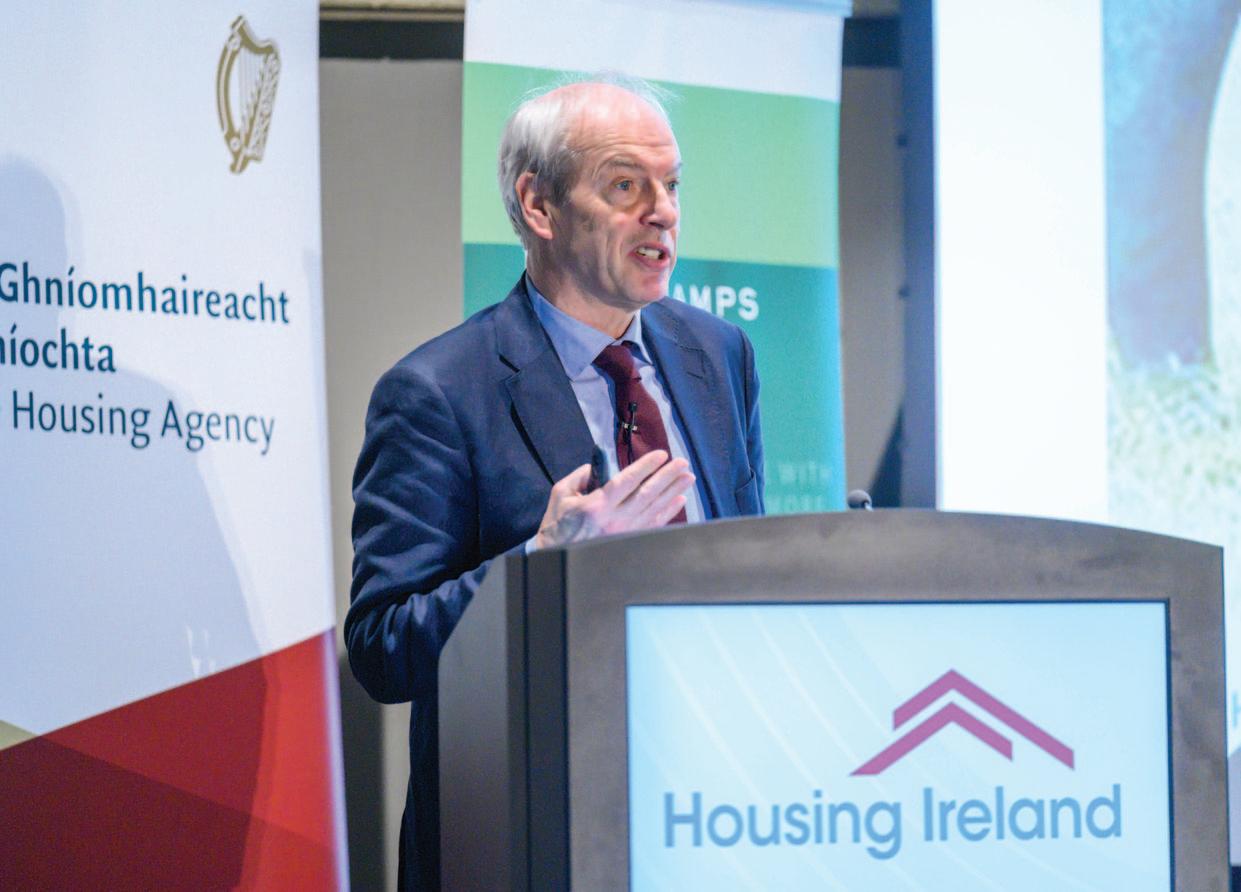
The primary interest of the Commission is to not only establish the features of a good housing system but to also establish how these steps can be implemented.
The Chair explains that a long-term strategic view of housing must give regard to the holistic challenges currently facing the housing system.
Expanding this point further, O’Connor explains that a focus on ‘black swan’ events – those extremely rare events which cause severe damage, but also force re-evaluation and change, such as Covid-19, often means that ‘grey rhino’ events are overlooked. A ‘grey rhino’ event, explains the Chair, is “a highly probable event with a great deal of impact, which is dismissed or overlooked, perhaps because we are not taking it seriously enough”.
To this end, O’Connor points to issues such as the serious undersupply of housing, a crisis in the planning system, and water and wastewater constraints, as prime examples of ‘grey rhino’ issues.
Chair of the Housing Commission, John O’Connor, discusses the key considerations for delivering sustainable policies and outcomes to improve housing.
“These are issues that are obvious, visible, and often charging right at us. They are issues that if not addressed rapidly, will cause severe problems in any efforts for long-term improvements,” he says.
“What is important is that politically and socially, we recognise these events and work together on a cooperative basis to address them.”
O’Connor is quick to point out Ireland’s commitment in 2015 to the Geneva UN Charter on Sustainable Housing, through which it committed to ensuring access to decent, adequate, affordable, and healthy Housing for All.
Stressing the importance of a good housing system, he says: “A house is a home, a place for people to live and to feel secure, be it individuals or as a family. Good housing fosters communities and promotes active participation in society. It is, therefore, absolutely critical to have a good housing system.”
O’Connor states that long-term plans and strategies are critical when restructuring the housing system. Pointing out the importance of Housing for All, and its predecessor Rebuilding Ireland in enabling better joined-up governance in response to challenges, he adds: “We need to ensure that we have long-term planning in place, ideally, moving to a place where policies are not changing between government mandates.”
At present, the Housing Commission is focused on two key areas of sustainable housing supply, and tenure (balance and choice), while also continuing to work towards bringing forward proposals on the wording for a referendum on housing.
Influencing its holistic analysis and preparation of sustainable policies and outcomes, O’Connor highlights, is Ireland’s growing population. Census 2022 shows that the State now has a population of over five million people for the first time in its history. However, it is the
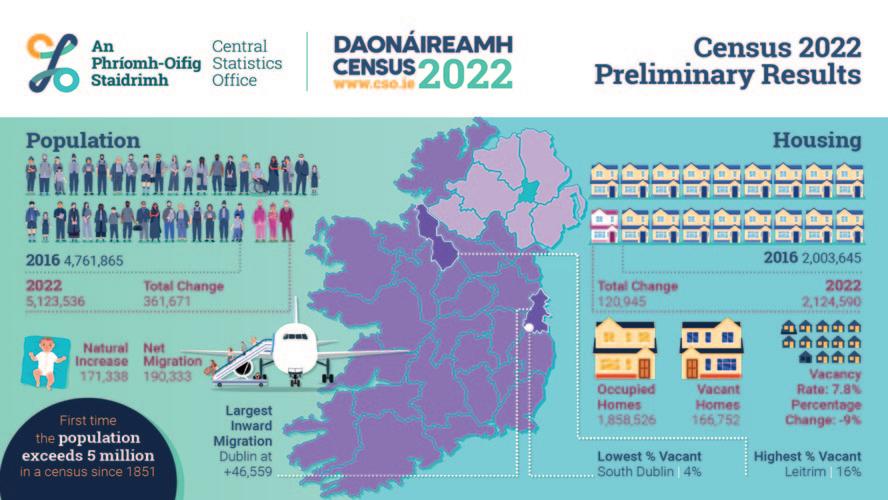
broader impact of this population swell on things like the number of homes occupied (1.86 million) and the average household size (2.75), which O’Connor says should be the focus of long-term policy development.
Source: The Housing Commission.
Current projections are that Ireland will need at least 1.2 million additional homes by 2050, however, O’Connor notes that current household size is higher than it naturally should be, due to the under supply of housing.
Flagging two things of note from the recent CSO figures, the Chair says: “The CSO population figures and projections need to be viewed in the context of household size. You need to examine if there is a pentup demand, which at the moment is higher than it should be.
“Additionally, these figures tell us that people in their 20s and 30s in Ireland are particularly affected by the undersupply of housing, a figure for which Ireland is an outlier within Europe.”
O’Connor concludes by stressing the requirement for planning for sustainable development. Highlighting that long-term policy outcomes are as much about utilising existing stock as they are about new supply, he says: “We need to think of our legacy to our children and the needs of future generations. Decision-makers need to make hard choices.”









Jim Baneham is Director of Delivery at The Housing Agency. Jim graduated from DIT Bolton Street in 1989. He graduated as a Chartered Quantity Surveyor. Soon after he began working with the National Building Agency (NBA) specifically, in the area of delivery of social housing and other local authority facilities.
From 2007, Jim moved into a corporate role within the NBA before moving to The Housing Agency in 2011. It was there he helped develop the AHB funding model. Since then he has gone on to be Head of Housing Supply and Head of the Mortgage Support Section.







Joanna Bannon is a Senior Associate in Fieldfisher’s Real Estate department. She is an experienced and accomplished advisor to many institutional clients in relation to real estate transactions and leads a team servicing volume housing acquisition projects, long terms leasing and residential investment lending. Joanna is also advises developers in relation to the sale of completed units and provides advices in relation to the construction and finance of the sites.

Pat Barry is Chief Executive Officer of the Irish Green Building Council (IGBC) which he co-founded in 2010. He is an Architect with many years of experience in Ireland, Europe and South America, a Masters in Environmental design of buildings from University of Cardiff and is a qualified Passive House and DGNB consultant. The IGBC is an membership organisation of over 360 corporate members with a mission of transitioning Ireland construction sector to sustainability, through advocacy, education and innovation, a partner in Construct Innovate – Ireland’s construction technology centre. IGBC run a number of programmes including Home Performance Index the national certification for quality sustainable new homes and EPD Ireland a programme for Irish construction product manufacturers to transparently declare the environmental impact of their products
Neil Bolton is Head of Housing at Respond. He has over 25 years’ strategic and operational experience in social housing, gained in both the UK and Ireland. He has worked at Executive level in both jurisdictions. In Ireland, Neil was an Operations Director and Property Director with Clúid Housing; in the UK, he was a Customer Services (Property) Director for a SCHT, a large Bath based Housing Association. He also worked in a senior housing role for Bristol City Council. Between 2015- 2017, he served as a non-executive Director for the Irish Council for Social Housing (ICSH). He has also worked as an independent consultant primarily working with social housing organisations. Neil holds a PG Diploma in Housing Studies, a PG Diploma in Business and Executive Coaching, PG Diploma in Organisational Change and is a Chartered Member of the Chartered Institute of Housing.
Hugh Brennan is CEO of Ó Cualann Cohousing Alliance CLG Hugh had worked in various contracting and consulting roles in Ireland before spending 10 years on Humanitarian Aid projects in South Africa and Haiti.





Returning to Ireland, he cofounded Ó Cualann in 2014. Hugh has assumed the lead in developing the Ó Cualann model for affordable housing delivery throughout Ireland. In collaboration with local authorities, other AHB’s and community led housing groups, Ó Cualann plan to deliver over 1,200 homes over the next five years.

Kieron Brennan has been CEO of Co-operative Housing Ireland since 2014. He has extensive experience in the community, voluntary and cooperative sector, which saw him lead the Irish League of Credit Unions from 2008-2014. Prior to this, he held a leadership position as a Programme Manager with POBAL, a not-for-profit community development and financing company, which manages programmes on behalf of the Irish Government and the EU. He was also Irish Manager of Triodos Bank (one of Europe’s largest ethical banks), Executive Director of Clann Credo (social development fund), and Chief Executive of Partas.

Liam Burke is Senior Executive Officer in the Housing and Community Development Department at Fingal County Council. He has over 40 years of local government experience, working mainly within the housing area, and is widely respected across the sector. He manages the delivery of housing support and homeless services in Fingal and the administration of the Tenancy Services Division and has worked extensively on the delivery of Traveller specific accommodation. Liam has led strategic and operational change and is committed to the transformation of systems in the delivery of housing services.
Robert Burns joined Fingal County Council as Director for Housing and Community Development in January 2022. Under the Housing for All policy, Fingal aims to deliver about 4,500 new social and affordable homes throughout the county in the five year period from 2022. Prior to joining Fingal County Council Robert was part of the senior management team within Dún Laoghaire-Rathdown County Council before which he had worked as a Senior Executive Engineer with Clare County Council in the Housing Department. A civil engineering graduate from Queen’s University Belfast, Robert has a wide interest in the fields of housing, sustainable development, transportation, community development, town and village renewal and climate action.





Niall Byrne was appointed as Director of the Residential Tenancies Board (RTB) on 24 January 2022. He joined the RTB from PSI – The Pharmacy Regulator where he served for over five years as Registrar and Chief Officer and was responsible for the regulation of the profession of pharmacy as well as the registration and safety of retail pharmacies. Niall has an extensive background in regulatory affairs, organisation development and corporate governance and holds third-level qualifications in public administration, governance, and human development. Prior to his role with the PSI, Niall held positions as Head of State Boards and Corporate Services with the Public Appointments Service and, for six years, was Deputy Director of Regulation at the Health Information and Quality Authority (HIQA), where he was responsible for the regulation of residential services for older people and for adults with disabilities.












Michael Carey is Chairman of The Housing Agency. Carey has extensive experience in overseeing State bodies, having served as Chairman of Bord Bia (2011-2018), and as Chair of the Grow Dublin Tourism Alliance in 2016. He is the Executive Chairman of The Company of Food, a specialist food investment business, providing equity to start-up and established high-growth food businesses, and is also Chairman of East Coast Bakehouse, Ireland’s largest biscuit manufacturer. He has been involved in several not-for-profit initiatives: Chair of Soul of Haiti Foundation (2009-2015) and Traidlinks Uganda (2013-2016) member, Clinton Global Initiative (2009-2015); and a current member of the Emeritus Advisory Board of Smurfit Graduate Business School.




Louisa Carr is Head of Services with Respond since 2019. She has been working in the housing and homeless sector for over 20 years, working with Sophia Housing Association and Focus Ireland. Louisa has specialised in providing support to families and single persons with complex support needs in both long-term and emergency accommodation. She has experience in managing a variety of other services including early learning and school age care, tenancy sustainment, and family support. Louisa holds an honours degree in social science from UCD, a Certificate in housing management from the National College of Ireland and masters in Leadership and Strategy.


Collete Cassidy is an Associate in the Property department at O’Connor LLP and has acted for a number of housing charities in Ireland. Collete is currently advising extensively in relation to the acquisition of land and houses for social and affordable housing on behalf of a number of Housing Bodies. She has wide experience in the acquisition of development land and the various planning issues, easements and wayleaves, and other property issues that arise in those transactions. Collete has also advised on contractual issues and collateral warranties arising on the building and development of sites.





Padraic Clancy is Director of New Business and Development, leading the Co-operative Housing Ireland Development Team. Padraic has over 25 years in property acquisition and development and holds an Honours Degree in Surveying and a National Diploma in Estate Management. Padraic has managed properties on behalf of NAMA, all major Banks and receivers and is a specialist in property management, security and maintenance. Padraic was previously Head of VPSitex in Ireland, managing the security and maintenance works on large mixed property portfolios for PWC, Mazars, Grant Thornton and Duff and Phelps.
John Coleman has been Chief Executive of the Land Development Agency since its inception in September 2018. John previously held senior roles at Ireland’s National Asset Management Agency (NAMA), worked extensively on the set up of its Residential Delivery division and was its Chief Financial Officer.


John is a graduate of University College Dublin (BComm) and a chartered accountant (FCA). Prior to joining NAMA in 2011 he worked in banking and accountancy.








Sharon Cosgrove is CEO of Oaklee Housing since 2016 and during that time has led significant change and growth in the organisation. Now an independent group structure, Oaklee has a strong diverse team with a passion to make a difference to the lives of tenants and communities in Ireland.


Sharon held a number of previous senior roles in the NGO sector including CEO of the Asthma Society of Ireland and Sonas Housing. She led regeneration and housing programmes in South Dublin and in Bristol City. She holds a B.Sc. (Environmental Health), M.A. (Housing Studies) and a Prof. Dip. (Business Finance). Sharon’s focus over the last three years has been on achieving high standards in customer service, creating a safety and compliance culture, delivering high quality sustainable developments and ensuring the long term financial sustainability of the company. Proud of those achievements as well as Acorn Housing SPV and Oaklee’s involvement in the Comhar consortium, the first social housing PPP bundle in Ireland, Sharon is committed to delivering Oaklee’s new Corporate Plan 2023-25 – delivering more homes through strong partnerships and strengthening communication and engagement with stakeholders.
Kath Cottier was appointed as CEO at Fold Housing in January 2023. She has over 20 years’ experience working in the Irish housing association sector; leading development, property and housing teams. Prior to Fold, at Executive level in Clúid and Clann Housing, she was responsible for front-line services and working to lead the organisations strategic development and growth as well as contribute to strengthening the Housing Association sector. Kath holds a MA in Geography, diplomas in Urban & Community Development and Property and Facilities Management, and an MSc in Management Practice from the Irish Management Institute. She a chartered member of the Chartered Institute of Housing, currently serving as vice chair on their Ireland Board. She is also a founding member of the Construction Defects Alliance lobbying for financial redress for individuals and Housing Associations who bought homes that don’t meet building standards.






Niall Cussen is the Planning Regulator and Chief Executive of the Office of the Planning Regulator, which was established in 2019 to independently assess the statutory spatial plans of the local government sector for their fit with Government planning policy, to conduct reviews of the systems and procedures used by local authorities and An Bord Pleanála in the discharge of their statutory planning functions and in conducting research, training and public awareness in planning. Prior to his appointment in April 2019, Niall was Chief Planner at the Department of Housing, Local Government and Heritage.
Dara Deering is CEO of Home Building Finance Ireland having joined the organisation on 2 September 2019. Dara has extensive experience in Financial Services having previously served as Executive Director and Head of Retail Banking at KBC Bank Ireland plc since February 2012. During that time Dara led the launch and implementation of a new Retail Bank, broadening the range of products and services available, and offering a new banking alternative for Irish consumers. Prior to her time in KBC Dara held a number of leadership positions in the retail financial services industry. She holds an MBA from Smurfit Business School and a Bachelor of Science Management from Trinity College Dublin.

Graham Doyle is Secretary General of the Department of Housing, Local Government and Heritage, having been appointed in July 2020 after the formation of the new Government.


Previously he was Secretary General of the Department of Transport, Tourism and Sport. Graham was an external recruit to the Civil Service in 2013, initially responsible for the Public Transport and Climate Change portfolio. His background is in aviation management and business consulting with experience in insolvency, corporate finance and business strategy. He is a Chartered Accountant by profession, having trained with PwC, and holds a range of business-related qualifications, including an MBA. Beyond his own role, Graham is a member of cross-government groups and boards including, for example, the Civil Service Management Board, the Public Service Leadership Board and the Project Ireland 2040 Delivery Board.
Sinead Dunne joined The Housing Agency as CFO in October 2022. A qualified Accountant by profession she has over 20 years’ experience in leadership roles across the Private and Public Sector having worked with AIB, Accenture, The Institute of Public Administration, Musgraves, South Dublin County Council and more recently Dún LaoghaireRathdown County Council. She holds a BA from UCD along with Diplomas in Leadership Development and Executive Coaching from Smurfit Business School.


Declan Dunne joined Respond as Chief Executive Officer in August 2016.







Declan is an experienced general manager who worked initially building a business over many years and sold to an American multi-national. Declan’s previous role was Chief Executive Officer with Sophia Housing Association. He served as a non-executive Director of the Ballymun Regeneration Board for 10 years, the largest urban regeneration project in Europe, where he chaired the Audit Committee. Declan was Chair of the Housing Alliance from 2019 to 2021. The Housing Alliance is a collaboration of six of Ireland’s largest Approved Housing Bodies (AHBs) and in this capacity he served as a member of the High Level Housing Delivery Group established by the Minister for Housing, Local Government and Heritage, Darragh O’Brien, T.D. He previously chaired the Homeless Network of the major Homeless Agencies in Dublin. He served as a ministerial appointee Board member for two three year terms at the National Education Welfare Board (NEWB), a Statutory Agency which was established to promote school attendance and also chaired its Audit Committee. Declan is actively interested in housing, education, and family services and served on many boards and committees on these issues.








Claire Feeney is the Director for Services and Inclusion in The Housing Agency




Her Directorate consists of approved housing body services, local authority services, the National Housing First Office, and Part V, all who act as centres of excellence in their given areas to support stakeholders. Claire joined Dublin City Council in the late 80’s. She spent time on secondment to the Department of Environment, Community computerising Motor Tax Offices and moved back to Dublin City Council in 2003 and had responsibly for a number of the Regeneration Projects. She moved to the Limerick Regeneration Agencies in 2007 working as the Project Manager for the Physical and Economic Regeneration. In 2012 Claire moved to the Housing Agency to manage the Mortgage to Rent Scheme nationally and drive the National Housing Strategy for Disabled People 2022-2027.
With over 20 years’ experience in housing services, disability rights and community engagement, Aoife Flynn Kennedy was appointed as Head of Clann in January 2020 and has more recently added the area of Estate Services to her remit. Prior to her current role, Flynn Kennedy worked for seven years in the disability sector, supporting people in their move from congregated settings into their own homes. Before that, she worked for three different local authorities in the areas of housing, access, and equality. Outside of work, she is a community activist and is involved locally in addiction services, establishing Bray as the next autism friendly town and she chairs a local Approved Housing Body (AHB) as well.
Tom Gilligan is Director of Services at Mayo County Council with responsibility for Housing, Roads, Service Development and the Ballina Municipal District. An Accountant with an MBA in Local Government, prior to joining Mayo, Tom worked as the Head of Finance in both Limerick and Waterford County Councils’ and was a central figure in the successful reform of local government arrangements in both locations. Founder of the popular crowd-sourcing, portal website VacantHomes.ie which Mayo County Council is the lead authority on behalf of the Local Government Sector, Tom is a key influencer and change leader in the whole area of vacancy and bringing vacant homes back into use.

















Barry Gorman is the National Renewables Sales Manager at leading heating technology manufacturer Grant and has over 20 years’ experience in the heating sector. Barry is responsible for helping to advance the deployment of renewables in Ireland through Grant’s award-winning sustainable and highly efficient heating technologies including the A+++ rated, Grant Aerona3 R32 air to water, air source heat pump range, HVO biofuel compatible Grant Vortex condensing boiler range, Grant SpiraPell condensing wood pellet boiler range and associated products. Barry leads the team working closely with local authorities and developers across the country to support social housing projects, new build developments and retrofit projects to provide integrated heating solutions.
John Hannigan is Chief Executive Officer of Circle Voluntary Housing Association. He took up his current position in September 2017. John previously held the position of Managing Director of Sunbeam House Services since 2010. Prior to that, he worked as Finance Director with Respond Housing Association. John is currently the Chair of The Housing Alliance, an alliance of six of the largest Housing Associations in Ireland. John has more than 30 years’ experience in the Social Housing sector in the UK and Ireland. He is also a Trustee of the Governing Board of the Chartered Institute of Housing in the UK and Ireland and Chairs the CIH in Ireland. John is also a Chartered Director and a Fellow of the CIH. John is also a Board Member of Clanmil Group in Northern Ireland.



Roger Harrington is a Principal Officer at the Department of Housing, Local Government and Heritage. He has responsibility for managing the Capital Advance Leasing Facility (CALF), the Mortgage to Rent scheme and working with the Housing Agency in the context of the acquisitions fund (HAA). CALF and the HAA are funding mechanisms which assist both the Housing Agency and approved housing bodies to build, acquire and make available housing units for social housing use whilst the MTR scheme is a social housing option for eligible borrowers in severe mortgage arrears.
Veronica Harrington has 25 years’ senior leadership experience in the utilities industry in a range of roles covering asset management and customer operations. Most recently as Connections Services Manager she is leading the Connections Developer Services strategy to improve customer focus and building on Uisce Éireann’s first Connection Charging Policy. She is leading the implementation of First Mover initiative and Self Lay in Public Road Programmes which will enhance the Connection Charging Policy. Veronica is working closely with the Department of Housing, Local Government and Heritage Water Services to implement the new initiative allowing customers to be refunded for standard connection charges for domestic housing as set out in circular PL/04/2023. Veronica and her team work closely with the construction sector to support the industry provide homes.


Yvonne Harris has extensive experience working in utilities and currently holds the position of Head of Customer Operations and Housing Programme Director in Uisce Éireann. Her primary responsibilities are customer strategy, customer services and billing services for the water utility. Yvonne is also responsible for managing the Connection Developer Services function which supports domestic, commercial and developer clients in connecting to the water and wastewater network. With the launch of the Housing for All strategy, Uisce Éireann established a programme of work, led by Yvonne, to ensure the utility continues to support and improve the delivery of connections, including housing, in a timely and efficient way. Direct engagement with key stakeholders, including housing bodies and housing developers, has been a key aspect of Uisce Éireann’s approach. Yvonne holds a Bachelor of Business studies, a Masters’ in Business Practise and a Diploma in Company Direction. Yvonne is a Chartered Director and is a member of the Institute of Directors Ireland.




Peter Hesse is Principal Officer responsible for projects, procurement and programmes with The Housing Agency. Programmes include the Pyrite Remediation Scheme and the Defective Concrete Blocks Grant Scheme. He has extensive private sector and international construction management experience, and was previously Head of Surveying at the National Building Agency. His education includes B.Sc. (Surveying), MBA, M.Sc. (Planning and Development) and postgraduate diploma in construction law and contract administration.
Parag Joglekar is Director of Investment and Development at Respond. Parag is a registered Architect in Ireland and the UK. He holds a Master’s degree in Architecture (distinction) from University of Leuven, Belgium and a Post Graduate Diploma (distinction) in Real Estate Investment Finance from Oxford Brookes University (UK). Parag is a member of the Royal Institute of Architects of Ireland (RIAI) and the Architects Registration Board (ARB) in the UK. Parag has worked in both the private and semi-private sector in Ireland, UK and India. He has extensive experience of over 25 years in Urban Design, Private and Public Housing, Regeneration, Commercial projects, Risk & Asset Management in addition to managing design & construction contracts.
Bob Jordan was appointed CEO of The Housing Agency in September 2021. He has a strong leadership record in the housing sector. Between 2018 and 2021 he was the National Director of the Government's Housing First programme, which provides permanent homes and wraparound supports to people who have experienced rough sleeping and longterm homelessness. Based in Dublin City Council, he worked closely with local authorities, approved housing bodies, health services and homeless charities to extend the programme nationwide. Prior to his role in Housing First, Bob was Chief Executive of the housing charity Threshold for nearly a decade. He was Special Adviser to the Minister for Housing during 2016-2017.














In 2015 Catherine Keenan took up the role of Director of Housing in Dún Laoghaire-Rathdown County Council, with an overarching leadership role in all aspects of social and affordable housing delivery. Her role includes making the best use of housing stock including management, maintenance and retrofitting homes and provision of homeless, allocations and welfare services. Prior to this Catherine was the Chief Executive Officer of dlr Leisure Services from 2013 to 2015 which followed her position as Senior Executive Officer over a number of years in Dún Laoghaire-Rathdown County Council.

Vincent Keenan was appointed Chief Executive of North & East Housing Association in 2014, he has some 30 years’ experience in homelessness, housing management and development.





Vincent is Chairperson of The Wheel, Ireland’s national association of community and voluntary organisations, charities and social enterprises. Vincent has participated in social partnership agreements and has served on the National Homeless Consultative Committee. He is a Chartered Member of the CIH and holds qualifications in Housing management, community development, counselling and has BSc (Hons) Degree in Business Studies from Ulster University and a Post Graduate Certificate is Not For Profit Leadership. Vincent has completed the Chartered Director Programme with the Institute of Directors and is a Chartered Director.
Dave Kirwan is Managing Director of Bord Gáis Energy’s vision for his organisation is to lead the energy transition in Ireland through the investment and development of net zero energy solutions across the whole value stream. Bord Gáis Energy has committed to being net zero by 2045 and helping its customers be net zero by 2050. The company’s purpose of helping customers live sustainably, simply and affordably drives its strategy and is being made possible with the investment and backing of Centrica’s board and balance sheet. Dave returned to the role of MD in Summer 2020 having completed a successful term in the UK as Managing Director of the UK Customer Operations and latterly MD of the UK Home business. Dave was responsible for leading the Bord Gáis Energy business through the successful sale to Centrica in 2014 and prior to that had worked in Bord Gáis Éireann for 15 years. Dave holds a BE electronics from UCD and is a Fellow of the Institute of Engineers of Ireland, he also holds an MBA from UCC and a doctorate in business economics (DBA) from UCC. Dave also serves on the Centrica Group Executive Committee.




Rob Lowth is National Director of the National Office for Housing First. He is a former housing senior executive officer, housing maintenance manager and coordinator of homeless services at Limerick City and County Council, in a local government career that began in 2003. He previously worked as a project manager in the technology sector. Rob holds technical qualifications in computer systems and in 2013 he completed a BA in management at the Institute of Public Administration.
Susanna Lyons is the CEO of the Approved Housing Bodies Regulatory Authority (AHBRA)












Susanna is responsible for the day-today management of AHBRA. She has over 30 years of experience in risk, financial management, strategy and governance. Susanna spent five years with the Regulation Office in the Housing Agency, focusing on the provision of AHB voluntary regulation. Prior to that Susanna spent 25 years working for a number of US multinationals with a focus on finance and risk.
Donald MacDonald is a Director of Hooke & MacDonald with 20 years multi-disciplinary experience including urban planning, property design and development, appraisals, property management and disposals (14 years with Hooke & MacDonald); real estate development lending (two years), financial accounting and auditing (four years with Grant Thornton). He is a Fellow of Chartered Accountants Ireland and has a Masters in Planning and Development. Donald is a key member of Hooke & MacDonald’s capital markets team and regularly represents the company at domestic and international real estate events. This, along with Donald’s hands on day to day engagements in sales and management roles, assists the company in keeping fully abreast of market trends and best practice. He is generally regarding as being one of the country’s leading experts in the public and private housing sectors.
Donal McManus is CEO at Irish Council for Social Housing (ICSH), the national federation of housing associations which has 270 active housing association members throughout the country. He previously worked since the 1990’s in the public/local authority and housing association sectors in Scotland and Northern Ireland. He specifically worked in areas of housing development, self-build and regeneration, housing management, including homelessness and special needs as well as policy and finance. He had also worked in urban design and land assembly within the private sector. Donal was president of the nonprofit housing section of Housing Europe, chair of the European Housing Forum and FEANTSA. From 2003-2005 he was appointed a member of the UN-ECE Task Force on Social Housing. He is a graduate in Housing from Ulster University, and Urban Design from Strathclyde University School of Architecture Glasgow. He received a doctorate in Governance from Queen’s University Belfast, School of Law on financialisation and impact of private finance on housing association delivery. Donal was previously a board member of the Housing Agency and member of its Audit and Risk Committee. Donal is currently Chairperson of Housing Europe Working Group on Economics, Finance and EU Internal Market and he represents the ICSH on a number of National Social and Affordable Housing Working Groups.
Fidelma McManus is a Partner and heads up Beauchamps’ specialised Housing team. She is the go-to expert in complex conveyancing and an acknowledged market leader in the acquisition and management of social and affordable housing. Her practice includes all aspects of conveyancing including the acquisition, structuring, financing, disposal and leasing of all types of property, including multi-unit developments, distressed and partially complete residential developments, shopping centres, retail parks and offices. She also advises on landlord and tenant law. Fidelma works closely with local authorities, state agencies, charities, Approved Housing Bodies (AHBs), lending institutions, pension funds, sporting bodies, receivers and developers including institutional and private investors.


Niall O’Brien is a Partner in the Banking and Finance team at Beauchamps





Niall works extensively with major domestic and international financial institutions in the areas of corporate lending including acquisition finance, construction finance, project finance and secured lending. He has extensive experience in advising the main participants in the housing sector including lenders, developers, AHBs, contractors, and Irish and international corporations.


Darragh O’Brien TD was appointed Minister for Housing, Local Government and Heritage in June 2020. He is an elected TD for the constituency of Dublin-Fingal. Prior to his election to the 30th Dáil in 2007, Minister O’Brien worked mainly in Financial Services and was elected to Fingal County Council in 2004. He was elected to Seanad Éireann in 2011. He has held various positions within the Oireachtas including Vice-Chairperson of the Public Accounts Committee, Member of the Oireachtas Committee on Justice, Equality, Defence and Law Reform, Leader of Fianna Fáil in the Seanad and Opposition Frontbench Spokesperson on Dublin, Foreign Affairs and Housing.


Joining Clúid in 2022, Niall Ó Ceallacháin is Clúid’s Chief Operations Officer (COO). Niall has 18 years’ experience across the not-for-profit and financial services sectors. Most recently, Niall held the role of Chief Financial Officer and Global Director of Business Development with the international NGO, GOAL. Niall holds a Bachelor of Business Studies from DCU, is a fellow of the ACCA and holds diplomas in Leadership and Organisational Development and Transformation from the IMI. As COO, Niall brings leadership and strategic direction to Clúid's customer-facing services, the housing and property departments – establishing a single customer experience for residents.
Eibhlín O’Connor is Clúid Housing's Acting Chief Commercial Officer and Head of the Commercial Development, with responsibility for driving Clúid’s ambitious delivery programme, setting Clúid's design standards, and managing Clúid's construction and housing development risk. Eibhlín is a chartered member of the Royal Institute of Architects of Ireland and holds a Master's in Construction Law and Dispute Resolution from King's College, London, and a Post Graduate Diploma in Construction Law and Contract Administration from Trinity College Dublin. With over 20 years' experience working in the construction industry, Eibhlin has worked at a senior level with key stakeholders, local authorities and developers in the delivery of social housing.













Ruth


Ruth O’Connor is a Partner in the Property department at O’Connor LLP and has established an impressive portfolio of corporate and commercial clients particularly in the area of commercial property. Ruth has advised clients on the acquisition, sale and leasing of corporate headquarters, retail and office premises along with development lands and advises private clients in relation to residential property matters. She has advised Charitable Trustees on their duties and responsibilities and deals with all aspects of the management and administration of Charitable Trusts and Charitable Organisations.


Stephen O’Connor is Managing Director at Electric Ireland Superhomes




Stephen has 25 years’ experience in the energy and telecom industries both in the public and private sector, working across corporate finance and public policy. A former Director of Corporate Finance at KPMG, Stephen spent two terms at the Department of Environment, Climate and Communications working as Special Adviser to the Secretary General and also as Energy Policy Adviser to The Minister. Most recently, Stephen was Director of Corporate Affairs at SIRO (an ESB-Vodafone joint venture) from 2015 until 2020. He holds a primary degree in Commerce and a Masters in Accounting, both from UCD and is a fellow of the Institute of Chartered Accountants in Ireland.
Kieran O’Donnell TD is the Minister of State at the Department of Housing, Local Government and Heritage with responsibility for Local Government and Planning, appointed in December 2022. He is the Fine Gael TD for Limerick City Constituency. First elected in May 2007, he was re-elected in 2011 and 2020. He has previously served as Chairperson of the Oireachtas Transport and Communications Committee, Vice-Chairperson of the Public Accounts Committee( PAC), a member of the Banking Inquiry, and a member of the Oireachtas Finance and Budgetary Affairs Committees. He was previously spokesperson on Finance for Fine Gael. He was elected to the Seanad in 2016. Prior to his entry into national politics, he was elected to Limerick County Council in 2004. Minister O’Donnell is a Chartered Accountant, with many years of experience with his own practice and is a business studies degree graduate from the University of Limerick (UL).












Brian O’Gorman is the CEO of Clúid Housing, one of the largest approved housing bodies (AHBs) in Ireland, with a portfolio of assets in excess of 1 billion. Brian leads an award-winning team of over 300 qualified professionals who are delivering a housing pipeline of new social and cost rental homes. Clúid has an ambitious delivery target of more than 1,000 new homes every year. In 2022, Brian oversaw the delivery of Clúid's 10,000th home into management. Brian is a resolute advocate of the important role of social and cost rental housing, the quality and design of which makes it indistinguishable from any other housing. His vision mirrors Clúid’s philosophy to prolong the life of buildings and their environment by investing in sustainability and future capacity. The performance and quality of Clúid’s current housing stock is very much evidence of this. Brian served on the board of the Housing Commission from 2021 to 2023.
Thomas O’Malley is a Real Estate Partner at Philip Lee specialising in commercial real estate with a focus on social housing and development land. Thomas works closely with colleagues in the Construction Law team at Philip Lee advising on development agreements which provide for design and build of “turnkey” projects to be leased to meet social housing needs. He acts for investors, property developers, housing and government bodies on large-scale, mixed retail, commercial, and residential projects. Additionally, he advises on the property elements of renewable energy projects. Thomas has over 30 years’ experience in advising clients on site assembly and development agreements, highvalue property acquisitions and disposals, complex title structures, joint ventures/collective property investments, and business leases. He is a CEDR (Centre for Effective Resolution Dispute) Mediator, which allows him to advise on a variety of property-related disputes. Legal 500 describes him as ‘tenacious’ and ‘good at getting deals over the line.’

Denis O’Sullivan joined Bord Gáis Energy as Director of Assets in July 2023. Bord Gáis Energy aims to lead the energy transition in Ireland and this is being made possible with the investment and backing of Centrica’s board and balance sheet. Denis is responsible for overseeing investment in and delivery of upstream opportunities to assist in delivering Ireland’s net zero commitments. Before joining Bord Gáis Energy, Denis worked in Ervia where held a number of senior management roles including Networks Managing Director and Chief Operating Officer. There he oversaw the development of a decarbonisation strategy and expansion of the gas network including the introduction of biomethane and establishment of CNG refuelling network. Prior to Gas Networks Ireland, Denis worked for 15 years in the wind energy and waste to energy sectors, including leading the delivery of Bord Gáis Energy’s windfarm portfolio prior to its sale in 2014.






Breen Purcell is a Partner and Head of the Real Estate Department at Fieldfisher LLP. He has acted in property-based lending transactions over the past 20 years and has considerable experience in the acquisition and disposal of residential and commercial property. He regularly acts for landlords and tenants in the negotiation and drafting of commercial leases and advises on planning and licencing matters. He works with a client base of vendors, and developers, borrowers and lenders in managing all types of acquisitions, disposals and property financing.



Teresa Purtill is Director of Services and Solutions at Bord Gáis Energy. Teresa is responsible for the growth of Bord Gáis Energy’s services and solutions business, driving the revenue and commercial strategies for the organisation. Having previously held the role of Customer and Field Operations Director within Bord Gáis Energy, Teresa was focused on driving the company’s customer experience strategy, business excellence and strategic programme delivery. Prior to joining Bord Gáis Energy, Teresa was Global VP for Customer Care for the Hertz Corporation leading an organisation of over 2,000 people across 15 sites globally. Teresa’s background is in driving change programs and transformation in operating models, revenue generation and process efficiency through lean six sigma. Teresa holds an MA in European Integration from the University of Limerick and is the Bord Gáis Energy Ambassador for Neurodiversity.

Niamh Randall is Head of Advocacy and Communications and Spokesperson with Respond. An experienced policy, advocacy and strategic communications professional, Niamh has over 20 years’ experience working in the areas of housing, homelessness and inclusion. She is a member of the Board and Council of the Irish Council for Social Housing and the Housing Agency’s Research and Insights Panel. Previously Niamh worked with the Simon Communities of Ireland and Merchants Quay Ireland. Niamh was the Irish representative on the Administrative Council of FEANTSA (European umbrella group of organisations working on homelessness) from 2011-2013 and was nominated onto to the Expert Health Working Group and the Women and Homelessness Expert Working Group. Niamh holds an MSc from Trinity College Dublin with qualifications in housing; sociology and social policy; human rights and equality; drug policy; community studies; and finance and is a Chartered Institute of Housing certified practitioner.

Angelyn Rowan is a Partner in the Projects and Construction team at Philip Lee. Angelyn has extensive experience advising funders, developers, employers and contractors on all aspects of the procurement and construction of major projects. She has advised public sector bodies on the procurement of several State projects including the National Development Finance Agency on the first healthcare and social housing public private partnerships in Ireland. In addition to her PPP and procurement experience, Angelyn advises on a wide-range of construction law matters, both contentious and non-contentious, including renewables projects, commercial office, social housing, education and healthcare. Angelyn is recognised in both Chambers and Legal 500 for her expertise in projects and construction.


David Silke is Director of Insights and Operations in The Housing Agency His Directorate includes research, policy and practice, communications, training and development, HR, ICT and facilities. Previous roles include Director of the Centre for Housing Research, Policy Analyst in the National Economic and Social Forum, Researcher in the Combat Poverty Agency, and Senior Researcher in the Department of Social Security (UK). His qualifications include a Degree in Social Science (UCD), a Masters in Social Policy and Planning (LSE); and Professional Diplomas in Governance (IPA), Business and Finance (IMI) and Strategy and Innovation (IMI). David is a Chartered Member of the Chartered Institute of Housing.
Paddy Smyth is a Partner in Fieldfisher LLP’s Real Estate team. He is a recognised expert in commercial property and real estate finance with a particular focus on residential development. Paddy is passionate about the delivery of social and affordable housing in Ireland. He and the team at Fieldfisher regularly act for developers, funders, local authorities and approved housing bodies in transactions at all stages of the housing delivery process from land acquisition, development funding and construction through to delivery to local authorities and AHBs.
















Richard Stowe is a projects and construction lawyer, heading up the Beauchamps construction team, with over 25 years’ experience in specialist construction practices in Ireland and Australia both in contentious and noncontentious roles. He is has had extensive experience advising in relation to a large number of high value infrastructure and construction projects in both jurisdictions. Since returning to Ireland, Richard has been engaged primarily in property development work, particularly in the social and affordable housing sphere. His expertise includes drafting and advising on contracts for building and engineering works at all tiers, contracts for design consultancy services, project/construction management services, FM/OM services, collateral warranty documentation and agreements for all facets of PPP project work, property development and infrastructure provision.



Caroline Timmons is Acting Assistant Secretary at Department of Housing, Local Government and Heritage since 2021 where she is the head of the Housing Affordability, Inclusion and Homelessness Division, with responsibility for a range of actions under the Programme for Government and under the Housing for All strategy. She is a barrister who previously worked in private practice for a number of years before joining the Attorney General’s Office as Advisory Counsel and subsequently was legal advisor to the Department of Children and Youth Affairs. She joined the Department of Housing, Local Government and Heritage in 2016, where she has worked in both planning and housing policy divisions. She was a member of the board of the Land Development Agency from 2018 until 2022 and is currently a director of the board of the First Home DAC. In addition to her legal qualifications, she holds a diploma in Public Management and a masters in Leadership and Strategy.

William Walsh is Chief Executive Officer in SEAI, having previously held the position of both Chief Operations Officer and Chief Financial Officer. William joined SEAI in 2013. Prior to joining SEAI he worked for Inland Fisheries Ireland (IFI) where he held a number of roles including Assistant Chief Executive Officer and Director. Prior to that he held senior management positions in the private sector. William is a Chartered Accountant, holds a Bachelor of Business Studies from Dublin City University and a Graduate Diploma in Strategy, Innovation and Change from UCD.


The following is an A-Z list of organisations and individuals involved in the Irish housing sector including government contacts, housing associations and advisors.
Department of Housing, Local Government and Heritage
Custom House, Dublin, D01 W6X0
Tel: 01 888 2000
Web: www.gov.ie/housing
Newtown Road, Wexford, Y35 AP90
Tel: 053 911 7500
Government Offices, Ballina
Co Mayo, F26 E8N6
Tel: 096 24200
Minister: Darragh O’Brien TD
Tel: 01 888 2403
Email: minister@housing.gov.ie
Minister of State, Local Government and Planning: Malcolm Noonan TD
Tel: 01 888 2597
Email: ministerofstate@housing.gov.ie
Minister of State, Heritage and Electoral Reform: Kieran O’Donnell TD
Email: MOS@housing.gov.ie
Secretary General: Graham Doyle
Assistant Secretary, Social Housing
Delivery: Aine Stapleton
Assistant Secretary, Housing Policy, Legislation and Governance: Feargal Ó Coigligh
Acting Assistant Secretary, Housing Affordability, Inclusion and Homelessness: Caroline Timmons
Acting Assistant Secretary, Planning: Paul Hogan
Joint Committee on Housing, Local Government and Heritage
Leinster House
Kildare Street
Dublin, D02 XR20
Tel: 01 618 3325
Email: jchlgh@oireachtas.ie
Clerk to the Committee: Anne-Marie Lynch
Committee membership
Deputies
Francis Noel Duffy, Green Party
Joe Flaherty, Fianna Fáil
Thomas Gould, Sinn Féin
Emer Higgins, Fine Gael
Steven Matthews, Green Party (Chair)
Paul McAuliffe, Fianna Fáil (Deputy Chair)
Cian O'Callaghan, Social Democrats
Richard O'Donoghue, Independent
Eoin Ó Broin, Sinn Féin
Senators
Victor Boyhan, Independent
John Cummins, Fine Gael
Mary Fitzpatrick, Fianna Fáil
Rebecca Moynihan, Labour Party
Mary Seery Kearney, Fine Gael
An Bord Pleanála
64 Marlborough Street, Dublin 1
D01 V902
Tel: 01 858 8100
Email: bord@pleanala.ie
Director of Planning: Ciara Kellett
Approved Housing Bodies

Regulatory Authority
4th Floor, Grattan House, Dublin 2
D02 H638
Tel: 01 224 3900
Web: www.ahbregulator.ie
Email: info@ahbregulator.ie
Chair: Eddie Lewis
Chief Executive: Susanna Lyons
Home Building Finance Ireland
Treasury Dock Wall Quay Dublin 1
D01 A9T8
Tel: 01 238 4600
Email: info@hbfi.ie
CEO: Dara Deering
Housing Agency
53 Mount Street Upper
Dublin, D02 KT73
Tel: 01 656 4100
Web: www.housingagency.ie
Email: info@housingagency.ie
Chair: Michael Carey
Chief Executive: Bob Jordan
Director of Insights and Operations: David Silke
Chief Financial Officer: Sinead Dunne
Director of Delivery and Innovation: Jim Baneham
Director of Services and Inclusion: Claire Feeney
Principal Officer, Projects and Procurement: Peter Hesse
Housing Finance Agency
46 St Stephen’s Green
Dublin 2
Tel: 01 872 5722
Web: www.hfa.ie
Email: cosec@hfa.ie
Chief Executive Officer: Barry O’Leary
Land Development Agency
2nd Floor, Ashford House
Tara Street, Dublin 2
D02 VX67
Tel: 01 910 3400
Web: www.lda.ie
Email: info@lda.ie
Chief Executive: John Coleman
National Construction Training Centre
Mount Lucas
Daingean, Co Offaly
Tel: 057 936 2508
Office of the Planning Regulator
Fourth Floor (West Wing) Park House
Grangegorman
191-193A North Circular Road
Dublin 7, D07 EWV4
Tel: 01 854 6700
Web: www.opr.ie
Email: info@opr.ie
Chief Executive and Planning Regulator: Niall Cussen
Uisce Éireann
Colvill House
24–26 Talbot Street Dublin
Tel: 01 707 2827
Web: www.water.ie
Managing Director: Niall Gleeson
Housing Programme Director: Yvonne Harris
Residential Tenancies Board
PO Box 47
Clonakilty
Co Cork
Tel: 0818 303 037
Web: www.rtb.ie
Chair: Tom Dunne
Director: Niall Byrne
Sustainable Energy Authority of Ireland
3 Park Place
Hatch Street Upper Dublin 2
Co Dublin
D02 FX65
Tel: 01 808 2100
Web: www.seai.ie
Email: info@seai.ie
Chief Executive: William Walsh
Tailte Éireann
Web: www.tailte.ie
Email: info@tailte.ie
CEO: Liam O’Sullivan
Registration Division — Tailte Éireann
Chancery Street
Dublin 7, D07 T652
Registry of Deeds
Henrietta Street
Dublin 1, D01 EK82
Valuation Division — Tailte Éireann
Block 2, Irish Life Centre
Abbey Street Lower Dublin 1, D01 E9X0
National Mapping Division — Tailte
Éireann
Phoenix Park Dublin 8, D08 F6E4
Carlow County Council
County Buildings, Athy Road
Carlow, R93 E7R7
Tel: 059 917 0300
Web: www.carlow.ie
Chief Executive: Michael Rainey
Director of Services, Community, Housing, Recreation and Amenity: Michael Brennan
Cavan County Council
Ground Floor, Johnston Centre
Farnham Street
Cavan, H12 C9K1
Tel: 049 437 8300
Web: www.cavancoco.ie
Email: housing@cavancoco.ie
Chief Executive: Tommy Ryan
Director of Services, Housing, Libraries and Cultural Services, Human Resources and Corporate Services: Eoin Doyle
Clare County Council
New Road, Ennis
Co Clare, V95 DXP2
Tel: 065 6846334 or 065 6846403
Web: www.clarecoco.ie
Email: housing@clarecoco.ie
Chief Executive: Pat Dowling
Director of Social Development: Anne Haugh
Housing Department, Senior Executive
Officer: Padraig MacCormaic
Cork City Council
Housing and Community Directorate
City Hall, Anglesea Street
Cork, T12 T997
Tel: 021 492 4000
Web: www.corkcity.ie
Email: housing@corkcity.ie
Chief Executive: Ann Doherty
Director of Housing: Niall Ó Donnabháin
Cork County Council
County Hall
Carrigrohane Road
Cork, T12 R2NC
Tel: 021 427 6891
Web: www.corkcoco.ie
Email: housing@corkcoco.ie
Chief Executive: Tim Lucey
Housing Director: Maurice Manning
Donegal County Council
County House, The Diamond Lifford, Co Donegal, F93 Y622
Tel: 074 915 3900
Web: www.donegalcoco.ie
Email: info@donegalcoco.ie
Chief Executive: John McLaughlin
A/Director of Housing, Corporate and Cultural Services: Patsy Lafferty
Dublin City Council
Housing and Community Department
Block 1, Floor 1
Civic Offices
Wood Quay Dublin 8, D08 RF3F
Tel: 01 222 2222
Web: www.dublincity.ie
Email: allocations@dublincity.ie
Chief Executive: Owen P Keegan
Assistant Chief Executive, Housing and Community: Coilín O’Reilly
Director of Dublin Regional Homeless
Executive: Mary Hayes
Director of Housing Delivery: Dave Dinnigan
City Architect: Ali Grehan
County Hall, Marine Road
Dún Laoghaire
Co Dublin, A96 K6C9
Tel: 01 205 4700
Web: www.dlrcoco.ie
Email: housing@dlrcoco.ie
Chief Executive: Frank Curran
Director of Housing: Catherine Keenan
Fingal County Council
County Hall, Main Street
Swords, K67 X8Y2
Tel: 01 890 5994
Web: www.fingal.ie
Email: housing@fingal.ie
Chief Executive: AnnMarie Farrelly
Director Housing and Community
Department: Robert Burns
Senior Executive Officer, Housing Support: Liam Burke
Senior Architect: Carmel Brennan
Galway City Council
City Hall, College Road
Galway
H91 X4K8
Tel: 091 536 400
Web: www.galwaycity.ie
Email: customerservice@galwaycity.ie
Chief Executive: Brendan McGrath
A/Director of Services: Brian Barrett
Galway County Council
Áras an Chontae
Prospect Hill, Galway
H91 H6KX
Tel: 091 509 300
Web: www.galway.ie
Email: housing@galwaycoco.ie
Interim Chief Executive: Jim Cullen
Housing Director: Liam Hanrahan
Kerry County Council
County Buildings
Rathass, Tralee, Kerry
V92 H7VT
Tel: 066 7183 862
Web: www.kerrycoco.ie
Email: housing@kerrycoco.ie
Chief Executive: Moira Murrell
Director of Housing and Human Resources: Martin O’Donoghue
Kildare County Council
Áras Chill Dara
Devoy Park, Naas
Co Kildare, W91 X77F
Tel: 045 980 705
Web: www.kildarecoco.ie
Email: housingadmin@kildare.ie
Interim Chief Executive: Sonya Kavanagh
Director of Housing: Annette Aspell
Kilkenny County Council
Housing Office
John’s Green House
John’s Green
Kilkenny, R95 CX92
Tel: 056 779 4900
Web: www.kilkennycoco.ie
Email: housing@kilkennycoco.ie
Interim Chief Executive: Sean McKeown
Director of Services, Housing: Mary J Mulholland
Laois County Council
Áras an Chontae
JFL Avenue, Portlaoise
Co Laois, R32 EHP9
Tel: 057 866 4000
Web: www.laois.ie
Email: housinglcc@laoiscoco.ie
Chief Executive: John Mulholland
A/Director of Housing: Angela McEvoy
Leitrim County Council
Áras an Chontae
St George’s Terrace, Townparks
Carrick on Shannon
Co Leitrim, N41 PF67
Tel: 071 965 0426
Web: www.leitrimcoco.ie
Email: housing@leitrimcoco.ie
Chief Executive: Lar Power
Director of Services – Housing, Corporate Services, Community and Cultural Services: Mary Quinn
Limerick City and County Council
Merchant’s Quay, Limerick
V94 EH90
Tel: 061 556000
Web: www.limerick.ie
Email: customerservices@limerick.ie
Chief Executive: Pat Daly
Director of Housing: Caroline Curley
Longford County Council
Town Hall, Market Square
Longford, N39 C5F2
Tel: 043 334 3499
Web: www.longfordcoco.ie
Email: housing@longfordcoco.ie
Chief Executive: Paddy Mahon
Director of Services: John Brannigan
Louth County Council
County Hall
Millennium Centre
Dundalk, A91 KFW6
Tel: 042 933 5457
Email: housing@louthcoco.ie
Chief Executive: Joan Martin
Director of Services: Paddy Donnelly
Mayo County Council
College House
Station Road, Swinford
Co Mayo, F12 V126
Tel: 094 906 4510
Email: housing@mayococo.ie
Chief Executive: Kevin Kelly
Director of Services: Tom Gilligan
Head of Housing: Simon Shevlin
Meath County Council
Buvinda House
Dublin Road, Navan
Co Meath, C15 Y291
Tel: 046 909 7000
Email: housing@meathcoco.ie
Chief Executive: Jackie Maguire
Director of Services: Barry Lynch
Monaghan County Council
Housing Department
County Offices, The Glen
Monaghan, H18 YT50
Tel: 047 30516
Email: noconnor@monaghancoco.ie
Chief Executive: Patricia Monahan
Director of Services: Olga McConnon
Offaly County Council
Housing Section
Áras an Chontae
Charleville Road
Tullamore, Co Offaly
R35 F893
Tel: 057 934 6800
Email: housing@offalycoco.ie
Chief Executive: Anna Marie Delaney
Director of Housing: Sharon Kennedy
Roscommon County Council
Áras an Chontae Roscommon
Co Roscommon, F42 VR98
Tel: 090 663 7100
Web: www.roscommoncoco.ie
Email: housing@roscommoncoco.ie
Chief Executive: Eugene Cummins
Director of Services: Majella Hunt
Sligo County Council
Housing Section
County Hall Riverside
Sligo, F91 Y763
Tel: 071 9111 111
Email: info@sligococo.ie
Chief Executive: Martin Lydon
Director of Housing and Corporate: Jim Molloy
South Dublin County Council
County Hall Tallaght
Dublin 24, D24 A3XC
Tel: 01 414 9000
Web: www.sdcc.ie
Email: info@sdublincoco.ie
Interim Chief Exceutive: Colm Ward
Tipperary County Council
Civic Offices, Clonmel
Nenagh, Co Tipperary
Tel: 076 106 5000
Web: www.tipperarycoco.ie
Chief Executive: Joe MacGrath
Director of Services, Housing: Sinead Carr
Waterford City and County Council
Housing Department
Bailey's New Street
Waterford, X91 XH42
Tel: 0818 10 20 20
Email: contact@waterfordcouncil.ie
Chief Executive: Michael Walsh
Director of Services, Housing, Community and Emergency Services: Ivan Grimes
Westmeath County Council
Áras an Chontae
Mount Street
Mullingar, N91 FH4N
Tel: 044 933 2119
Email: secretar@westmeathcoco.ie
Chief Executive: Pat Gallagher
Director of Service, Housing: Mark Keaveney
Wexford County Council
County Hall, Carricklawn
Wexford, Y35 WY93
Tel: 053 919 6000
Web: www.wexfordcoco.ie
Chief Executive: Tom Enright
Acting Director: Carolyne Godkin
Wicklow County Council County Buildings, Whitegates
Wicklow Town, A67 FW96
Tel: 040 420 120
Web: www.wicklow.ie
Email: housing2@wicklowcoco.ie
Chief Executive: Emer O’Gorman
Director of Services: Joseph Lane
ALONE
Olympic House
Pleasants Street
Dublin 8
Tel: 01 679 1032
Web: www.alone.ie
Email: hello@alone.ie
CEO: Seán Moynihan
Services: Older People
Carbery Housing Association
Ltd
The Wooden House
Rossnagoose
Skibbereen
Co Cork
Tel: 028 21890
Web: www.carberyhousing.eu
Email: office@carberyhousing.eu
Director/Chair: José Ospina
Services: General needs
Cheshire Ireland
Unit 23, IFC House
Fashion City, Dublin 24 D24 PD6H
Tel: 01 429 5767
Web: www.cheshire.ie
Email: info@cheshire.ie
Chief Executive: Theresa Anderson
Services: People with disabilities
Clúid Housing Association
159-161 Sheriff Street Upper
Dublin, D01 R8N0
Tel: 01 707 2088
Web: www.cluid.ie
Email: cluid@cluid.ie
CEO: Brian O’Gorman
Services: General needs
Circle VHA
Phoenix House
32-34 Castle Street
Dublin 2
Tel: 01 407 2110
Web: www.circlevha.ie
Email: info@circlevha.ie
Chief Executive: John Hannigan
Services: General needs
Clár I.C.H.
Ballyhaunis Road
Clare, Claremorris
Co Mayo
Tel: 094 937 1830
Web: www.clarird.com
Email: clarird@eircom.net
Services: General needs
Co-operative Housing Ireland
11-12 Warrington Place
Dublin 2
Tel: 01 661 2877
Web: www.cooperativehousing.ie
Email: admin@cooperativehousing.ie
CEO: Kieron Brennan
Services: General needs
Cork Mental Health Foundation and Housing Association
Unit 4, Nore House
Bessboro Road
Blackrock, Cork
Tel: 021 451 1100
Email: admin@corkmentalhealth.com
CEO: Brendan McCarthy
Services: Mental health
Cope Foundation
Bonnington
Montenotte
Cork, T23 PT93
Tel: 021 464 3100
Web: www.cope-foundation.ie
Email: headoffice@cope-foundation.ie
Chief Executive: Seán Abbott
Services: People with disabilities
Crosscare
2 Saint Mary’s Place North
Dublin 7, D07 Y768
Tel: 01 836 0011
Web: www.crosscare.ie
Email: info@crosscare.ie
Chief Executive Officer: Conor Hickey
Services: General needs
Daisyhouse Housing Association
6 Emor Street, Portobello
Dublin, D08 K3VF
Tel: 01 453 6763
Web: www.daisyhouse.org
Email: info@daisyhouse.org
Chairman: Alan Tracey
Services: Homelessness
Depaul Ireland
18 Nicholas Street
Dublin, D08 VCP7
Tel: 01 453 7111
Web: www.ie.depaulcharity.org
Email: depaul@depaulcharity.net
Chief Executive Officer: David Carroll
Services: Homelessness
Focus Ireland
9-12 High Street
Christchurch
Dublin 8
Tel: 01 881 5900
Web: www.focusireland.ie
Email: help@focusireland.ie
Chief Executive: Pat Dennigan
Services: General needs, Homelessness
Fold Housing Association Ireland Ltd
The Crescent Building
Northwood Office Campus
Santry Demesne, Dublin 9
D09 X8W3
Tel: 01 822 8804
Web: www.foldhousing.ie
Email: enquiries@foldireland.ie
Chief Executive: Kath Cottier
Services: General needs
Hearth and Mind
Riversdale House
Ballyboden Road, Rathfarnham
Dublin, D14 W7DO
Tel: 01 424 1115
Web: www.hearthandmind.ie
Email: info@hearthandmind.ie
Services: Mental health
Home Again
1 Tempe Terrace Coliemore Road, Dalkey
Co Dublin
Tel: 01 235 1486 / 01 285 4494
Web: www.homeagain.ie
Email: info@homeagain.ie
Chair: Stephen O’Leary
Services: Youth
Housing Association for Integrated Living (HAIL)
Second Floor, Central Hotel Chambers
7-9 Dame Court, Dublin
D02 X452
Tel: 01 671 8444
Web: www.hail.ie
Email: info@hail.ie
Chief Executive Officer: Martina Smith
Services: General needs
Housing Alliance
Web: www.housingalliance.ie
Email: info@housingalliance.ie
Chair: John Hannigan
Executive Director: Camille Loftus
Good Shepherd Cork
Bruac, Redemption Road
Cork Tel: 021 439 1188
Web: www.goodshepherdcork.ie
Email: info@goodshepherdcork.ie
Chair: Brendan Lenihan
Services: Homelessness
The Iveagh Trust
Head Office
Bull Alley Street
Dublin
D08 R7DX
Tel: 01 454 2312
Web: www.theiveaghtrust.ie
Chief Executive: Aidan Culhane
Services: General needs
Kerry Mental Health Association
Web: www.kerrymentalhealth.com
Email: info@kerrymentalhealth.com
General Manager: John Drummey
Services: Mental health
Mental Health Ireland
Second Floor, Marina House
11-13 Clarence Street
Dún Laoghaire
Dublin, A96 E289
Tel: 01 284 1166
Web: www.mentalhealthireland.ie
Email: info@mentalhealthireland.ie
CEO: Martin Rogan Services: Mental health
Merchants Quay Ireland
Head Office Merchants Court
24 Merchants Quay, Dublin 8
Tel: 01 524 0160
Web: www.mqi.ie
Email: info@mqi.ie
CEO: Paula Byrne Services: Homelessness
Merrick House DAC
Merrick House
Eaton Road, Terenure
Dublin, D6W HP96
Tel: 01 490 9816
Web: www.merrickhouse.ie
Email: info@merrickhouse.ie
Chairperson: Gemma Barrett Services: Elderly
North and East Housing Association
287, Block G
Blanchardstown Corporate Park 2
Dublin, D15 P229
Tel: 01 820 0002
Web: www.northandeast.ie
Email: info@neha.ie
CEO: Vincent Keenan Services: General needs
Novas
87 O’Connell Street
Limerick
Tel: 061 370 325
Web: www.novas.ie
Email: info@novas.ie
CEO: Úna Deasy
Services: Homelessness
Alliance CLG
1st Floor Offices, Hertz Building
Glenageary Park, Glenageary
Dublin, A96 TN9F
Tel: 01 286 9237
Web: www.ocualann.ie
Email: info@ocualann.ie
Chief Executive: Hugh Brennan Services: General needs
Oakfield Trust Ltd
Unit 3 Oakfield, Ninth Lock Road
Clondalkin, Dublin 22, D22 H5H0
Tel: 01 450 8748
Web: www.oakfieldtrust.ie
Email: info@oakfieldtrust.ie
Manager: Marie Duffin
Services: General needs
Oaklee Housing Limited
132 James’s Street
Dublin, D08 PK25
Tel: 01 400 2650
Web: www.oaklee.ie
Email: enquiries@oakleehousing.ie
CEO: Sharon Cosgrove
Services: General needs
PACE
Block 3, Grove Court
Grove Road, Blanchardstown
Dublin 15
Tel: 01 823 1000
Web: www.paceorganisation.ie
Email: headoffice@paceorganisation.ie
Chair: Jill McGrath
Services: Homelessness
Peter McVerry Trust
29 Mountjoy Square
Dublin, D01 C2N4
Tel: 01 823 0776
Web: www.pmvtrust.ie
Email: info@pmvtrust.ie
CEO: Francis Doherty
Services: Homelessness
Prosper Fingal Housing Association
Strand Street, Skerries
Co Dublin, K34 TD61
Tel: 01 849 3600
Web: www.prosperfingal.ie
Email: info@prosperfingal.ie
Services: People with disabilities
Respond Housing Association
Head Office
Airmount, Dominick Place
Waterford, X91 A397
Tel: 051 840 200
Web: www.respond.ie
Email: info@respond.ie
CEO: Declan Dunne
Services: General needs
The Salvation Army
UK and Republic of Ireland Headquarters
101 Newington Causeway London
SE1 6BN
Tel: +44 (0)20 7367 4500
Web: www.salvationarmy.org.uk/republicof-ireland
Email: info@salvationarmy.org.uk
Services: Homelessness
Saoirse Housing Association
CLG
PO Box 10819
Tallaght, Dublin 24
Tel: 01 463 0000
Web: www.sdvs.ie
Email: admin@sdvs.ie
CEO: Allison Graham
Services: Domestic violence
Simon Communities of Ireland
Coleraine House, Coleraine Street
Dublin 7, D07 E8XF
Tel: 01 671 1606
Web: www.simon.ie
Email: hello@dubsimon.ie
Services: Homelessness
Sligo Social Service Council
Retreat House
Charles Street, Sligo
Tel: 071 914 5682
Web: www.sligosocialservices.ie
Email: info@sligosocialservices.ie
CEO: Christina McTaggart
Services: Homelessness, elderly, general needs
Sonas
5 Aston Quay
Dublin, D02 K504
Tel: 01 671 8092
Web: www.domesticabuse.ie
Email: info@sonasdomesticabuse.ie
CEO: Todd Prevcost
Services: Domestic violence, homelessness
Sophia Housing Association
25 Cork Street
Dublin 8, D08 YD91
Tel: 01 473 8300
Web: www.sophia.ie
Email: info@sophia.ie
Services: Homelessness
Threshold
21 Stoneybatter
Dublin, D07 KV61
Tel: 1800 454 454
Web: www.threshold.ie
Email: advice@threshold.ie
Chief Executive: John-Mark McCafferty
Services: Homelessness
Tuath Housing
33 Leeson Street Lower
Dublin, D02 KD68
Tel: 01 676 1602
Web: www.tuathhousing.ie
Email: info@tuathhousing.ie
Chief Executive: Sean O’Connor
Services: General needs
WALK
Head Office
1 Longmile Road
Walkinstown, Dublin 12
Tel: 01 465 0388
Web: www.walk.ie
Email: info@walk.ie
Services: People with disabilities
YMCA Dublin
53 Aungier Street
Dublin, D02 CH96
Tel: 01 478 2607
Web: www.ymca.ie
Email: info@ymca.ie
CEO: Kathryn O’Mahony
Services: Homelessness
Chartered Institute of Housing
Northern Ireland Office
Carnmoney House
Edgewater Office Park
Belfast, BT3 9JQ
Tel: 028 9077 8222
Web: www.cih.org
Email: ni@cih.org
Construction Industry Federation
Head Office
Construction House
Canal Road, Dublin 6
Tel: 01 406 6000
Web: www.cif.ie
Email: info@cif.ie
Director General: Tom Parlon
Irish Council for Social Housing
50 Merrion Square East
Dublin, D02 HP84
Tel: 01 661 8334
Web: www.icsh.ie
Email: info@icsh.ie
CEO: Donal McManus
Director of Policy: Ailbhe McLoughlin
Irish Planning Institute
Ground Floor, Fitzwilliam House
6 Fitzwilliam Street Lower
Dublin, D02 TX34
Tel: 01 878 8630
Web: www.ipi.ie
Email: info@ipi.ie
President: Mary Mac Mahon
Property Industry Ireland
84/86 Lower Baggot Street
Dublin 2
D02 H720
Tel: 01 605 1500
Web: www.ibec.ie
Email: info@ibec.ie
Director: David Duffy
Royal Town Planning Institute
Ireland
29 Merrion Square North
Dublin, D02 RW64
Tel: 089 251 5649
Web: www.rtpi.org.uk
Email: contact@rtpiireland.org
Chair: Valerie Brennan
Chief Executive: Victoria Hills
Planning consultants
AOS Planning CAAS Ltd
1st Floor, 24–26 Upper Ormond Quay
Dublin 7, D07 DAV9
Tel: 01 872 1530
Web: www.aosplanning.ie
Email: info@aosplanning.ie
Director: Conor Skehan
BMA Planning
Taney Hall, Eglinton Terrace
Dundrum, Dublin 14
Tel: 01 676 4522
Web: www.bmaplanning.ie
Email: info@bmaplanning.ie
Managing Director: Ray Ryan
Coakley O’Neill Town Planning
NSC Campus
Mahon, Cork
Tel: 021 230 7000
Web: www.coakleyoneill.ie
Email: info@coakleyoneill.ie
Contact: Aiden O'Neill
Downey Planning
29 Merrion Square
Dublin 2 D02 RW64
Tel: 01 253 0220
Web: www.dwny.ie
Email: info@dwny.ie
Founder and Principal Planner: John Downey
Armstrong Fenton Associates
13 The Seapoint Building
44-45 Clontarf Road
Dublin 3
D03A0H3
Tel: 01 479 3140
Web: www.armstrongfenton.com
Managing Director: Tracy Armstrong
Hogan Associates
The Lodge
Proby's Quay, Cork
T12 X430
Tel: 021 431 1206
Web: www.hoganarchitecture.com
Email: mail@hoganarchitecture.com
Managing Director: Patrick O’Hanlon
HRA Planning
3 Hartstonge Street
Limerick City
Tel: 061 435000
Web: www.hraplanning.ie
Email: info@hraplanning.ie
John Spain Associates
39 Fitzwilliam Place
Dublin 2, D02 ND61
Tel: 061 5803
Web: www.jsaplanning.ie
Email: info@johnspainassociates.com
Managing Director: John Spain
Manahan Planners
38 Dawson Street
Dublin 2
Tel: 01 679 9094
Web: www.manahanplanners.com
Email: tony@manahanplanners.com
Founder and Principal: Tony Manahan
Marston Planning Consultancy
23 Grange Park
Foxrock
Dublin 18
Tel: 086 383 7100
Web: www.marstonplanning.ie
Email: anthony@marstonplanning.ie
Principal: Anthony Marston
McCutcheon Halley
4th Floor
Kreston House
Arran Court
Arran Quay
Dublin 7
D07 K271
Tel: 01 804 4477
Web: www.mhplanning.ie
Email: info@mhplanning.ie
Founding Director: Brian McCutcheon
McGill Planning Ltd
22 Wicklow Street
Dublin 2
D02 VK22
Tel: 01 284 6464
Web: www.mcgplanning.ie
Email: info@mcgplanning.ie
Managing Director: Trevor Sadler
WK Nowlan
Digital Office Centre
12 Camden Row Dublin
D08 R9CN
Tel: 01 905 8350
Web: www.wkn.ie
Email: info@wkn.ie
Contact: John McNally
Finance
AIB
10 Molesworth Street
Dublin 2
D02 W260
Tel: 01 660 0311
Web: www.aib.ie
Contact: Donall O’Shea
Bank of Ireland
40 Mespil Road
Dublin 4
Tel: 01 661 5933
Web: www.bankofireland.com
Barclays
One Molesworth Place
Dublin 2
D02 RF29
Tel: 01 618 2600
Web: www.barclays.ie
Castlehaven Finance
Dublin office
5th Floor, South Block
Rockfield Central
Dundrum, Dublin 14
Tel: 01 563 6000
Web: www.castlehavenfinance.com
Email: info@castlehavenfinance.com
Partner: Clark McCann / Will Aylmer
Cork Office
Cube Building
Monahan Road
Cork
Tel: 021 206 6660
EY Ireland
EY Building, Harcourt Centre
2 Harcourt Street, Dublin 2
Tel: 01 475 0555
Managing Partner: Frank O'Keeffe
HSBC Bank
1 Grand Canal Square Grand Canal Harbour
Dublin 2
D02 P820
Tel: 01 635 6000
Web: www.hsbc.ie
Email: dublinreception@hsbc.com
KBC Bank Ireland
Sandwith Street
Dublin, D02 X489
Tel: 01 664 6100
Web: www.kbc.ie
KPMG
1 Stokes Place
St Stephen’s Green
Dublin 2
D02 DE03
Tel: 01 410 1000
Contact: Michele Connolly
Permanent TSB
56-59 St Stephen's Green
Dublin 2
Tel: 01 212 4101
Web: www.permanenttsb.ie
Ulster Bank
Ulster Bank Head Office
Block B Central Park
Leopardstown
Dublin 18
D18N153
Tel: 1800 818375
Web: www.ulsterbank.com
Legal
Arthur Cox
Ten Earlsfort Terrace
Dublin 2
D02 T380
Tel: 01 920 1000
Web: www.arthurcox.com
Email: dublin@arthurcox.com
Contact: Geoff Moore
Beauchamps
Riverside Two
Sir John Rogerson's Quay
Dublin, D02 KV60
Tel: 01 418 0600
Web: www.beauchamps.ie
Email: info@beauchamps.ie
Partner: Fidelma McManus
Fieldfisher
The Capel Building
Mary’s Abbey
Dublin 7
D07 N4C6
Tel: 01 828 0600
Web: www.fieldfisher.com
Partner: Breen Purcell
Matheson
70 Sir John Rogerson's Quay
Dublin 2
Tel: 01 232 2000
Web: www.matheson.com
Email: dublin@matheson.com
Partner: Nicola Dunleavy
O’Connor Solicitors
8 Clare Street, Dublin 2
D02 E021
Tel: 01 676 4488
Web: www.oclegal.ie
Email: mail@oclegal.ie
Partner: Ruth O’Connor
Philip Lee
Connaught House
One Burlington Road Dublin 4
D04 C5Y6
Tel: 01 237 3700
Web: www.philiplee.ie
Email: info@philiplee.ie
Partner: Angelyn Rowan
Construction and engineering companies
BAM Ireland
Head Office
Kill, Co Kildare
W91 KH3E
Tel: 045 886400
Web: www.bamireland.ie
Email: IE_info@bam.com
Contact: Micheál Keohane
CLG Developments Ltd
Head Office
Red Cow Business Park
Robinhood Road
Clondalkin, Dublin 22
Tel: 01 461 4100
Email: info@clg.ie
Coen Steel
Deerpark Industrial Estate
Oranmore
Co Galway
H91 D9P1
Tel: 091 790 044
Web: www.coensteel.ie
Email: sales@coensteel.ie
Managing Director: David Coen
Coffey Group
Moanbaun
Athenry
Co Galway
H65 Y078
Tel: 091 844 356
Web: www.coffeygroup.com
Email: info@coffeygroup.com
Property Director: Mark Coffey
Grant Engineering Ireland ULC
Crinkle
Birr, Co Offaly
R42 D788
Tel: 057 912 0089
Web: grant.ie
Email: info@grant.ie
Contact: Barry Gorman
John Paul Construction
Dundrum Business Park
Dundrum Road
Dublin, D14 E1R9
Tel: 01 215 6100
Web: www.johnpaul.ie
Email: info@johnpaul.ie
SIAC Construction Ltd
Knockmeenagh House
Monastery Road
Clondalkin
Dublin, D22 F6V2
Tel: 01 403 3111
Web: www.siac.ie
Email: info@siac.ie
Chief Executive Officer: Martin Maher
Sisk
Head Office
Wilton Works, Naas Road
Clondalkin
Dublin 22
Tel: 01 409 1500
Web: www.johnsiskandson.ie
CEO: Paul Brown
Energy
Bord Gáis Energy
1 Warrington Place
Dublin 2, D02 HH27
Tel: 01 233 5000
Web: www.bordgaisenergy.ie
Managing Director: Dave Kirwan
Electric Ireland Superhomes
Thurles Chamber Enterprise Centre
TUS Thurles Campus
Thurles, Co Tipperary
E41 T6K5
Tel: 0818 600700
Web: electricirelandsuperhomes.ie
Email: info@electricirelandsuperhomes.ie
Managing Director: Stephen O’Connor
SSE Airtricity Energy Services
Red Oak South
South County Business Park
Leopardstown, Dublin 18
D18 W688
Tel: 0818 81 22 20
Web: www.sseairtricity.com
Director: Stuart Hobbs
Sustainable Energy Authority of Ireland
3 Park Place
Hatch Street
Dublin Co Dublin
D02 FX65
Tel: 01 808 2100
Web: www.seai.ie
Email: info@seai.ie
Chief Executive: William Walsh
CBRE Ireland
Dublin Office
Connaught House, 3rd Floor
One Burlington Road
Dublin 4, DO4 C5Y6
Tel: 01 618 5500
Web: www.cbre.ie
Email: cbredublin@cbre.com
Director: Myles Clarke
Cork Office
3rd Floor, One Albert Quay
Cork
Tel: 021 491 7255
Managing Director: Brian Edwards
Lisney
St Stephen’s Green House
Earlsfort Terrace
Dublin, D02 PH42
Tel: 01 638 2700
Web: www.lisney.com
Email: dublin@lisney.com
Contact: Christopher Belton
Hooke & MacDonald
118 Lower Baggot Street
Dublin 2, D02 AW89
Tel: 01 661 0100
Web: www.hookemacdonald.ie
Email: info@hmd.ie
Director: Donald MacDonald
Savills Ireland
33 Molesworth Street
Dublin 2
D02 CP04
Tel: 01 618 1300
Web: www.savills.ie
Director: Brendan Delaney
Sherry FitzGerald
176 Pembroke Road
Ballsbridge
Dublin 4, D04 EN80
Tel: 01 269 8888
Web: www.sherryfitz.ie
Email: ballsbridge@sherryfitz.ie
Managing Director: Ivan Gaine
Communications
Property District: Strategic communications
3013 Lake Drive
Citywest Business Campus
Dublin 24
Tel: 01 442 8811
Web: www.propertydistrict.ie
Email: info@propertydistrict.ie
Chief Executive Officer: Carol Tallon
Following the launch of the National Housing Strategy for Disabled People 2022-2027 Implementation Plan, Derval McDonagh, Chief Executive Officer, Inclusion Ireland advocates for a more cohesive approach to supported independent living.

In late June 2023, the long-awaited implementation plan for the housing strategy for disabled people was published. Having attended the launch with advocates, disabled people, government ministers, and elected representatives, I was struck by the hope present in the room.
The anticipation amongst our members at Inclusion Ireland was palpable. Would this implementation plan offer hope to the many people waiting for that most human of needs; a home of our own, a place to lay our hat, a sense of community, safety and belonging?
In Ireland today, there are still 2,400 people with intellectual disabilities living in institutional residential settings and 1,300 disabled people under the age of 65 live in nursing homes. We have a deep-seated pattern of closing one institution and opening another, this has led to disabled people living in ways that are simply unacceptable and in breach of their fundamental human rights.
Imagine never having a say about where you live, who you live with and how you live? These hallmarks of institutional living are part of the real lived experience of people with intellectual disabilities today. Outside of the institutions, there are thousands more people living at home with their families, sometimes for decades longer than they should have to.
In 2022, the National Federation of Voluntary Service Providers, highlighted that 1,500 people with intellectual
disabilities are living at home with family carers who are aged in their seventies and eighties. Instead of addressing this through multiannual funding and careful work with people and their families over time, we have allowed this situation to deteriorate.
The implementation plan outlines some stark figures around housing allocation, collated by The Housing Agency. In 2022, only 299 people with intellectual disabilities were allocated social housing through local authorities, less than in 2021 and 2020.
It is unclear from the implementation plan how much of the 4 billion+ set aside until 2030 under Housing for All will make its way to the provision of housing for disabled people and yet we know that the rate of housing allocation will need to significantly ramp up.
What is crystal clear is that the biggest challenge to achieving an ambitious target is the lack of a multiagency approach across housing, health, and social care. To make a house a liveable home, many people will need health and social care support; for example personal assistance, home support or more intensive supports depending on the person.
These two sides of the supported independent living coin; the house and the supports, are currently provided by different agencies, departments, and organisations. If ever there was a time for joined up thinking, this is it.
The house and the supports to live in the house have got to come onstream
at the same time, otherwise the house can never become a home for a person. The willingness may be there to collaborate, but the mechanisms to enable that collaboration to happen are not yet solidified. This critical risk must be addressed if the strategy has any hope of succeeding.
So what needs to happen? In parallel to the housing strategy, the Department of Children, Equality, Disability, Integration and Youth must urgently publish the Disability Capacity Review implementation plan. This will set out a multiannual funding plan to bring onstream health and social care supports for people in a planned and rights complaint way over time.
It is a way to stem the tide of reactive, crisis management which has been the hallmark of the provision of housing for people with intellectual disabilities over the past decade. The plan also needs to allow for creative and rights-based approaches in communities across Ireland.
The old segregated, institutionalised ways simply must be consigned to our history. People need to be supported as individuals, to connect, and belong in their own communities, as rights holders, as equal valued citizens. As Maya Angelou famously and beautifully said: “The ache for home lives in all of us, the safe place where we can go as we are.”
This ache, this need, this right must be realised if we are to truly achieve the ambition of housing for all.
Housing Ireland Magazine is published in association with eolas Magazine and distributed extensively to key stakeholders and decision-makers within the housing sector, including central and local government, policy, financing and advisory organisations.











In addition, the magazine will also be circulated with the autumn issue of eolas and receive extra exposure by being distributed at the annual eolas Housing Conference and major public service and local government conferences throughout the year.

